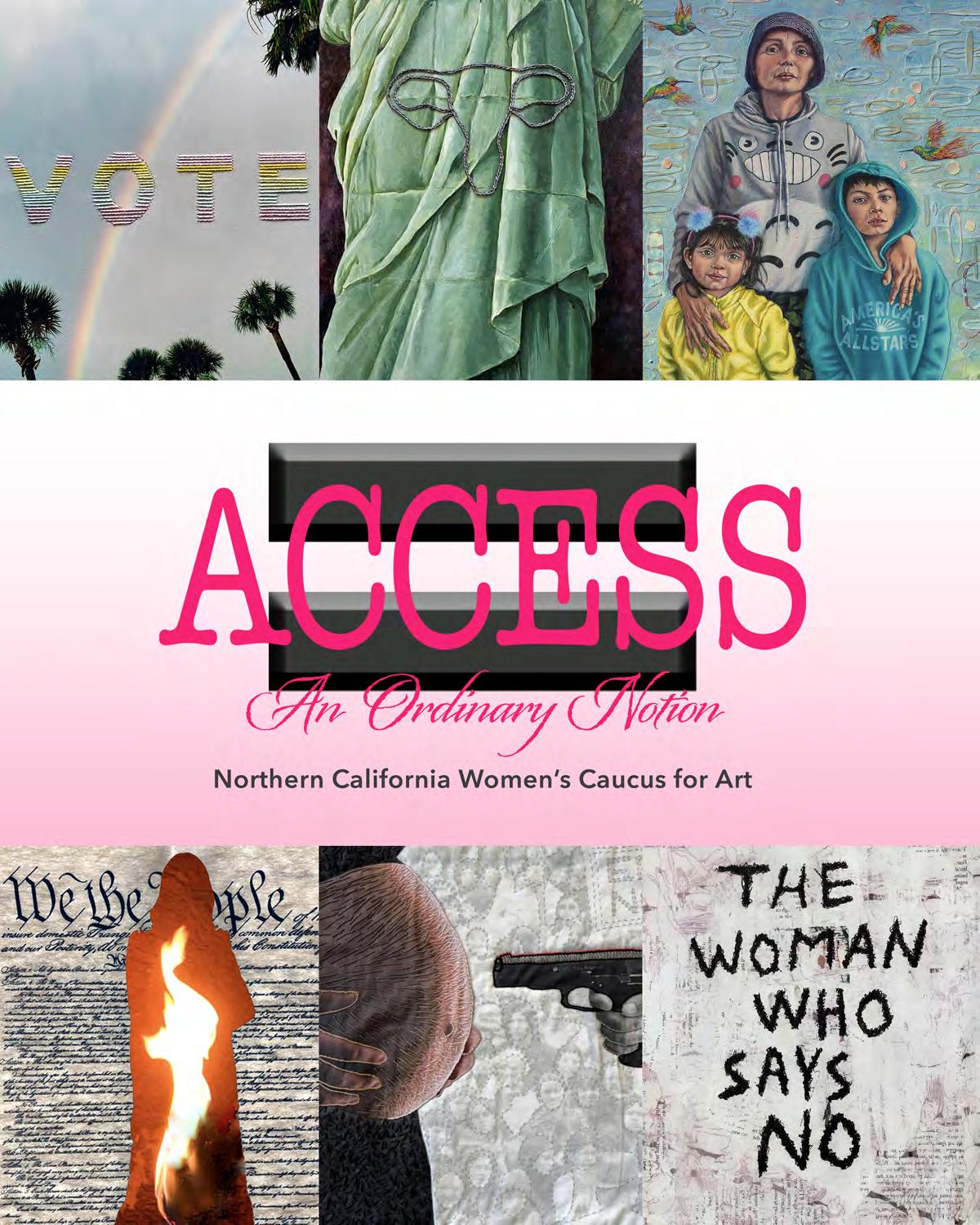
Northern California Women’s Caucus for Art Presents
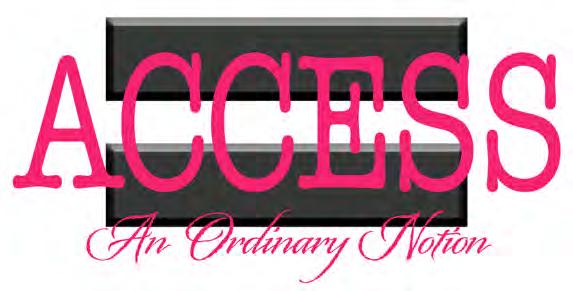
A National Juried Art Exhibition
Inspired by Alice Paul & the Equal Rights Amendment June 15-July 13, 2024 Arc Gallery
San Francisco, California
Jurors: Elizabeth Addison, Karen M. Gutfreund, and Meghan Lewis MacLeod Exhibition Director: Elizabeth Addison
Catalog Design: Elizabeth Addison & Karen M. Gutfreund
Editor: Laura Abrams
Copyright 2024 by Northern California Women’s Caucus for Art. The artists retain sole copyright to the contents of this catalog. No part of it may be reproduced in any form or by any electronic or mechanical means without prior permission in writing.
ISBN: 9798327603325
Table of Contents 2 About NCWCA 3 About Arc Gallery & Studios 4 Exhibition Statement 5 About our Exhibition Partners 6 Note from NCWCA President Priscilla Otani 7 Note from Exhibitions Chair Elizabeth Addison 9 Juror’s Statements 11 Exhibition Artists 12 Alice Paul Honor - Pamela Pitt 14 Artwork & Artist Statements 117 Interviews Section 118 A Conversation with Molly Gonzales, Advocacy Manager, Alice Paul Institute By Sherri Cornett 125 A Conversation with Deborah L Hughes, President & CEO, National Susan B. Anthony Museum & House by Sherri Cornett 132 The ACCESS Curatorial & Writing Team 134 Exhibition Committee 1
About NCWCA

The Northern California Women’s Caucus for Art is a networking organization for women in the arts. NCWCA offers a broad range of events and programs: member forums, exhibitions, mentoring, professional development, art-making, art activism and community. Formed in 1973, NCWCA is a 501(c)(3) nonprofit organization and a chapter of the National Women’s Caucus for Art.
Our Mission is to create community through art, education and social activism.
We are committed to:
• Recognizing the contributions of women in the arts
• Providing women with leadership opportunities and professional development
• Expanding networking and exhibition opportunities for women
• Supporting local, national, and global art activism
• Advocating for equity in the arts for all

www.ncwca.org
2
About Arc Gallery & Studios
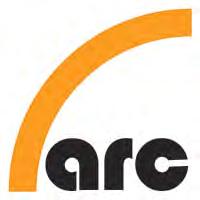
Arc Gallery is dedicated to showcasing and promoting emerging and established artists from around the country whose work embodies both skill and risk-taking. Juried and curated group exhibitions are our primary means of showcasing and discovering artists and to promote high standards of art by continuously exploring new ideas through the visual media in a schedule of national exhibitions. We are delighted that many artists who have submitted works to our juried shows have been given additional exhibition opportunities at Arc and other venues.
Arc Studios & Gallery features a 1,000 square foot art gallery, a smaller project gallery, a fine art consulting office & gallery, ten quality artist studios, and two micro-businesses: Kearny Street Workshop and Cafe Suspiro Coffee Shop.
Arc supports the making of quality art in all media, provides a nurturing environment for artists to create their work, builds a community of artists to encourage exploration of art and promotes appreciation of the visual arts in the city of San Francisco.
1246 Folsom Street
San Francisco, California
www.arc-sf.com
ArcGallerySF@gmail.com
3
Exhibition Statement

ACCESS: An Ordinary Notion, a national juried exhibition, is proud to present artworks that tell individual stories and advocate for social justice and human rights.
Inspired by suffragist Alice Paul who introduced the Equal Rights Amendment in 1923, this potent collection showcases artworks in all media that speak to and illuminate the ongoing conversation around race, women’s and LGBTQIA+ rights, reproductive rights, disparities in global wealth, power, access to food, water, shelter, education, health services, disability access, child and elder care, along with immigration issues, climate change, and criminal (in)justice in the modern world.
It has been 100 years since the introduction of the Equal Rights Amendment (ERA). Alice Paul re-wrote the amendment in 1943 expanding the language to be more in line with recently passed legislation. The amendment states, “Equality of rights under the law shall not be denied or abridged by the United States or by any state on account of sex.”
The ERA has yet to be ratified and the struggle for equal access to fundamental human rights continues. Artwork can act as a conduit in our collective determination for rights that should never be exclusive or for the privileged, but instead are interrelated, interdependent, and indivisible for all. The work in this exhibition is intended to spark meaningful discussion, inspiring us to create visions for a new, more inclusive, and just society.
4
Our Exhibition Partners
The Alice Paul Institute and the Susan B. Anthony Museum & House partnered with NCWCA for this meaningful and timely National Juried Exhibition. We are grateful for their insights and contributions and look forward to ongoing programming around ACCESS: An Ordinary Notion.
The Alice Paul Institute builds contemporary action and intergenerational movement for gender justice through the lens of history and of place.
In 1984, a group of advocates for the Equal Rights Amendment (ERA) decided to ensure that the 1985 centennial of the birth of Alice Paul, the author of the ERA, would be appropriately commemorated. They founded the Alice Paul Centennial Foundation, then created a slate of leadership programs for girls and purchased an important collection of Paul’s papers and artifacts. Eventually, they were also offered the opportunity to acquire Paul’s childhood home, Paulsdale, saving the house and property from development. Today, as the Alice Paul Institute, the organization continues to educate and empower girls and young women to view themselves as leaders, encourage civic engagement, preserve Paulsdale, and advocate for the passage of the ERA which, when enshrined in the U.S. Constitution, will give legal and lasting equal protections to people of all genders.

The National Susan B. Anthony Museum & House interprets the great reformer’s vision and story, preserves and shares her National Historic Landmark home and headquarters, collects and exhibits artifacts related to her life and work, and offers tours and interpretive programs to inspire and challenge individuals to make a positive difference.

5
Note from NCWCA President
Priscilla Otani
Congratulations to the artists whose works were selected for ACCESS: An Ordinary Notion!
The starting point of ACCESS was the Equal Rights Amendment (ERA), introduced in 1923 by Alice Paul. Just a few years before, in 1920, she was among the suffragists who had agitated to give women the right to vote and succeeded in getting the 19th Amendment passed. Unwilling to stop there, she continued her efforts to push for the ERA, which would grant women and men equal footing. Sadly, even to this day ERA remains unratified.
The exhibition, ACCESS, explores gender equality and broader issues around access such as race, LGBTQIA+ rights, reproductive rights, patriarchy, child and elder care, and immigration. Some of the works pay tribute to women who fought for rights, while others share personal struggles, and still others declare grievances against the patriarchy.
This exhibition includes artists in NCWCA, other National Women’s Caucus for Art chapters, and non-member artists from across the country. It also partners with the Alice Paul Institute and the National Susan B. Anthony Museum & House.
Congratulations to Exhibition Chair Elizabeth Addison, Karen M. Gutfreund and the Exhibition Committee for this dynamic show.
Priscilla Otani
NCWCA President
6
Note from Exhibitions Chair Elizabeth Addison
The idea for ACCESS: An Ordinary Notion was sparked during a conversation in late 2023 with my NCWCA Colleague and friend, Pamela Pitt, the East Bay Art Tag* Pod Leader. At our final meeting of the Reflections Art Tag round, Pam discussed how her artwork was inspired by suffragist Alice Paul and that it had been 100 years since Alice originally penned the Equal Rights Amendment in 1923. The artists present took a collective gasp. 100 years!
We recalled our optimism about ratifying the ERA, especially during the 1970’s. Many of us participated in marches and tirelessly canvassed. We could not have foreseen today’s retrograde motion and the erosion of women’s rights, amongst others, in our lifetimes. Should we be disheartened, angry, or motivated to action? I suggested that we could expand upon this concept with an NCWCA exhibit—creating an empowering and motivating show with accompanying events and actionable items. This feels especially urgent considering the current and ongoing retraction of abortion rights, reproductive autonomy, voters’ rights, and much, much more affecting us in real time.
ACCESS: An Ordinary Notion exhibition grew to encompass a broad range of equity and equal access issues including conversations around race, women’s and LGBTQIA+ rights, reproductive rights, disparities in global wealth, power, access to food, water, shelter, education, health services, disability access, child and elder care, along with immigration issues, climate change, and criminal (in) justice in the modern world.
I dug deep into Alice Paul’s remarkable history and background. Her vision was “the ordinary notion that women and men should be equal partners in society.” However, nothing about Alice was ordinary.** My next step involved a cold call to the experts at the Alice Paul Institute in New Jersey. After receiving ACCESS’ exhibition statement and prospectus, their Advocacy Director, Molly Gonzales, replied with enthusiasm. Molly agreed to partner with us and develop future collaborative programs. Soon after, a personal connection introduced me to Deborah L. Hughes, Susan B. Anthony House & Museum’s President and CEO. Likewise, she was excited about ACCESS, noted our organizations’ shared goals, and agreed to partner with NCWCA. Both Molly Gonzales and Deborah L. Hughes
* Art Tag is one of NCWCA’s most popular collaborative creative activities. To learn more, www. ncwca.org/art-tag.html
** Alice Paul was the architect of some of the most outstanding political achievements on behalf of women in the 20th century. Born on January 11, 1885 to Quaker parents in Mount Laurel, New Jersey, Alice Paul dedicated her life to the single cause of securing equal rights for all. To learn more, www.alicepaul.org/about-alice-paul/
7
were interviewed by curator Sherri Cornett for this project. Their insightful interviews are included in this catalog. As one of NCWCA’s goals includes creating and nurturing collaborative connections with outside organizations, we couldn’t be more delighted by these two new relationships.
Meanwhile, Pamela Pitt went on to create an artwork series about Alice Paul and the ERA, titled The Equal Rights Amendment series. Pam’s germinal role for this exhibit is recognized with the Alice Paul Honor featuring works from this series.
Early in this process, Karen M. Gutfreund enthusiastically signed on to be co-curator. Karen was an amazing mentor when I was new to the NCWCA Exhibitions Chair. She has enriched ACCESS: An Ordinary Notion with her deep feminist/activist roots and curatorial professionalism. She truly holds up half the sky!
I extend my deepest gratitude to the artists of ACCESS: An Ordinary Notion. Each and every one of this collection’s artworks demands a response… and that’s just what is needed! Additionally, I thank Meghan Lewis MacLeod, ACCESS’ assistant curator and juror, the NCWCA Board, Sherri Cornett for her insightful interviews, and our exhibition committee including: Laura Abrams, Chandrika Marla, Sheila Metcalf-Tobin, Priscilla Otani, Pamela Pitt, Mary Shisler, and Tanya Wilkinson. This ambitious exhibition couldn’t have come together without you. It genuinely takes a village to affect change and our collective voices matter. My hope is that ACCESS: An Ordinary Notion will spark meaningful discussions and help us find inspiration in the present moment. Art has the power to do that.
Elizabeth
Addison
NCWCA Exhibitions Chair
May 2024
8
Juror’s Statements
Elizabeth Addison MFA Co-curator, Juror
I am inspired by the powerful works featured in ACCESS: An Ordinary Notion! Each submitted artwork demanded a response— initiating exploration, conversation, or a call to action. Out of hundreds of excellent artworks, choosing approximately 60 became a painful process of elimination. This made the jurying task one of my most challenging. To create a visually and thematically cohesive collection, I leaned into works with the following qualities: adherence to—or unique interpretations of—the exhibit’s themes, visual impact, strength of message, use of materials, and craftpersonship.
I want to express my profound appreciation for the hundreds of submitting artists—for sharing their equal rights/equity artworks, fears, and hopes. I also extend my deepest gratitude to my cocurator, Karen M. Gutfreund, our assistant curator and juror, Meghan Lewis MacLeod, and to Arc Gallery and Studios for the generous donation of their gallery space.
I believe ACCESS: An Ordinary Notion exhibition presents both timely and timeless expressions of how far equal rights have come, of the path forward, and the tenuousness of the present. I hope you are as amazed and motivated by these works as I was in selecting them.
Karen M. Gutfreund Co-curator, Juror
When we were working on the prospectus for ACCESS: An Ordinary Notion, I thought “hum, just ordinary notions, imagine that...” considering with the war on women, global conflict, our environment in peril, and the divide between the haves and the have-not—these challenging times are anything but ordinary. This exhibition is important to raise awareness about the struggles, achievements, and ongoing issues related to women’s rights and human rights more broadly. It gives a platform for voices that are often marginalized or silenced, allowing them to share their stories, experiences, and perspectives. The work in ACCESS will educate the public about historical and contemporary challenges faced by women and marginalized groups, in an effort to create positive change.
I was moved and delighted by the extraordinary works showcased in ACCESS. The collection provides valuable insights into how
9
far society has come and how far it still needs to go in terms of achieving full equality and justice for all. The artists inspire me and are empowering by showing compelling, heartfelt and sincere examples of activism, resilience, and progress. My hope is that our exhibition will inspire us all to become agents of change in our own communities and to take action and work towards a more just and equitable society. I have much gratitude to the artists for sharing their stories, to my curatorial partner Elizabeth Addison and NCWCA for creating the exhibition, and to Arc Gallery and Studios for generously hosting it.
Meghan Lewis MacLeod PH.D.
Assistant Curator, Juror
“Vote! It’s not illegal yet!” reads the bumper sticker stuck to a brandnew electric vehicle parked on the former all-women’s-Mill’s Collegecampus-turned-Northeastern University. This graphic stopped me in my tracks and elicited a swift need to reflect on the reality of where fairness and inclusion is clearly—yet not inevitably—heading. It further spurred me to consider access in the actual place where I stood, to look closer into the herstory of Mills and women’s colleges. I learned that only sixty years ago there were 230 women’s colleges in the US and today maybe 24 still remain. Who voted on this rapid change? And who did not or could not?
Similarly, artworks that inherently demonstrated the power to elicit a palpable immediacy for political reflection, or that sparked empowered inspiration, or compelled a deeper societal analysis— works that ultimately invoked the furthering of feminist fomentation— were fundamental forces guiding my selections for this exhibit. The artworks showcased become vehicles through which we can visually alchemize a viable, progressively-renewed, ecoegalitarian-driven, and socially sustainable future.
It was an honor to witness the enormous breadth of creative talent and raw passion poured into each piece submitted. I remain beyond inspired by the fierce, justice-forward fortitude and feminist focus of all the artists and the artwork of ACCESS.
10
Exhibition Artists
Alice Paul Honor
Pamela Pitt, The ERA Series
Featured Gallery Artists
Wendy Ackrell, Susan Amorde, Salma Arastu, Carol Benioff, Jo Ann Block, Lorraine Bonner, Cynthia Brannvall, Mague Calanche, Marie Cameron, Gwendolen Cates, Joanne Chase-Mattillo, Sonja Czekalski, Emilie Dashe, Adeola Davies-Aiyeloja, Nimisha Doongarwal, Jessica Duby, Myra Eastman, Sally Edelstein, Somaya Etemad, Theresa Giammattei, Stacey Gregory, Tali Grinshpan, Ellen Gust, Deborah Hirshfield, Judith Hopkins, Sarah Horowitz, Quinn Keck, Kathleen King, Grace Kresback, Krisztina Lazar, Karen LeCocq, Billi London-Gray, Annie Marini-Genzon, Elizabeth Medrano, Shanna Merola, Rosemary Meza-DesPlas, Laura Morrison, Kailin Nielsen, Priscilla Otani, Vida Pavesich, Elaine Pawlowicz, Barbara Pollak-Lewis, Remedios Rapoport, Clara Jeanne Reed, Sondra Schwetman, Victoria Senn, Nina Sidneva, Barbara Sizelove, Anne Skaug, Adrienne Sloane, Deena Smith, Irene Suh, Rachel Tirosh, Li Turner, Winnie van der Rijn, Diane Warner-Wang, Mira M White, and Tanya Wilkinson
Online Exhibition Artists
Laura Abrams, Minoo Amini, Kelly Burke, Saranya Chandrasekaran, Christine Cianci, Isabella Covert, Shannon O’Neill Creighton, Paula deJoie, Michelle Echenique, Sally Edelstein, Marguerite Elliot, Corinne Farago, Theresa Giammattei, Rinat Goren, Laura Green, Ellen Gust, Kelly Hartigan Goldstein, Hedy Herrera, Kelsey Jones, Kay Kang, Kayla Kirsch, Shannon Knowlton, Kristina Lenzi, Roberta Levitow, Suki Liebow, Penny Mateer, Juliet Mevi, Cristin Millett, Ellen November, Elaine Pawlowicz, Laura Phelps Rogers, Pamela Pitt, Larraine Seiden, Durba Sen, Michele Serchuk, Mary Shisler, Dobee Snowber, Fleur Spolidor, Eliza Thomas, Hwei-Li Tsao, Lin Wei, and Jane Zich
11
THE ALICE PAUL HONOR:

ERA Yes
Mixed media collage with note from the artist’s mother 16 x 12 inches, 2024, *gallery
The jurors of ACCESS: An Ordinary Notion are delighted to present Pamela Pitt with “The Alice Paul Honor” for her mixed media series titled Putting Women in the Constitution. Pam’s professional background has profoundly enriched her art activism. While in law school, she started the Women Law Students group with a friend and put on a debate for the ERA. As she was completing her studies, the National Women’s Political Caucus had its first ever national convention in Houston where she lived. Energized by this, she became seriously involved with the Harris County Women’s Political Caucus. She also became one of the representatives to the Texas Women’s Political Caucus in Austin. The rest, as one might say, is history! This dynamic body of work about the Equal Rights Amendment and its author, Alice Paul, embodies ACCESS: An Ordinary Notion’s spirit.
Elizabeth Addison, Karen M. Gutfreund, Meghan Lewis MacLeod Jurors
12
PAMELA PITT
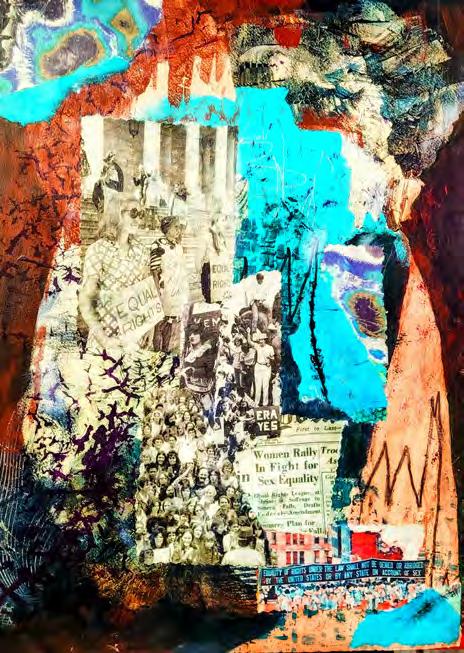
Critical Mass
Mixed media collage
18 x 12 inches, 2024, *gallery
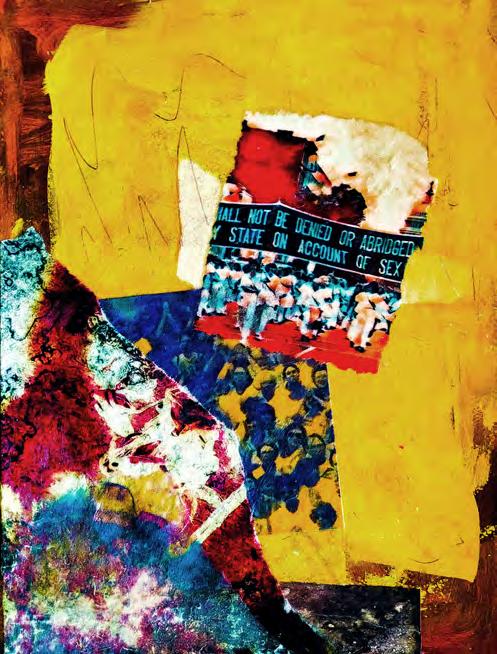
On the Way to the Future
Mixed media collage
16 x 12 inches, 2024, *gallery
Putting Women in the Constitution is a series inspired by Alice Paul’s 1923 Equal Rights Amendment draft. I’m excited that my inspiration sparked the ACCESS: An Ordinary Notion exhibition. My series comprises over a dozen—and growing—mixed media collages. ERA Yes states that a constitutional amendment is required as a powerful tool to enforce women’s rights. I am sentimental about this piece because it includes a page from my mother’s autograph book. Critical Mass implores us to demand that every state ratify the Equal Rights Amendment. Finally, On the Way to the Future shouts the 19th amendment, “The right of citizens of the United States to vote shall not be denied or abridged by the United States or by any State on account of sex.” Introduced to Congress in 1878, it was finally certified in 1920. The ERA still has not been ratified by enough states to enshrine it into the constitution.
Pamela Pitt
13
LAURA ABRAMS
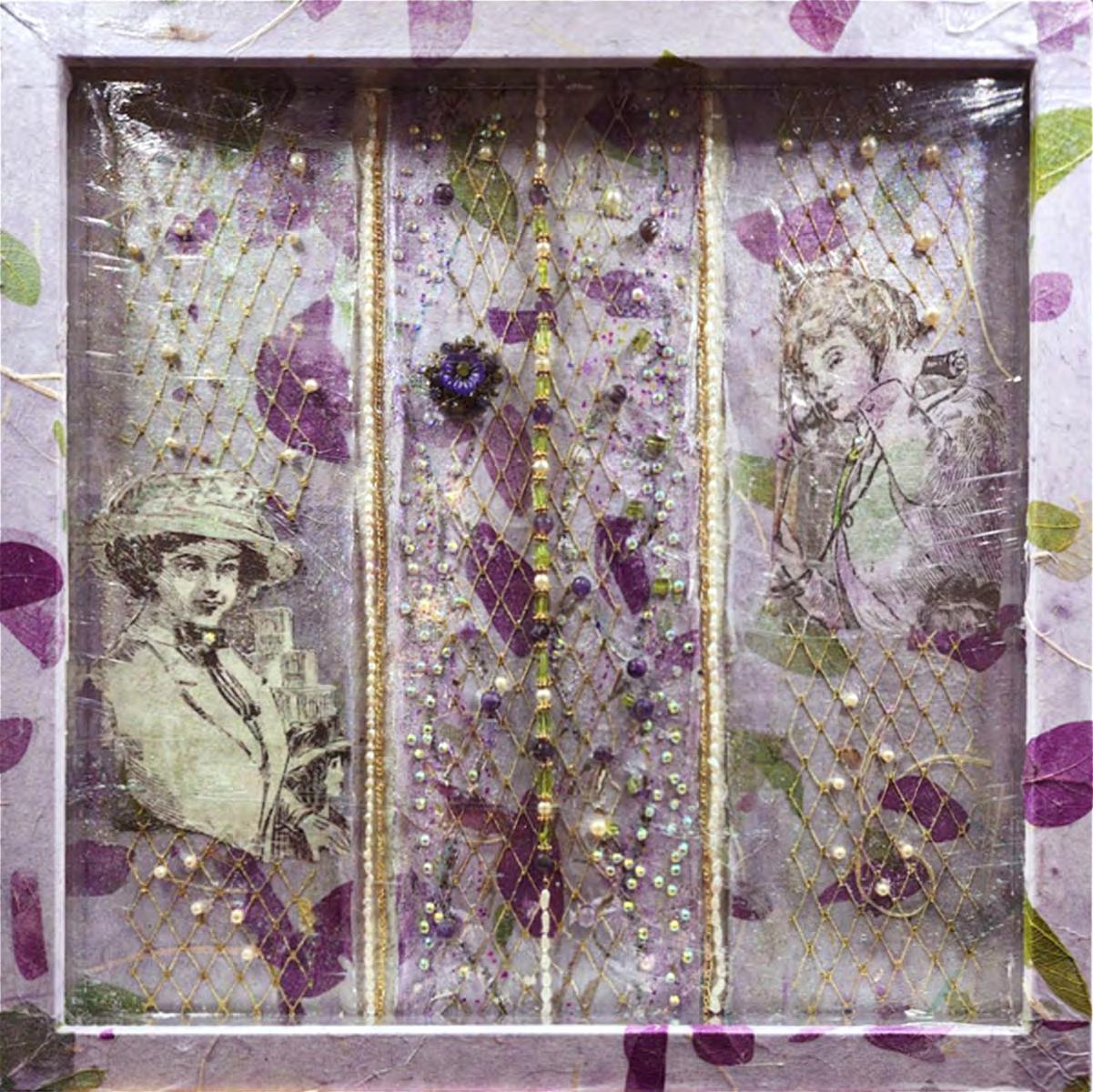
Clandestine Communications
Mixed media: paper, lace, found images, gemstones, pearls, gold chain, and acrylic paint
13 x 13 inches, 2024, *online
Clandestine Communications depicts suffragettes who braved the law and defamation for the vote. Here, ladies from an old recipe book work for the cause, even as they conduct their daily lives. Swirled glazing denotes the passage of time and the unbroken glass ceiling, while gemstones are significant as women signaled their views via jewelry; peridot and amethyst with pearls (England) and gold (America). Their ghosts share our demand for equal rights, still not constitutionally recognized.
laura-abrams.com, Oakland, California
14
WENDY ACKRELL
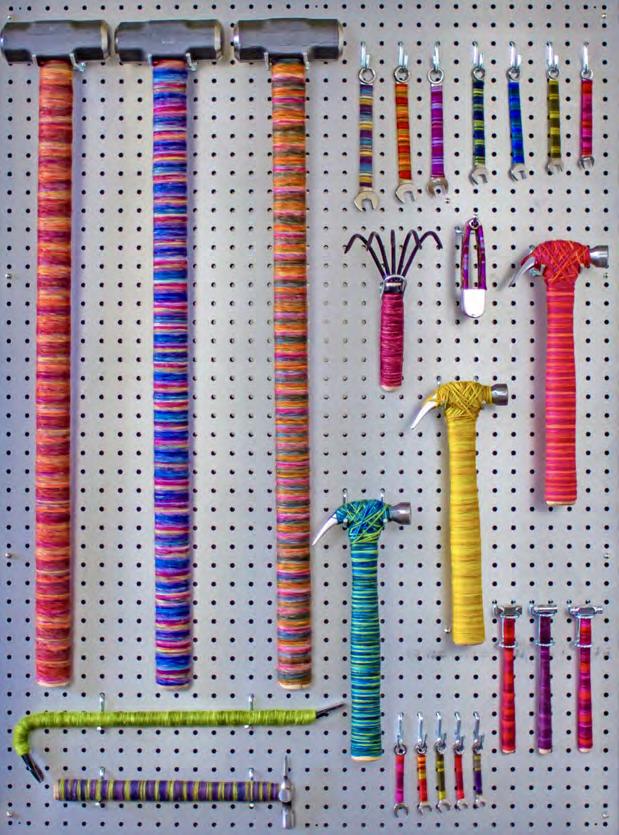
Tools, in Sheep’s Clothing
Wool wrapped tools Installation variable, 2019, *gallery
I turn tools into art because they connect me with my grandmother, whose bold necklaces and spirit I inherited. My grandmother was a young attorney in the early 1940s. She gave up this work she absolutely loved to become a wife and mother, standard practice in those times. As I create sculptural forms out of quotidian and overlooked objects, I remember what she lost—may my own daughter and all women know limitless freedom.
wendyackrell.com, San Francisco, California
15
SUSAN AMORDE
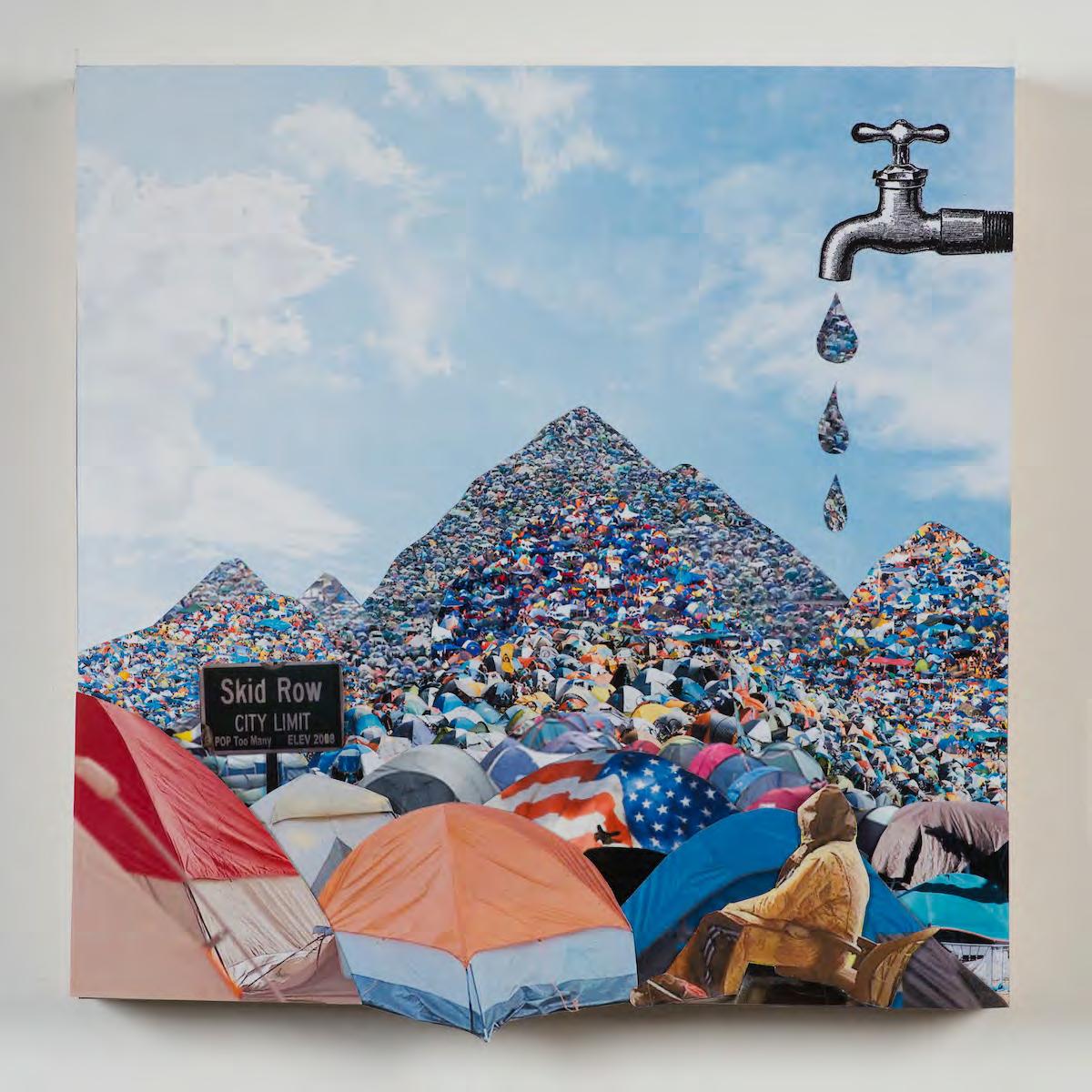
Population, Too Many
Paper collage on wood panel 12 x 12 x 1 7/8 inches, 2018, *gallery
The theme of this exhibition Access: An Ordinary Notion is not always ordinary. Unhoused individuals do not have ordinary access or finances for a place to live and are too often relegated to the streets as shown in the work Population: Too Many. Utilizing a leaky faucet as a metaphor for my voice, I show an unending tent city illustrating the immense world-wide housing crisis resulting from widening economic inequality, climate crisis and wars.
susanamorde.com, Los Angeles, California
16
SALMA ARASTU
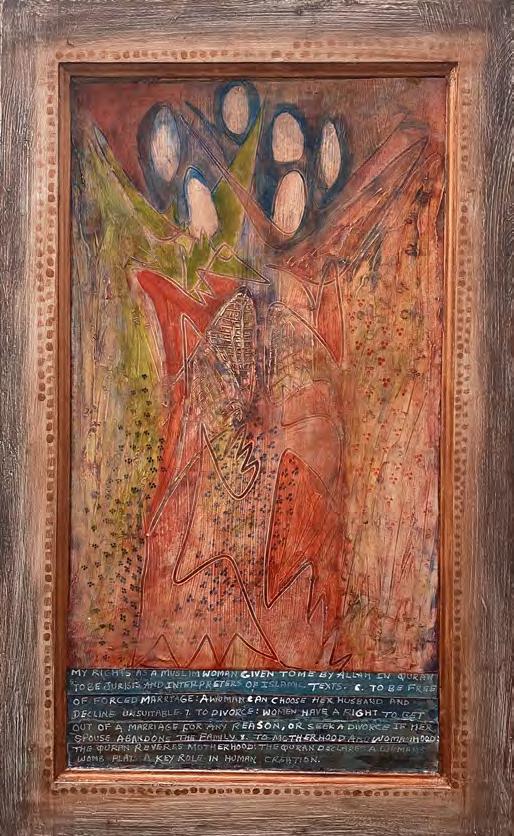
My Rights as a Muslim Woman-II
Acrylics, pen and ink, and paper 30 x 19 inches, 2024, *gallery
I am inspired to create a series whereas I can proclaim Muslim women rights bestowed upon them from God in the Sacred Book Quran. Over the centuries the dominant gender has reverted these rights and created a misconception about Muslim women’s rights. In this painting, I have tried to present jubilant group of women with scarves on and raised hands announcing that women can interpret holy text and uphold justice as jurists, or magistrates and a woman can choose her husband and decline an unsuitable man.
salmaarastu.com, Berkeley, California
17
CAROL BENIOFF

Canceled
Color pencil and tempera on paper 30 x 20 inches, 2023, *gallery
My works are created from memory. I explore how societal pressure, anxiety, displacement, and upheaval mark our psyche and physical presence. As women, how do cultural expectations affect our well being? What are the costs of not being seen or your voice not heard? Will the constant small wounds immobilize you? How do the inequities of power play out in one’s life choices, opportunities, and place in society. There are no clear answers.
carolbenioff.com, Berkeley, California
18
JO ANN BLOCK

Phenomena of The Fierce: Audre Lorde 1934-1992
Glossy photos, reprinted photos, specialty paper, cake decoration confections, acrylic paint 16 x 12 inches, 2022, *gallery
Phenomena of The Fierce is a series of intimate mixed media collages of older, butch women who have achieved public recognition. The works imagine a personal source of strength from which their fortitude springs. Each figure is paired with a symbol representing a life force. The images represent self-assured butches of a bygone era who defiantly fended for their rights. Here, Audre Lorde, 1934-1992, is immortalized as a body of stone, rendering her heroic and timeless.
joannblock.com, Ventura, California
19
LORRAINE BONNER
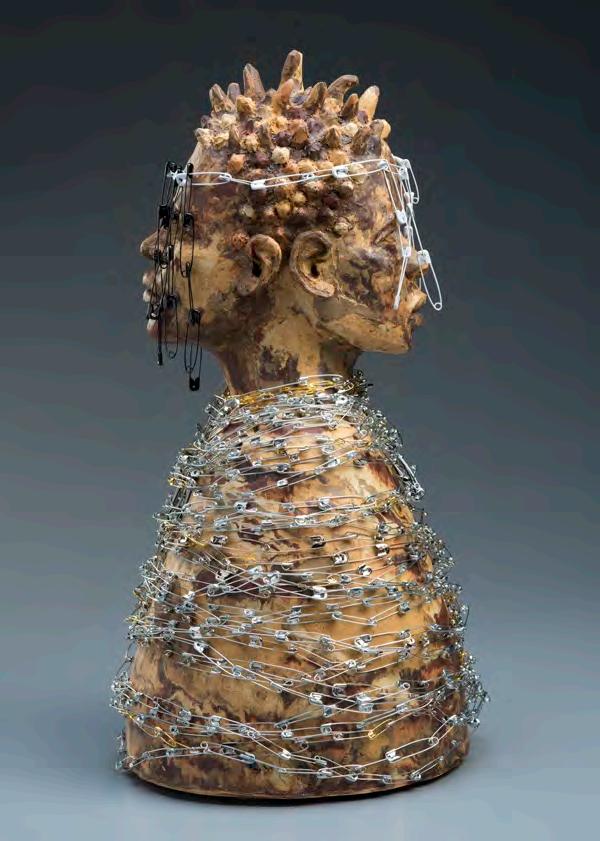
Are We Safe Yet?
Clay, safety pins
17 x 10 x 8 inches, 2016, *gallery
After BREXIT, there was an upsurge of hate attacks on immigrants, Muslims and people of color in Britain. The normal human beings of Britain began a campaign of wearing a safety pin on their clothing to show solidarity with targeted people, and indicate that they were safe allies. How many safety pins until we are safe?
lorrainebonner.com, Oakland, California
20
CYNTHIA BRANNVALL
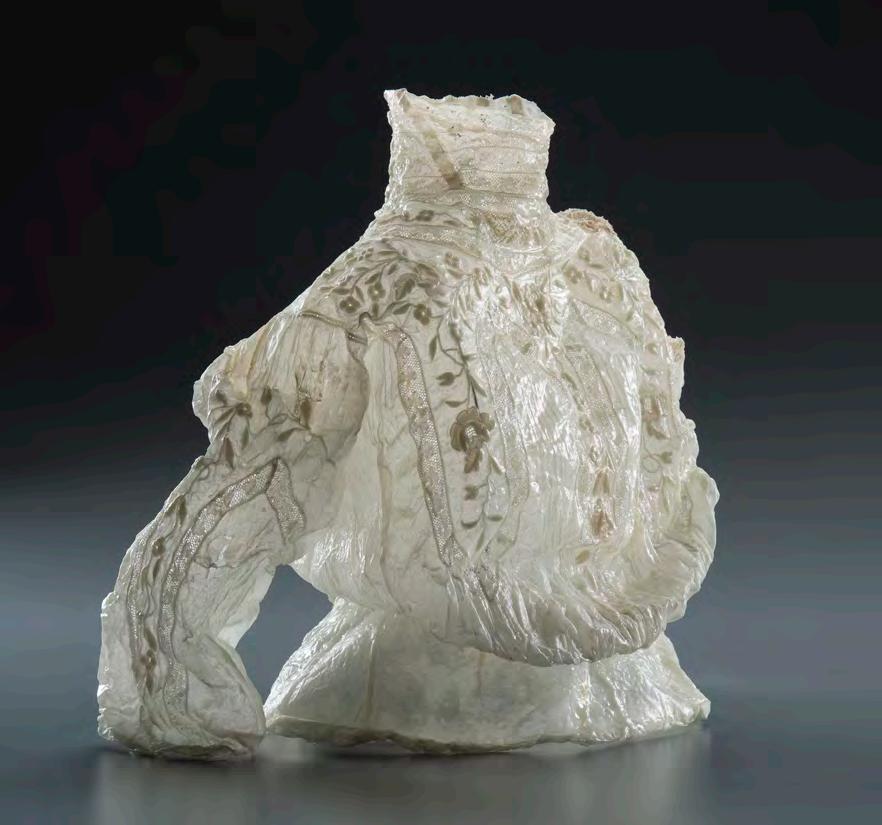
Frances Ellen Watkins Harper
19th century blouse, beeswax, damar, and resin
17 x 20 x 14 inches, 2020-21, *gallery
Frances Ellen Watkins Harper is a sculptural historical artifact created from an authentic 19th century blouse. This blouse was sculpted and preserved with beeswax, damar, resin, and acrylic paint to express the memory of its wearer, Francis Ellen Watkins Harper, a black abolitionist and women’s suffrage leader. She was also an author and poet focusing on issues of slavery, gender, and racial discrimination— challenging American Democracy to fulfill its promise of equality and justice for all.
cynthiabrannvall.com, Berkeley, California
21
KELLY BURKE
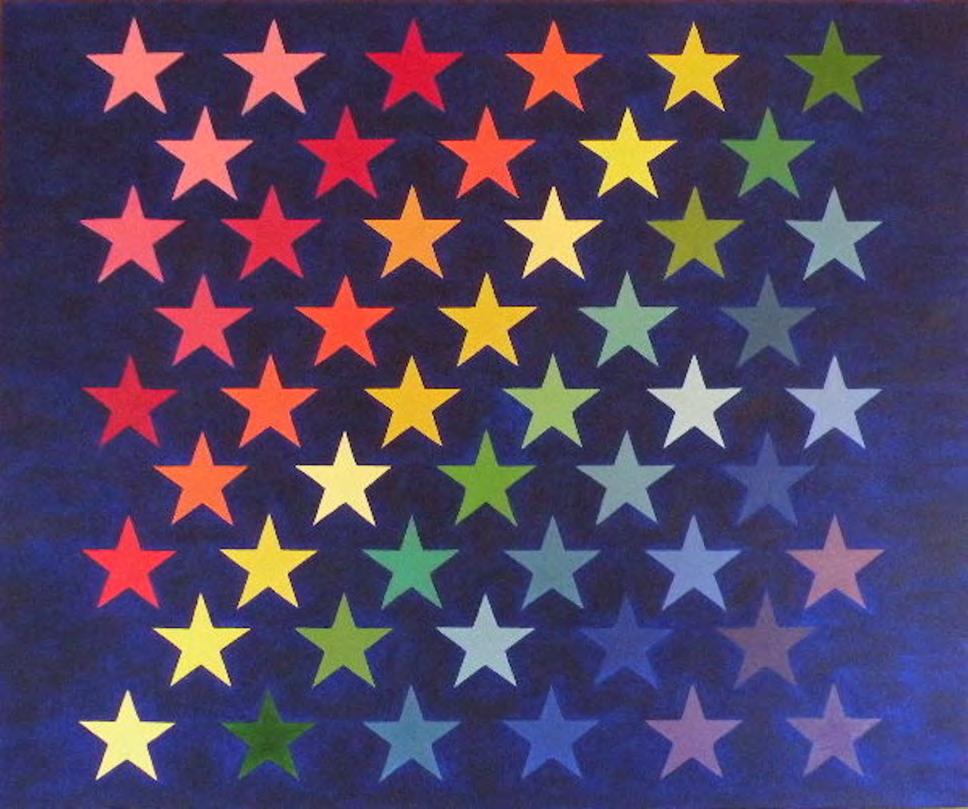
States of Being IV: LGBTQ+
Oil on canvas
29 x 35 inches, 2016, *online
Inspired by the original colours of the 8-striped Rainbow flag, I painted the US flag’s 50 stars in various hues to represent LGBTQ+ diversity, including myself as a bi-racial black lesbian. They also visually represent our presence throughout all 50 states. The three pink stars in the upper left-hand corner represent the pink triangle that designated gay prisoners in the Holocaust’s concentration camps. They remind us that we still need to protect human rights today.
kellyburke-artworks.com, Minneapolis, Minnesota
22
MAGUE CALANCHE
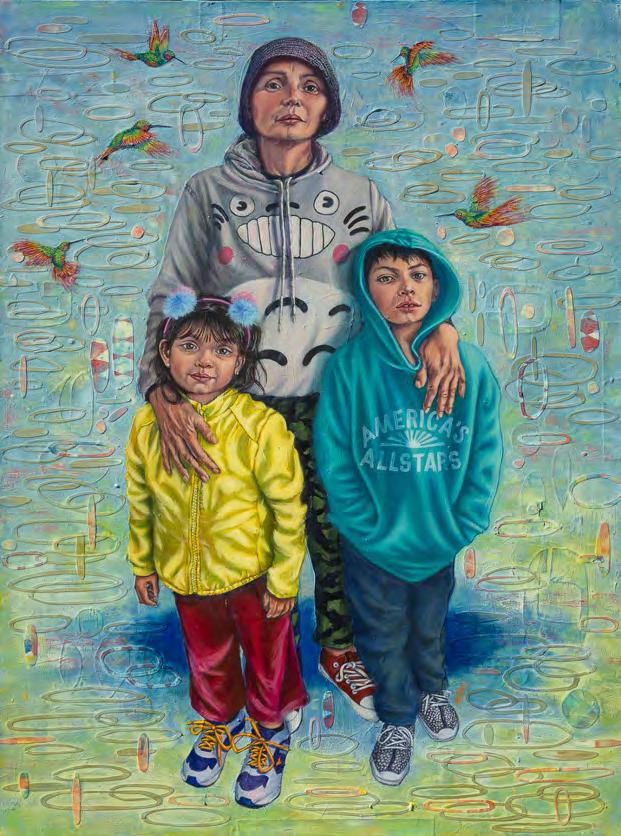
Immigrantes, The American Allstars
MIxed media painting: acrylic, collage, wax crayon, oil on canvas 36 x 48 x 1.75 inches, 2023, *gallery
I met the Olartes, a Venezuelan family, just before the pandemic in February 2020 while working in a refugee camp of over 2,000 immigrants in Matamoros, Mexico. They sought a better life for their children and freedom from tyranny and oppression. Immigrants leave their home countries because of the injustices brought about by global wealth disparities, only to discover structural racism with low minimum wages and insufficient health and safety protections. Their resiliency and persistence prevail.
maguecalanche.com, San Francisco, California
23
MARIE CAMERON
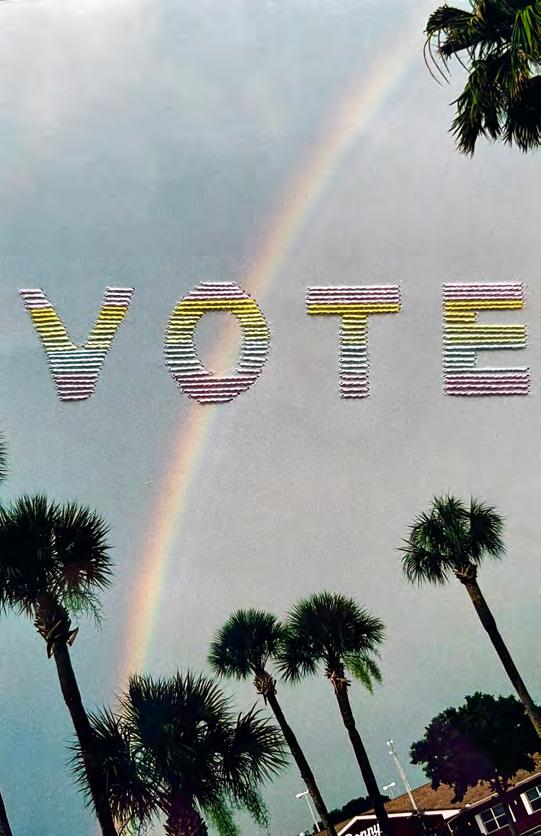
Rainbow Vote
Silk thread on found photograph 6 x 4 inches / 12 x 10 inches framed, 2022, *gallery
I embroidered the word “VOTE” onto a found, vintage photograph with rainbow hued silk threads during the last presidential election, celebrating both our right to vote and underlining how important it is for all of us to show up in our glorious diversity. Now here we go again with even more on the line!
mariecameronstudio.com, Los Gatos, California
24
GWENDOLEN CATES

Sisters
Photographic paper 16 x 16 inches, 2000, *gallery
I photographed these Crow/Cheyenne sisters in Montana. Their greatgrandmothers became U.S. citizens in 1924, four years after the 19th Amendment was ratified. The oppression of matriarchal Indigenous cultures has been consistent with patriarchal goals. My Quaker ancestors were active in the suffrage movement, which was inspired and influenced by Haudenosaunee women. Women have always been on the frontlines of Indigenous movements for a more equitable world: human, cultural, economic, and political rights, and climate justice.
gwendolencates.com, New York, New York
25
SARANYA CHANDRASEKARAN

Read Between the Lines 2023, Collage, 15 x 15 inches, 2023, *online
Influenced by dendrochronology and the silent stories shared by nature to humankind, I delve into the intricate relationship between our planet’s health and societal well-being in this art work with a focus on diminishing forests and the impact of climate change. Through my work, I urge viewers to acknowledge the interconnectedness of global crises and advocate for equitable access to resources, fostering a sustainable future.
@bleumayil, Milpitas, California
26
JOANNE CHASE-MATTILLO

Water Ballet - Free Fall
Photograph on museum wrapped canvas 24 x 20 inches, 2024, *gallery
Within the photograph Water Ballet - Free Fall the female subject drifts blindly to the bottom of the water tank. She is overcome with stress and life responsibilities and seems to surrender at least temporarily to a fate she believes, in the moment, life has given her.
joannechasemattillo.com, North Hollywood, California
27
CHRISTINE CIANCI
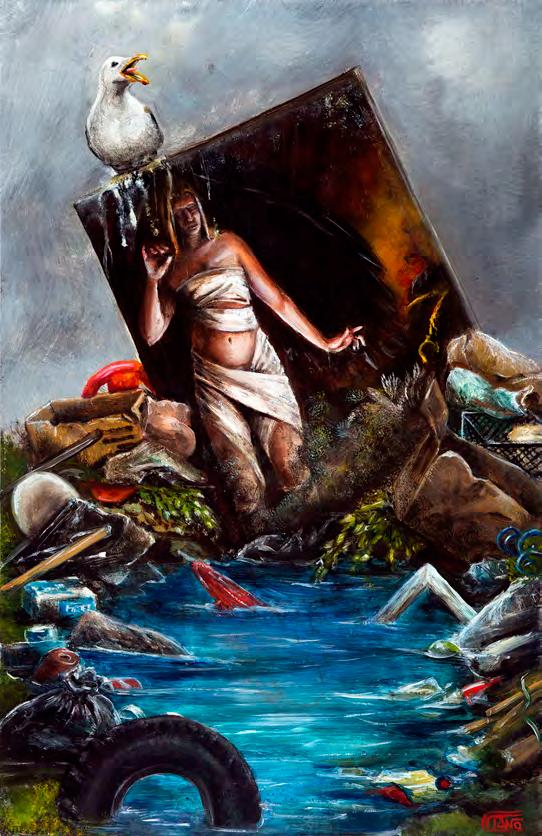
Carbon Footprint
Oils on wood panel
20.5 x 13 inches, 2022, *online
In Carbon Footprint, I reflect upon my own carbon footprint as an artist—but also as an aging artist, depict what could happen to my work, after I’m gone. Most artists are not privileged to have all their work hanging in permanent collections. This is a meta piece showing one of my own paintings in one possible future for it, in a world where not all artists have the same ACCESS. A rather grim whimsy.
ccianciart.com, San Francisco, California
28
ISABELLA COVERT

Flesh 2
Oil on canvas
12 x 12 inches, 2024, *online
This piece comments on the mental complexities of people who can become pregnant living in Post-Roe V. Wade America, highlighting the anxieties experienced within our bodies. This concept of sustained anxiety reflects proposed legislation in the overwhelm of the Information Age, referencing the connotations between women’s emotional responses and hysteria. The brushstrokes become abject masses that resemble human innards. The vibrant color palettes ooze with the visceral nature of both mental and politically allegorical maiming.
isabellacovert46.wixsite.com, Savannah, Georgia
29
SHANNON O’NEILL CREIGHTON

Hannah, The Water
4x5 Fujichrome digital scan, text 16 x 20 inches, 2021, *online
These images are part of a portrait and oral history project, Queer Belonging. The project invited LGBTQIA+ individuals to select a geographical place to be photographed within which represented a felt-sense of belonging and significance to them. While visiting this chosen location, participants and myself engaged in a dialog exploring the intersection of identity, place, and belonging. The project brings forth unseen experiences held within landscape and offer counter-narratives to heteronormativity.
shannononeillcreighton.com, Sebastopol, California
30
SHANNON O’NEILL CREIGHTON
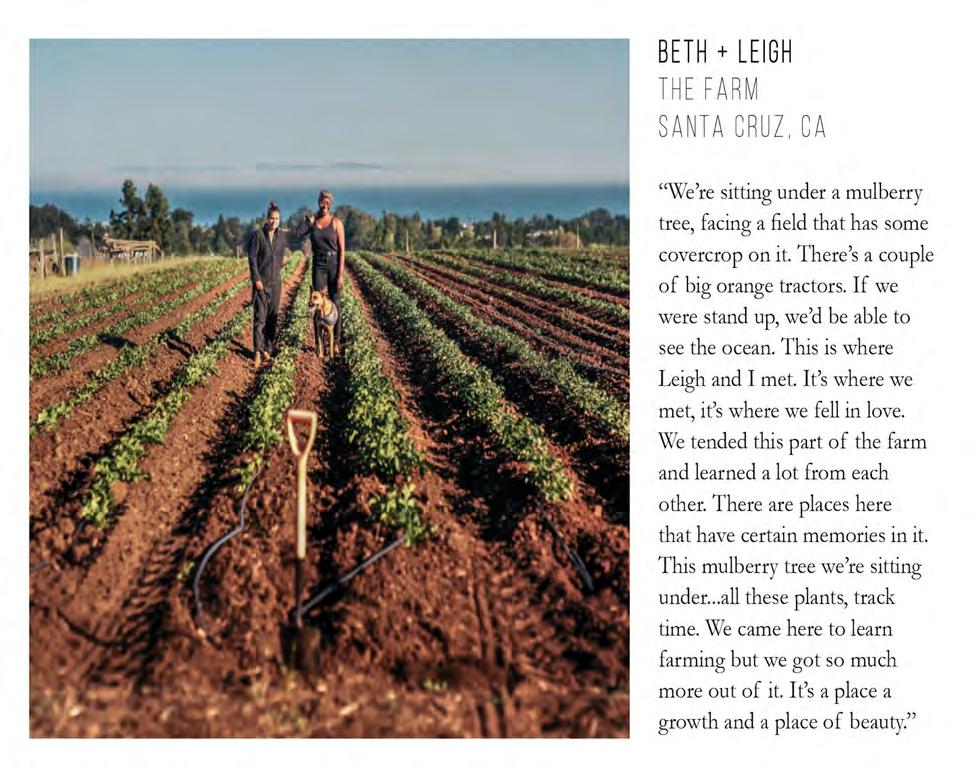
Beth & Leigh, The Farm
4x5 Fujichrome digital scan, text 16 x 20 inches each, 2021, *online
These images are part of a portrait and oral history project, Queer Belonging. The project invited LGBTQIA+ individuals to select a geographical place to be photographed within which represented a felt-sense of belonging and significance to them. While visiting this chosen location, participants and myself engaged in a dialog exploring the intersection of identity, place, and belonging. The project brings forth unseen experiences held within landscape and offer counter-narratives to heteronormativity.
shannononeillcreighton.com, Sebastopol, California
31
SONJA CZEKALSKI
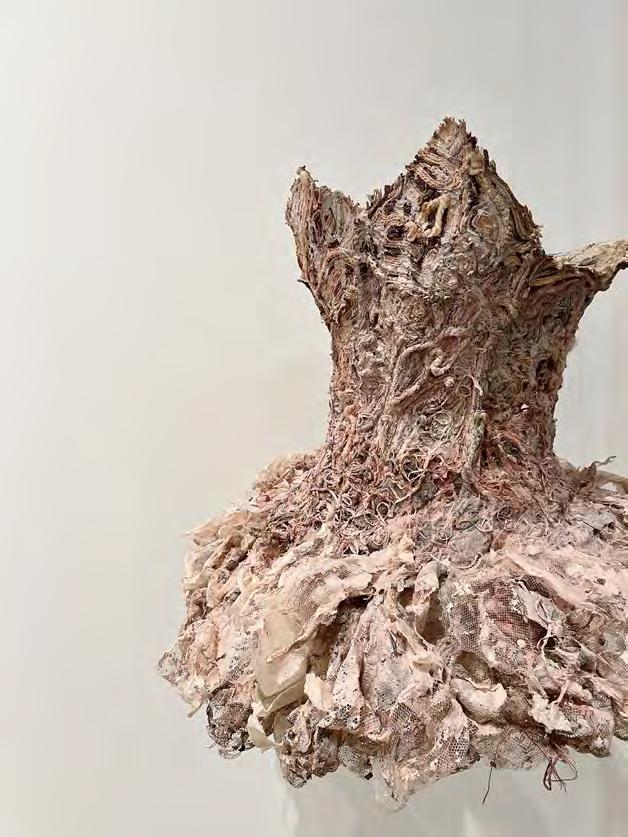
Tiny Dancer Dress
Handmade gampi paper fabric, steel wire, tulle, yarn, embroidery thread, adhesive, flax, abaca 26 x 24 x 27 inches, 2020, *gallery
I am an artist driven to tell women’s stories. The Tiny Dancer Dress stands as a garment exposing my experience of striving for perfection. The garment is made to my size, yet constructed with steel wire making it impossible to fit into. Tiny Dancer Dress is a symbolic story of a shared experience. She creates awareness about the brutality of feminine expectations and stereotypes while demanding respect for women’s work and power.
sonjaczekalski.wixsite.com, Cranston, Rhode Island
32
EMILIE DASHE

Boobelah Riding Bus
Oil on canvas
30 x 30 inches, 2023, *gallery
Boobelah Riding Bus delves into the nuances of growing up in the city and undergoing a profound shift in self-awareness as a young woman. The headless figure symbolizes a heightened consciousness in regards to one’s body when navigating public spaces, and in a broader sense speaks to the historical power dynamics within female portraiture. With a gaze that intensifies, it challenges viewers to confront their own discomfort and perceptions.
emiliedashe.com, San Francisco, California
33
ADEOLA DAVIES-AIYELOJA
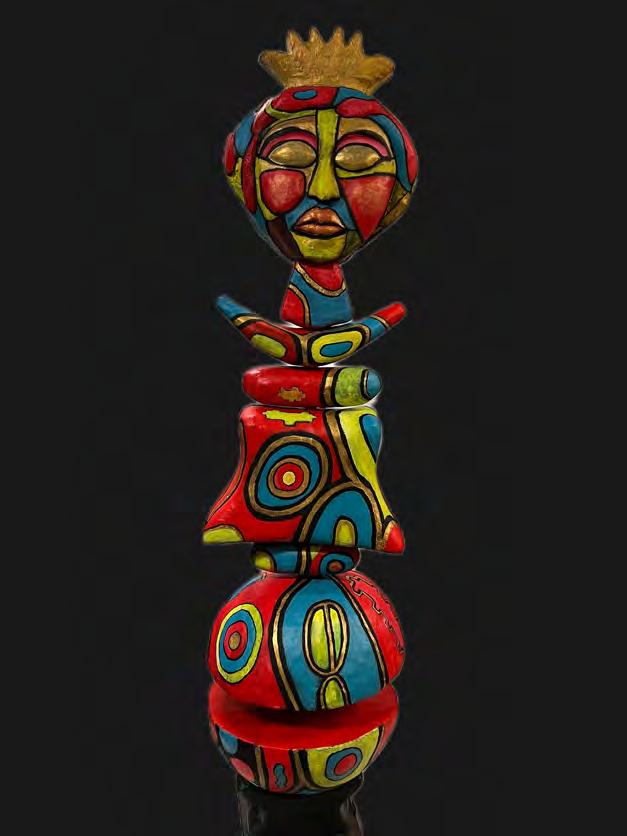
Mother Earth, She Wears Her Golden Crown
Acrylics, cement, pvc, rebar steel, polystyrene, and mesh
77 x 18 x 18 inches, 2023, *gallery
Mother Earth, She Wears Her Golden Crown, channels the universal essence of femininity—embodying the struggles and disparities faced by women, especially immigrants like myself. This sculpture stands as a tribute to resilience and a call for social justice, highlighting the unequal access to wealth, shelter, education, health, and human rights. Through art, I amplify the voices of the marginalized, weaving their stories into the fabric of our shared humanity.
adeolastudio.org, Loma Linda, California
34
PAULA DEJOIE
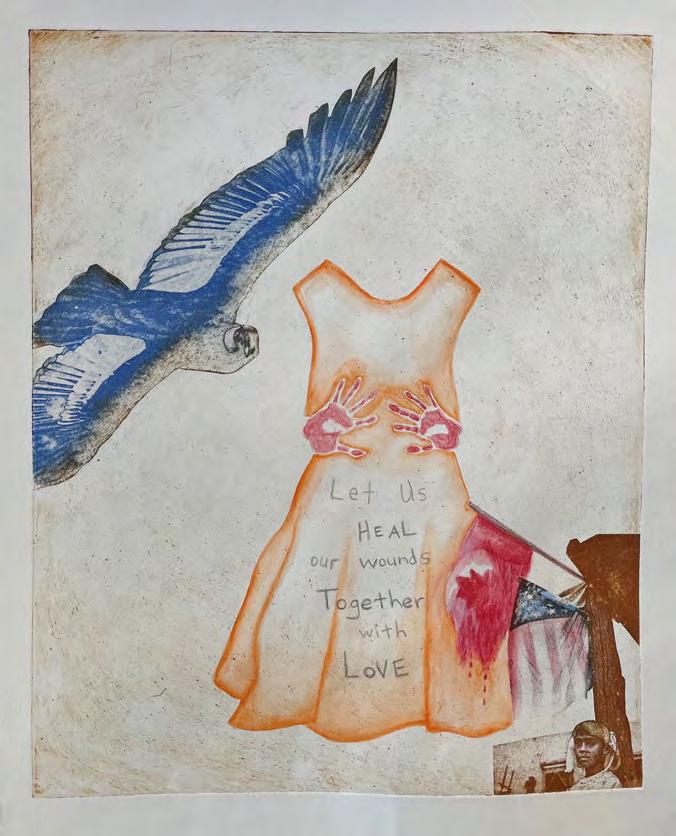
See Us
Original etching, watercolor paints 24 x 18 inches, 2022, *online
I created See Us to support an investigation into the missing and murdered Indigenous women and girls in Canada. However, the title easily describes the state of Black women during the suffragist movement in the United States. Black women were not initially welcomed or included. For the most part, we had to fight for ourselves. Sadly, we are still fighting to be seen in many different spaces throughout this stolen country, in this desecrated land.
pauladejoie.com, Berkeley, California
35
NIMISHA DOONGARWAL
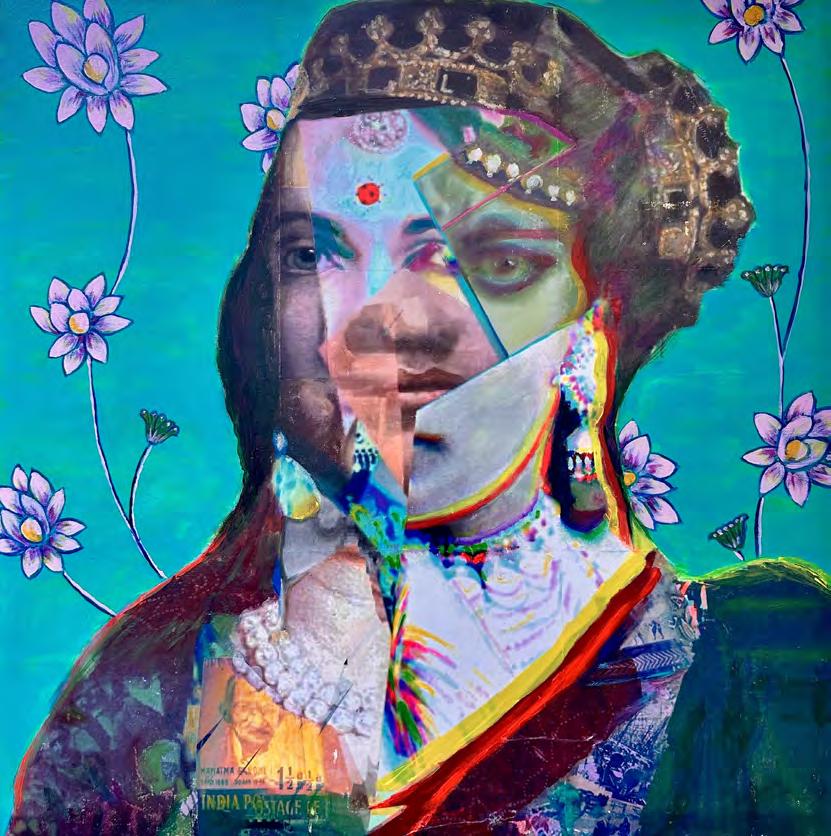
Faces of Unity
Mixed media: oil, acrylic, fabric, paper, ink, oil pastel
36 x 36 x 2 inches, 2023, *gallery
I am an Indian immigrant and a sociopolitical artist. My works are inspired by exploring colonialism’s legacy which divides East and West, fostering bias based on appearance. My portraits aim to transcend this, depicting individuals as products of diverse influences. Highlighting our shared humanity, I challenge the notion of difference, revealing how colonialism ironically unites us and makes us uniquely similar. Through art, I hope to promote equality for all genders, races, religions, and colors.
nimishart.com, San Francisco, California
36
JESSICA DUBY

Venus d’Estradiol
Photograph
19 x 17 inches / 24 x 22 inches framed, 2021, *gallery
IVF is the latest battleground in the war on reproductive justice. This photograph documents the eve of my roommate’s egg retrieval procedure, after a constellation of bruises accumulated from several days of estrogen injections meant to thicken the lining of her uterus. Cast as Venus, goddess of fertility and beauty, she embodies a modern version of the timeless archetype, but also personifies the personal and political struggle of having a body capable of reproduction.
jessicaduby.com, Brooklyn, New York
37
MYRA EASTMAN

God & Country: Protecting Children-One Book At A Time
Acrylic on canvas
46 x 38 inches, 2024, *gallery
I am a narrative New Surrealist painter whose work is grounded in political and social narratives. This painting from the series, God & Country charts the intrusion of White Christian Nationalism into mainstream American life. The lines separating church and state are getting blurry. Christian demagogues seek to manipulate institutions that threaten the very core of personal freedoms in America. myraeastman.com, Santa Cruz, California
38
MICHELLE ECHENIQUE
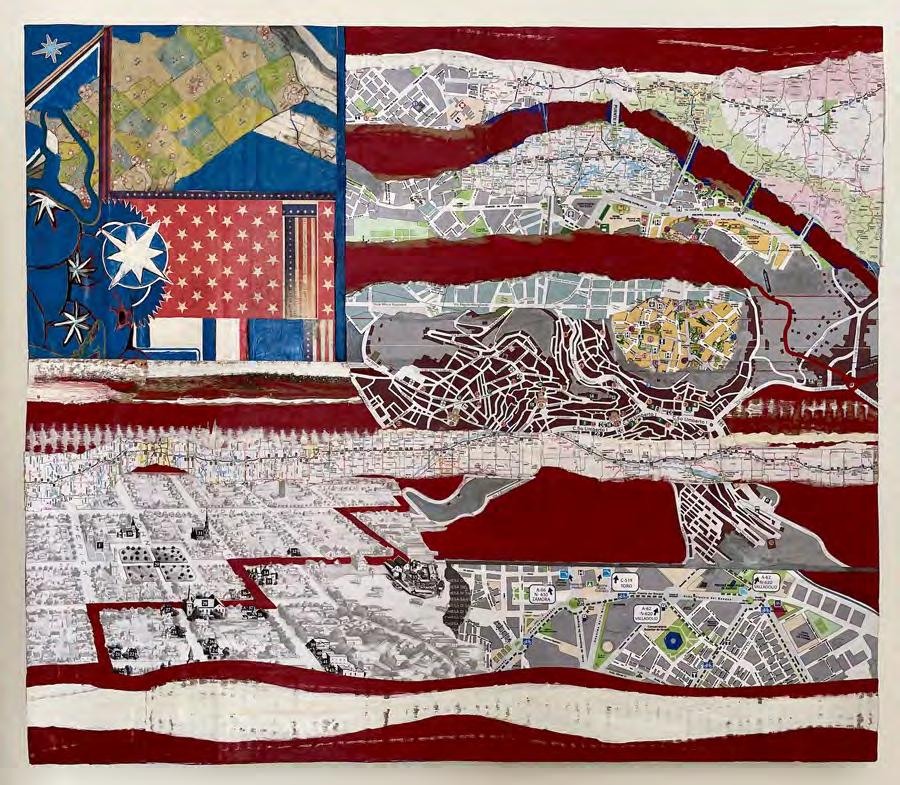
Immigranation
Cardboard collage 22 x 25.5 inches, 2021, *online
As antidote to our fraught politics, I began making work using the US flag design as the starting point. The increased conflict between what the star spangled banner purports to uphold and reality begged for exploration. Immigranation, (immigrant+nation) is my response to the country’s troubled history with migrants, particularly those who are acceptable and unacceptable, and the long, winding and dangerous road one must negotiate to gain access. This piece, part of My American Flags, explores truths not so self evident.
michelleechenique.com, San Francisco, California
39
SALLY EDELSTEIN

Womens Lib - A Storm’s Approaching
Mixed media collage, paper, pencil, paint, print 20 x 24 inches, 2023, *gallery
Coming of age during the 2nd wave of feminism I became conscious not only of gender inequality but how our identities became fragmented by a media of ever-changing standards. Feminists were caricatured in the media even as they were championed in the news so that the fault line between coming of age during an era of rising expectations for women even as women were mocked, burst wide open. What did it mean to be a woman in the wake of the movement?
sallyedelsteincollage.com, South Huntington, New York
40
SALLY EDELSTEIN
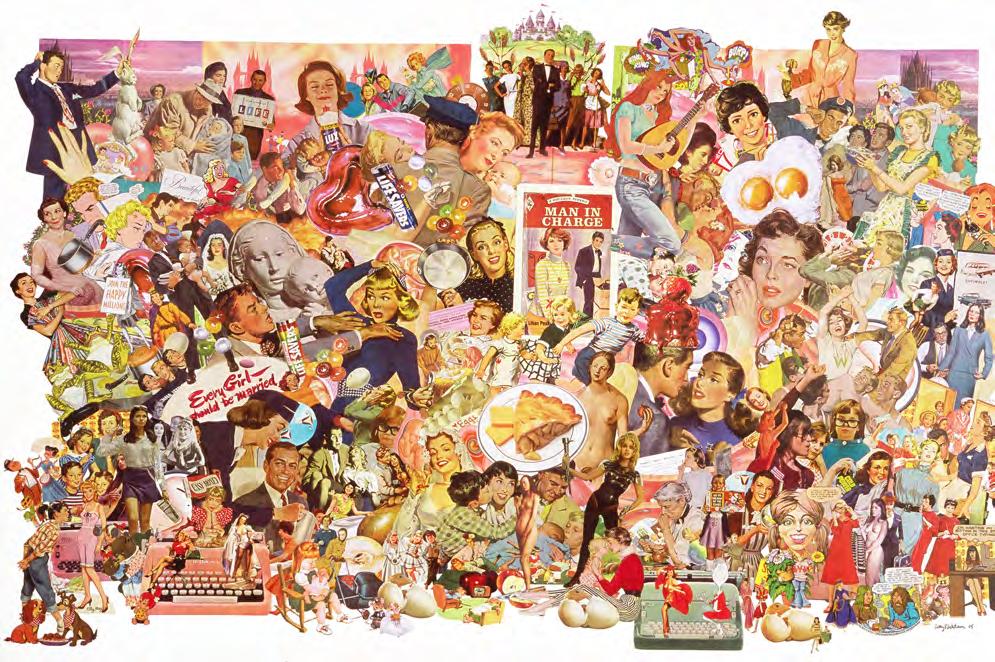
Man in Charge
Mixed media collage, paper, pencil, paint, print 18 x 25 inches, 2023, *online
Along with being powerful enforcers of gender, these mass media images helped shape our psyches in setting standards of how women should imagine their lives, think of fulfillment, and arrange priorities. The insistence that all women identified as wives and mothers gripped our consciousness yet by the 70’s marriage and motherhood were disparaged. In the wake of the women’s movement, what kind of woman should we be, how ambitious, how accommodating to men?
sallyedelsteincollage.com, South Huntington, New York
41
MARGUERITE ELLIOT

Where’s The Justice?
Steel, lead, gold paint
12 x 24 x 4 inches, 2019, *online
There are 2,291,000 people imprisoned in the United States. Where is the Justice? draws attention to mass incarceration, and the glaring injustices within our prison system. Through the steel enclosure and evocative symbolism of lead and gold, it sheds light on the human cost of a flawed judicial process. The sculpture challenges viewers to reflect on the harsh realities faced by marginalized communities, urging a collective call for reform and true justice in our society.
margueriteelliot.com, Fairfax, California
42
SOMAYA ETEMAD
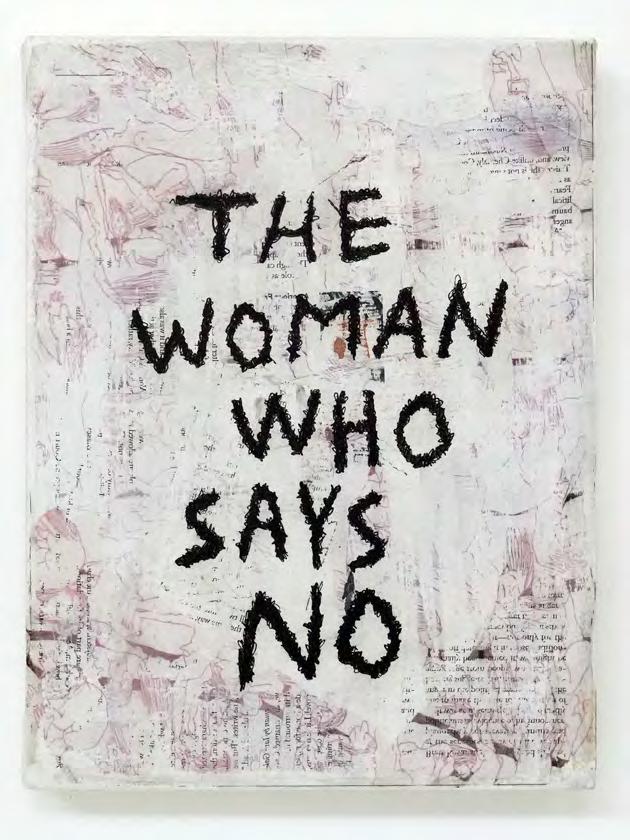
The Woman Who Says No
Mixed media, ink, pen 12 x 9 inches, 2024 *gallery
Inspired by Françoise Gilot, The Woman Who Says No celebrates the power of refusal in a society that often pressures women to acquiesce. This painting captures moments of defiance and empowerment, urging women to embrace their right to say no. The work reflects the extraordinary acts of ordinary notions, embodying my visual homage to the strength found in refusal and Gilot’s resilient journey towards independence.
inkblackwhite.com, Los Angeles, California
43
CORINNE FARAGO
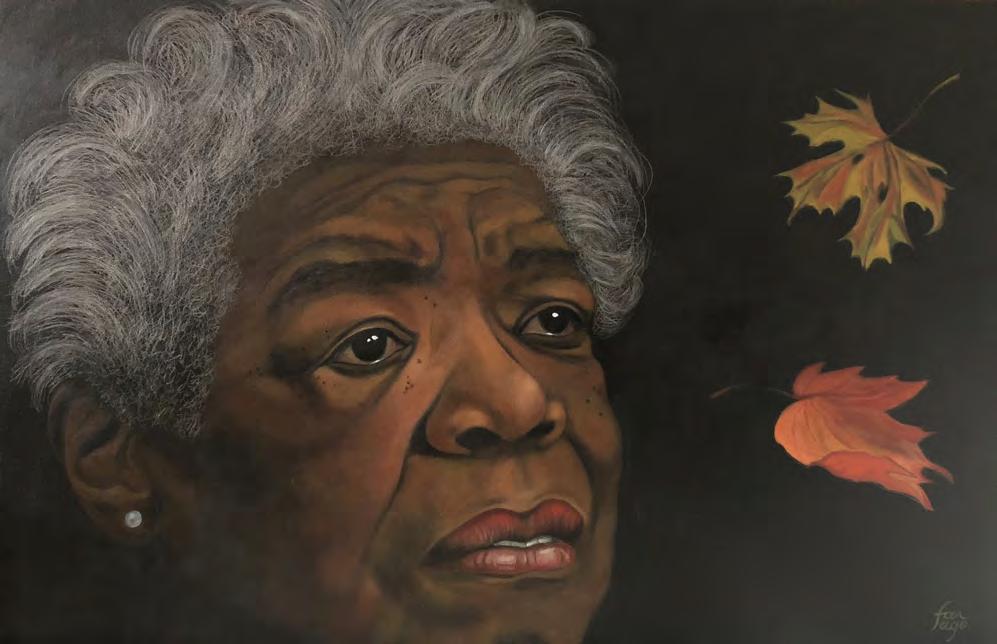
Maya Leaves
Acrylic on canvas
24 x 30 x 1.5 inches, 2018, *online
Through Maya Angelou’s powerful words and fearless advocacy, she inspired countless women to embrace their strength, resilience, and inherent worth. In this portrait, Maya Leaves, I chose to depict her with two falling leaves—a symbol representing the deaths of her dearest friends, Martin Luther King and Malcolm X. She described these events as two of her greatest losses in life. I wanted to honor the depth of her experiences, her grief, and the resilience that defined her remarkable journey.
cfarago.faso.com, Mill Valley, California
44
THERESA GIAMMATTEI

Liberty is a Lady
Acrylic and crocheted yarn on canvas 24 x 24 inches, 2022, *gallery
In Liberty is a Lady, using yarn to superimpose the shape of a uterus onto the Statue of Liberty, I hope to remind viewers that even our most basic political symbols of liberty and freedom are female.
uncommonegress.com, Los Gatos, California
45
THERESA GIAMMATTEI

Doomsday Clock
Acrylic on canvas 36 x 36 inches, 2018, *online
Scientists created the Doomsday Clock to represent the likelihood of man-made catastrophe. My feminist’s version is in response to the current Supreme Court and anti-choice laws at the state level. Our access to liberty is determined by laws.
uncommonegress.com, Los Gatos, California
46
RINAT GOREN
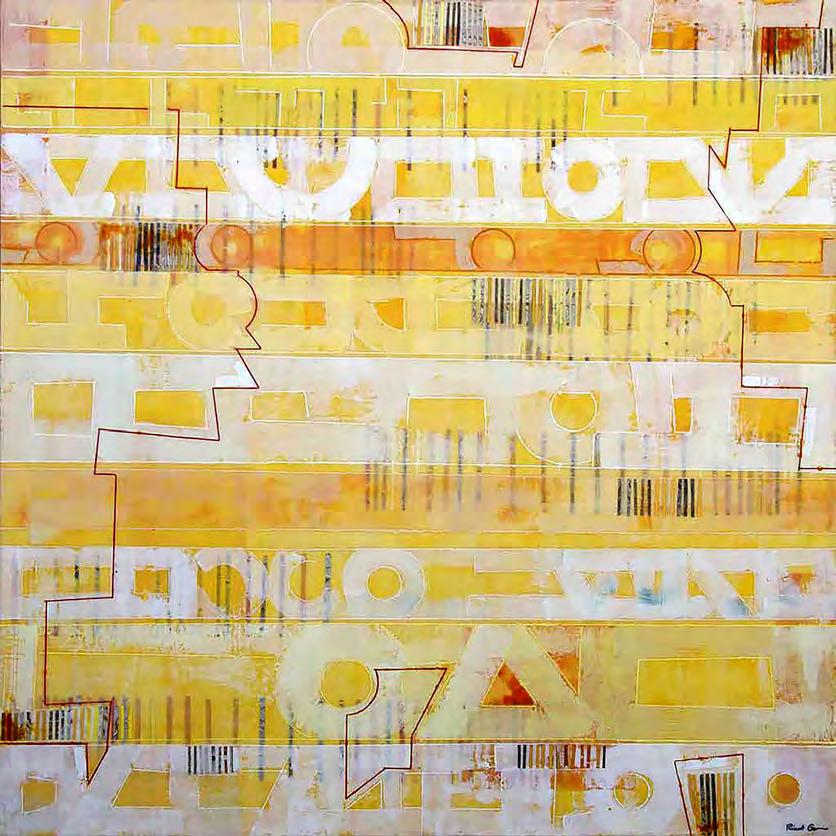
Borders. Who Needs Them?
Encaustic and paper on wood panel 36 x 36 inches, 2018, *online
The realm of nations, states and borders fascinates and intrigues me as an individual. I am interested in questioning who has a right for a territory? Who has a right to decide and vote? Who has the access to join or the choice to turn away and leave? These questions apply as well to determining and choosing our own personal boundaries. This piece is an attempt to discuss borders and an invitation to join the conversation.
rinatart.com, Woodside, California
47
LAURA GREEN

Hold You
Acrylic 14 x 11 inches, 2024, *online
My artistic practice is a way to protect, preserve and remember my experience of parenting. My daily life of raising children is best shown in the seemingly infinite moments of caretaking, which are ultimately temporary and fleeting. I am a mother to four children, and it’s very important for me to remain physically and emotionally connected through out our journey together.
lauragreenstudio.com, Imperial Beach, California
48
STACEY GREGORY

Rape of Themis, Goddess of Justice
Spinning wooden barrel top, acrylic, metal stand 24 inches diameter, 2018, *gallery
The Supreme Court Confirmation Hearing of Brett Kavanaugh and the testimony of Dr. Christine Blasey-Ford foreshadowed the reversal of Roe v. Wade. The spinning piece shows the whiplash that dismantling 50 years of abortion access will have on future generations. As Themis spins, her sword and scales are ripped away and her blindfold is pushed up over one eye. She realizes then that it is her own justices who betray her.
skgregoryart.com, California
49
TALI GRINSHPAN
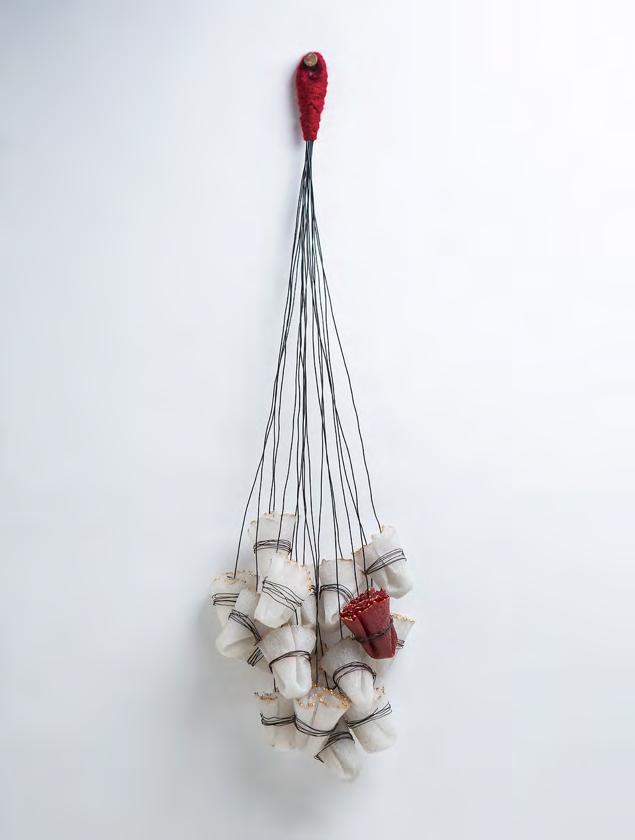
Be.Longing
Glass, metal wire, yarn, 24k gold leaf
30 x 10 x 6 inches, 2023, *gallery
As an Israeli immigrant, growing up in a war-torn country, and now witnessing the dissension within America and around the world, I think about our voices as immigrants, about synthesis, about finding commonalities among perceived differences. Very often immigrants are invisible in society. With a background in Psychology, I examine the human condition, utilizing glass as an analogy. I explore the concept of identity, telling a story of fragility and strength, vulnerability, and resilience.
taligrinshpan.com, Walnut Creek, California
50
ELLEN GUST
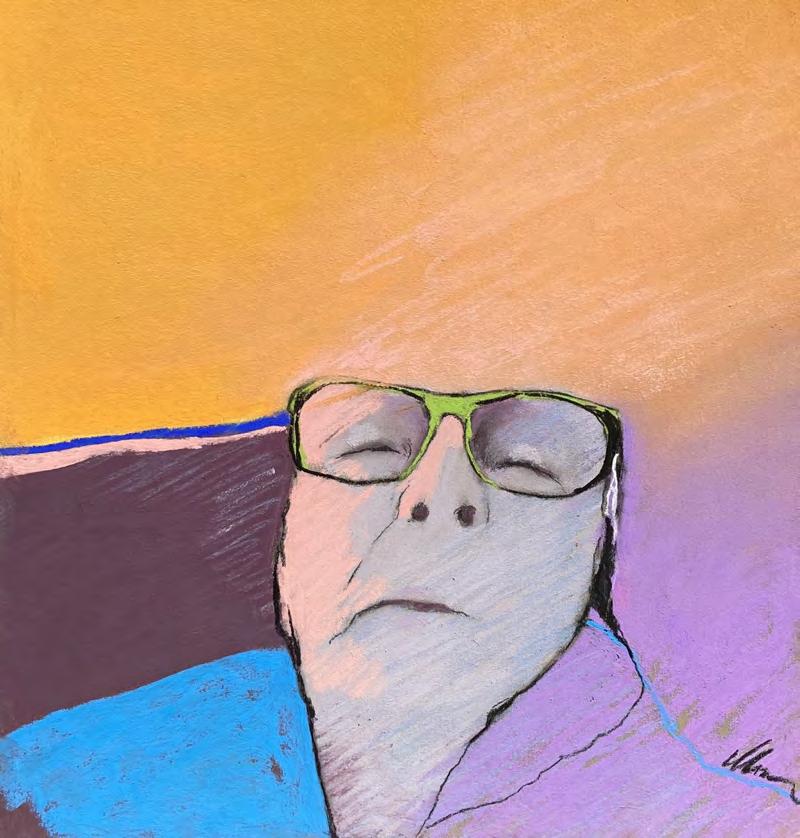
Loosing My Mind
Pastel on sanded paper
12 x 10 inches / 16 x 16 inches framed, 2022, *gallery
The theme of this exhibition emphasizing women’s issues caught my eye to submit work that is very personal in nature. The image I created, Loosing My Mind, is about growing old, living in fear of dementia. It shows the top of an old woman’s head vanishing into dust. Being a senior citizen, I am keenly aware of the deterioration of our bodies.
ellenjgust.com, Palo Alto, California
51
ELLEN GUST

On The Chopping Block
Pastel on sanded paper
12 x 12 inches / 16 x 16 inches framed, 2022, *online
On The Chopping Block, directly relates to the loss of a woman’s right to choose. This dramatic image shows a pale vanishing head on its side symbolically chopped off, which since the repeal of Roe v. Wade is how it feels. Every day I feel the rights I voted for as a young woman are systematically being assaulted all over again.
ellenjgust.com, Palo Alto, California
52
KELLY HARTIGAN GOLDSTEIN
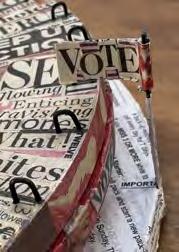
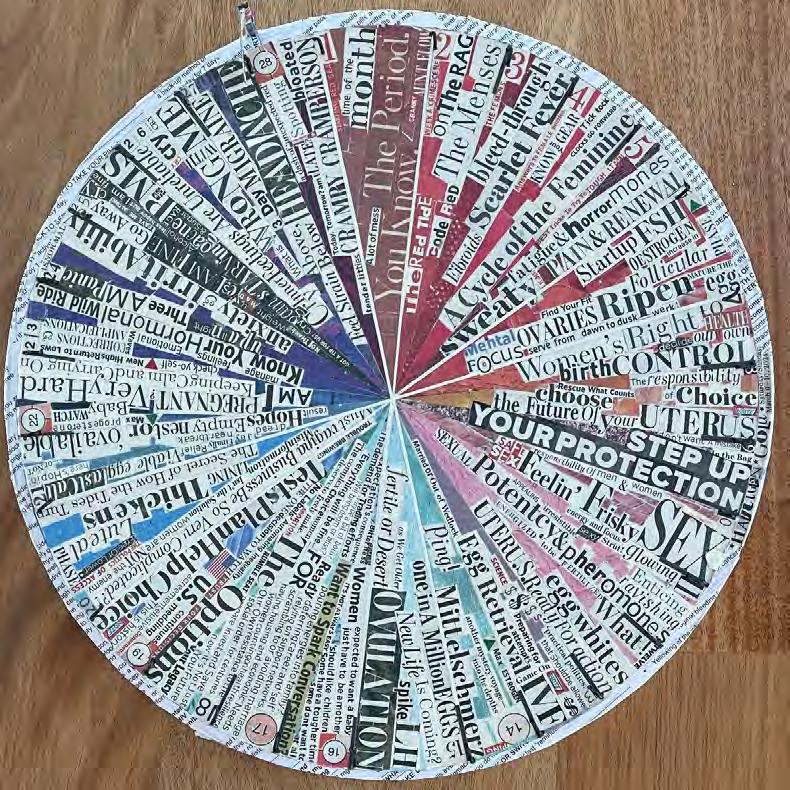
Future
of
Abortion,
28 Days of the Feminine Cycle, WSJ 3/9/24 Daylight Savings Weekend 2024
One Wall Street Journal newspaper, acrylic matte medium on wood panel 15.25 x 15.25 x 2 inches, 2024, *online
Ruminating over current events, I compose moments with daily newspapers. My raffle wheel represents the 28 days of an average feminine cycle. Spin the wheel, win a prize. The perpetual hormonal renewal poses challenges and hard questions. 2024 brings an urgency to keep the answers and access in the hands of women needing options. My own wheel may stop, but I remain connected to the freedom of future generations. Time and progress move forward. Vote!
kelgoldart@gmail.com, Laguna Beach, California
53
HEDY HERRERA

Migrations
Intuitive drawing, ink and permanent markers on acid free mixed media paper 12 x 9 inches, 2023, *online
Taking experience from my own life as a woman and an immigrant, I have witnessed cultural intolerance, unfairness and prejudiced actions toward others and myself. As an artist I feel a responsibility to speak out against discrimination through the art I create. Representing social issues in my artwork carries the intention of reminding the world that after over a century of ERA, discrimination and prejudice still are used to make the ones with different characteristics objects of collective inequality.
@herrehedy_art, Willow Glen, California
54
DEBORAH HIRSHFIELD
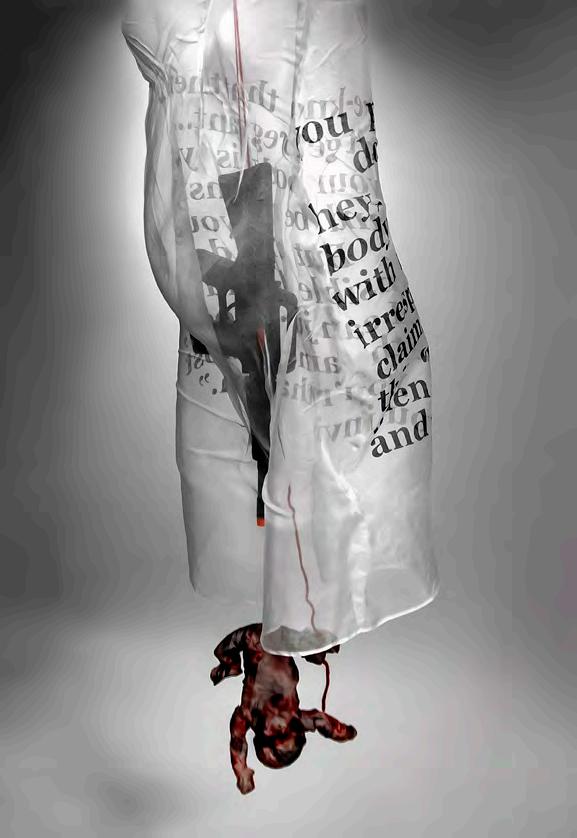
Amerikan Skript
Dyed, molded, sewn silk, serigraphy, plastic, yarn, metal 50 x 16 x 16 inches, 2022, *gallery
“…you’re a ‘host.’ …when you enter into a relationship you’re that host and so, …don’t get pregnant …you’re irresponsible …when you’re the host … you invited that in.’” * Weaponry for all—women’s rights for none, paving the way to fascism. Serigraphy with statement and proposal from then Oklahoma Republican, Justin Humphrey, on molded silk organza. An assault rifle precedes and usurps her fetus and her autonomy.
deborahhirshfield.com, Evanston, Illinois
*independent.co.uk/news/world/americas/us-republican-justin-humphrey-oklahoma-abortion-law-sexplanned-parenthood-pro-choice-a7580326.html
55
JUDITH HOPKINS

Self-Portrait as Swimmer
Charcoal on paper
72 x 48 inches, 2017, *gallery
Self-Portrait As Swimmer is from Visible Lines, a series of portraits and self-portraits I did exploring women and aging. The work began as an exploration about our perceptions about aging women and how aging affects our own self-image and psychological states. Older women often feel ignored or overlooked in our culture. This work attempts to document aging while also challenging what is an acceptable portrait of an aging woman?
judithahopkins.com, Thousand Oaks, California
56
SARAH HOROWITZ
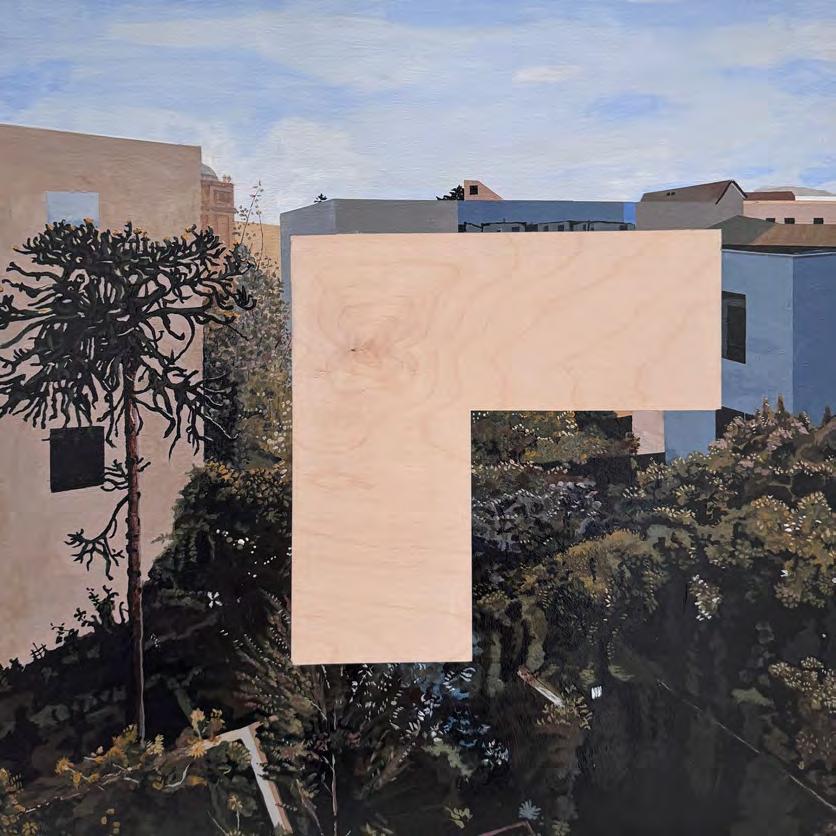
79 Percent of a View of the Palace of Fine Arts
Acrylic on cradled birch panel 18 x 18 inches, 2024, *gallery
The National Endowment for the Arts reports that among full-time visual artists in the United States, for every dollar a man makes, a woman makes 79 cents. In this painting, I interpreted that statistic graphically, with exactly 21 percent of the view “missing.” The unpainted void symbolizes what society loses—what remains unrealized—when any single group is chronically undervalued.
bentblue.com, San Francisco, California
57
KELSEY JONES
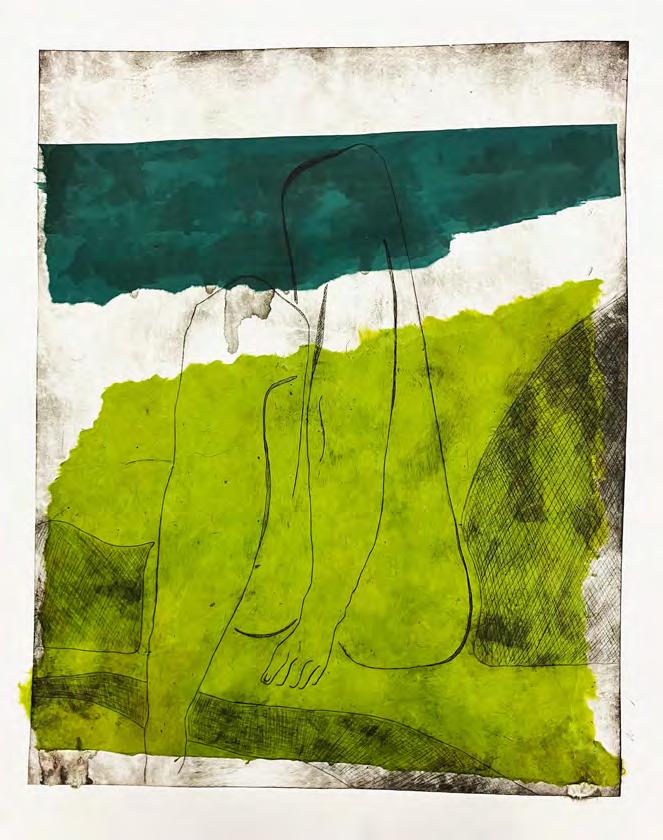
You and I are Mountains
Drypoint etching and chine collé 24 x 18 inches, 2023, *online
In this piece, I seek to make the connections between the feminine form in landscape and as landscape. I use the textual forms of chine collé and drypoint etching to show this connection. This relationship is a core component to ecofeminism as it speaks to the connection between the land and body. My art is a call to action—a plea for the liberation of both body and land, urging us to embrace a vision of coexistence where freedom knows no bounds.
kjonesprints.squarespace.com, Berkeley, California
58
KAY KANG
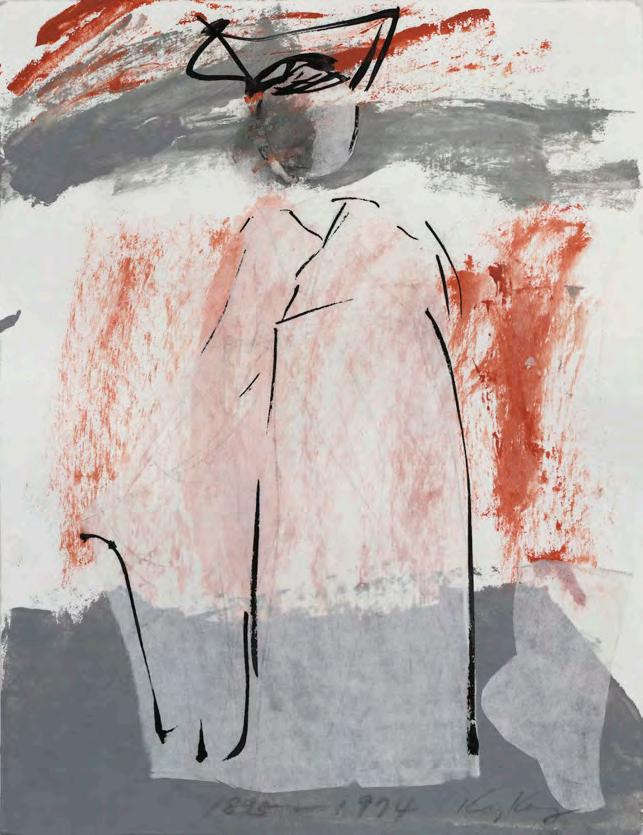
Halmony / My Grandmother
Hanji Korean paper collaged on BFK Rives 11 x 9 inches, 2023, *online
This work speaks to a persevering woman who fought courageously against gender bias in Korean Confucian society (1392-1910). Halmony, My Grandmother (1895-1974) witnessed the horrors of the Korean War and the division of the country into two Koreas. She was resolute in her determination to be a role model for future Korean women as exemplified by the traditional beosun (socks) that take bold steps to defy gender constraints.
kaykangart.weebly.com, San Francisco, California
59
QUINN KECK

We Will Implode this Capitalist Hellscape I Letterpress print on Colorplan paper 20 x 16, 2024, *gallery
We Will Implode this Capitalist Hellscape carries on the legacy of the Women’s International Terrorist Conspiracy from Hell (W.I.T.C.H.) who hexed Wall Street October 31, 1960 to emphasize working class struggle. The slogan, sigil, and artist book examine historical ties between the witch, economic systems, and colonialism. In the midst of on-going genocides, the project is a cry to action to Free Palestine, Free Sudan, Free Congo and all oppressed peoples. Viewers are encouraged to examine the narratives that create their perception of reality and ultimately to cast their own spells.
quinnkeck.com, San Francisco, California
60
QUINN KECK

We Will Implode this Capitalist Hellscape II
Artist Book: Riso and letterpress on Colorplan paper
Printed at Women’s Studio Workshop 13 x 9 x 3 cm, 2024, *gallery
The dimensions for this artist book/zine are significant numbers and intentionally in centimeters. For the complete text and more next steps: bit.ly/hexcapitalism.
quinnkeck.com, San Francisco, California
61
KATHLEEN KING
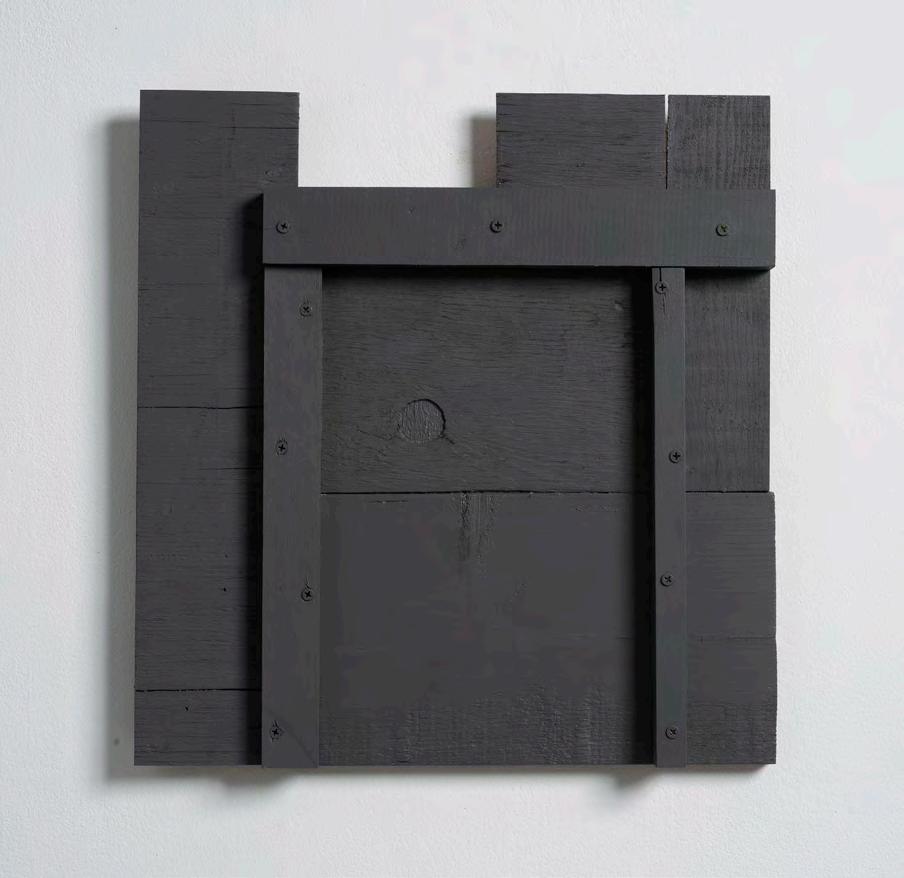
Strong Ties 6
Discarded wood, housepaint, screws 19 x 18 x 1.5 inches, 2022, *gallery
Since 2019, I have hand-built assemblages from discarded wood in a series called Strong Ties. The title comes from a brand of mending plates used in the construction trades. Using simple construction methods, pieces of found plywood are attached together with other scrap pieces. A design is created from the functional placement of these connectors. This work demonstrates the strategies of solidarity, attention and care that we maintain to protect and support equitable, sustainable relationships.
kathleenking.carbonmade.com, Berkeley, California
62
KAYLA KIRSCH

We Are Not that Different
Acrylic paint on wood panels 18 x 48 inches, 2024, *online
I created this snapshot of a woman in Gaza (left) and in Jerusalem (right) as a call for humanity. Intertwined through land, ancestry, hopes, and fears, we want similar things: access to peace and safety, sufficient resources to live, raise our families, play vital roles in our communities, cross boundaries freely, and co-exist well. We are not that different. It is time for significant rebalance and transformation into better ways of being human together.
kaylakirsch.com, Oakland, California
63
SHANNON KNOWLTON
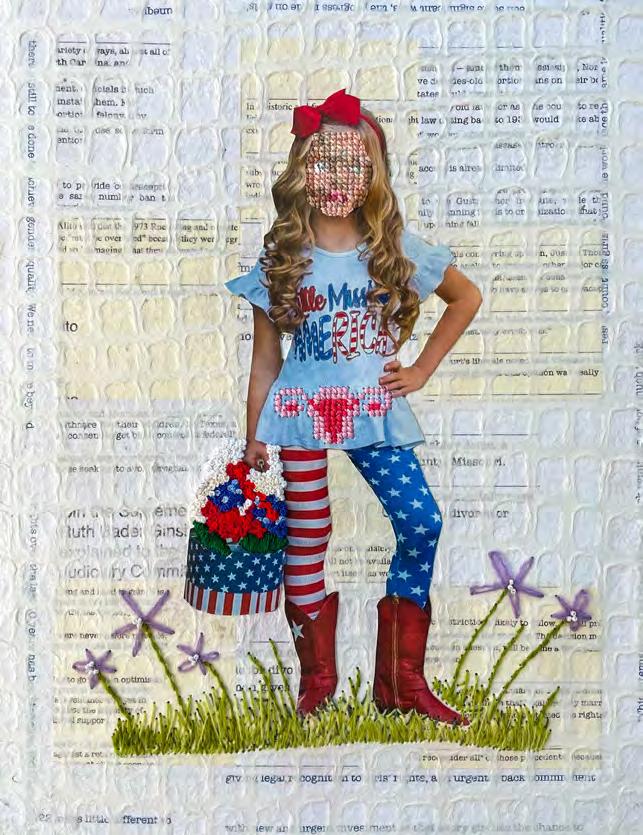
Little Miss America
Periodical paper, handmade paper, thread, and beads 14 x 11 inches, 2024, *online
I’m thrilled to be part of this exhibition illuminating human rights inequities. My piece is inspired by the U.S. war on reproductive rights. Women are currently losing these rights, gained through fifty years of feminist struggle. Access to proper, inclusive reproductive health care becomes dangerously limited. As the government gains control over our bodies, we’re reduced to our reproductive organs, which we don’t govern. Using traditionally feminine needlework in my piece is an act of homage and reclamation.
shannonknowlton.com, Los Gatos, California
64
GRACE KERSBACK

The Door
Acrylic paint on canvas 20 x 16 inches, 2023, *gallery
My painting, The Door, is a depiction of the emotional trauma that domestic violence can have on its victims. It is a reflection on how difficult it may be to reach out for help and a metaphor for the obstacles that are in a victims path on their way to getting out. I want to raise awareness to this societal problem and change the stigma around abusive relationships, especially for women in this day and age.
@gkresback_art, Stony Point, New York
65
KRISZTINA LAZAR
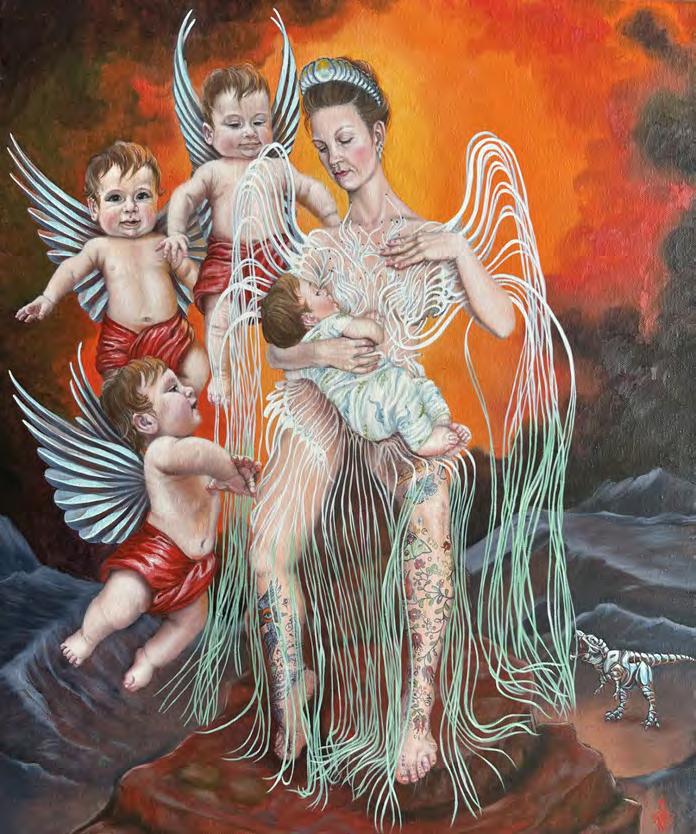
of the Dinosaurs Oil on canvas
28 x 24 inches framed, 2023, *gallery
In a desolate and apocalyptic background representing the violence our culture is enacting on mothers, the Madonna, dressed in couture, takes a moment to feed her babe. Access to reproductive and maternal healthcare shouldn’t even be a question, yet our country is more restrictive than ever. This painting is a prayer that we rebuild the support for mothers which we have systematically eroded and to provide the structure that allows each new generation to flourish.
transcendentbird.com, Vallejo, California
Madonna
66
KAREN LECOCQ

I’m Sexy and I Sweep
Bamboo, palm bark, copper wire, Asian broom, wood, acrylic paint, glass beads
59 x 29 x 5 inches, 2024, *gallery
This work deals with the stereotype placed on women to always look appealing and sexy, the impossible standards placed upon them and the expectation that they as women do the majority, if not all of the household chores. This is mirrored in the working world where the expectation of equality, long awaited for, has not been reached. The Equal Rights Amendment has not passed, inequalities still exist and the constant fight drones on.
karen-lecocq.com, Mariposa, California
67
KRISTINA LENZI

Self-portrait Posing As An Artist at An Art Opening
Prismacolor and collage on Canson paper 25 x 19 inches, 2022, *online
My self-portrait drawing takes a sardonic and paradoxical look at the relationship between patriarchy and feminism. My head plunges out of the male body, practically deranged, trying to identify as a woman in a world dominated by men. This drawing hits particularly close to home, as I have been an artist at an art opening. The drawing tries to make sense of how I fit into my surroundings.
kristinalenzi.com, Salt Lake City, Utah
68
ROBERTA LEVITOW
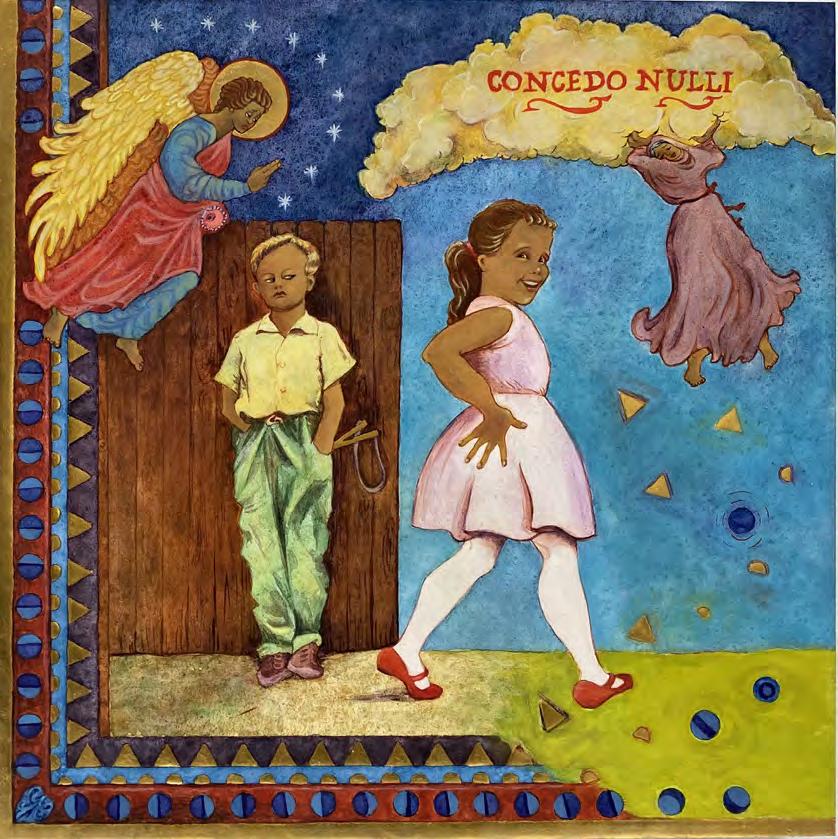
Concedo Nulli (I Concede Nothing)
Egg tempera and gold leaf 16 x 16 inches, 2022, *online
To make sense of our often-senseless world, I fuse eclectic influences in secular icons that incorporate traditional symbolic elements with a contemporary, secular vocabulary. Concedo Nulli (I Concede Nothing) represents my own visceral response to the 2022 U.S. Supreme Court decision abruptly upending longstanding guarantees for women’s rights around bodily autonomy. In the painting, a young girl defies past restrictions and strides—innocently but boldly—into the freedom of an uncertain future.
robertalevitow.com, Santa Monica, California
69
SUKI LIEBOW

Women Don’t Owe You Babies
Acrylic, mixed media on plywood with wood ironing board 7 x 7 x 1 feet, 2022, *online
Women Don’t Owe You Babies calls out the archaic expectations and immeasurable pressure of often contradictory demands placed on women in society. In addition to being an aggressive response to the overturning of Roe v. Wade, it is a statement of refusal to subscribe to systems of oppression by naming and consequently refusing to submit to the agenda of a medieval institution.
sukiliebow.com, Vallejo, California
70
BILLI LONDON-GRAY

How to Be Taken Seriously with Boobs
Unique handmade book using t-shirts and underwear of the artist, google eyes 9 x 6 x 1.5 inches, 2019, *gallery
As an artist, I examine how we succeed and fail at living out the ideals of equality. How To Be Taken Seriously With Boobs is a unique artist’s book that shares tips for overcoming biases. While cheeky and playful, such defensive strategies feel necessary to me for navigating this world.
billilondongray.com, Laramie, Wyoming
71
BILLI LONDON-GRAY
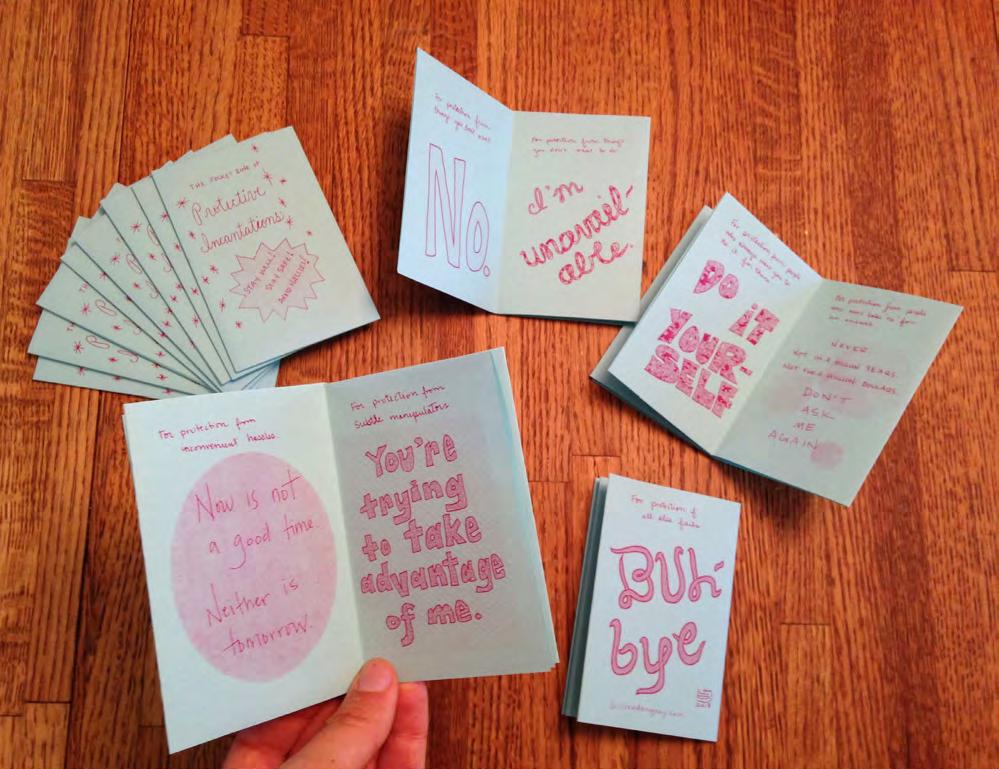
The Pocket Zine of Protective Incantations
Handfolded zine, open edition 4.25 x 2.75 inches, 2018, *gallery
As an artist, I examine how we succeed and fail at living out the ideals of equality. The Pocket Book of Protective Incantations is a zine that shares strategies for taking control of circumstances by saying no.
billilondongray.com, Laramie, Wyoming
72
ANNIE MARINI-GENZON
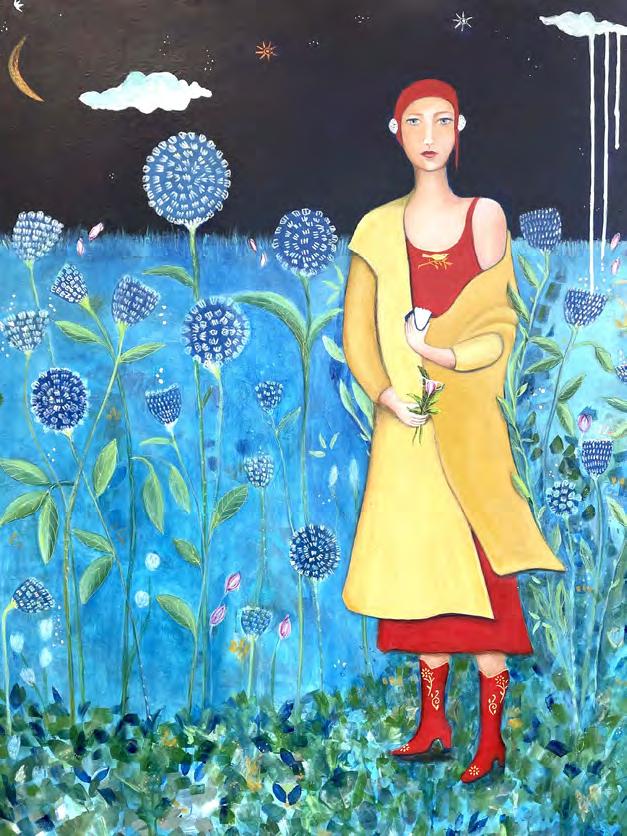
Breaking the Silence
Acrylic and oil on canvas 48 x 36 inches, 2023, *gallery
When I create figurative paintings, women occupy a predominant area. These women tell stories and share secrets with the viewer. In this painting, Breaking the Silence, I wanted to express my concern about reproductive rights; so much is happening nowadays where these rights are removed or denied to people! While working on this painting, I wanted to convey a powerful message to society with particular attention to Reproductive Rights that governments must respect and protect.
amgart.com, Altadena, California
73
PENNY MATEER
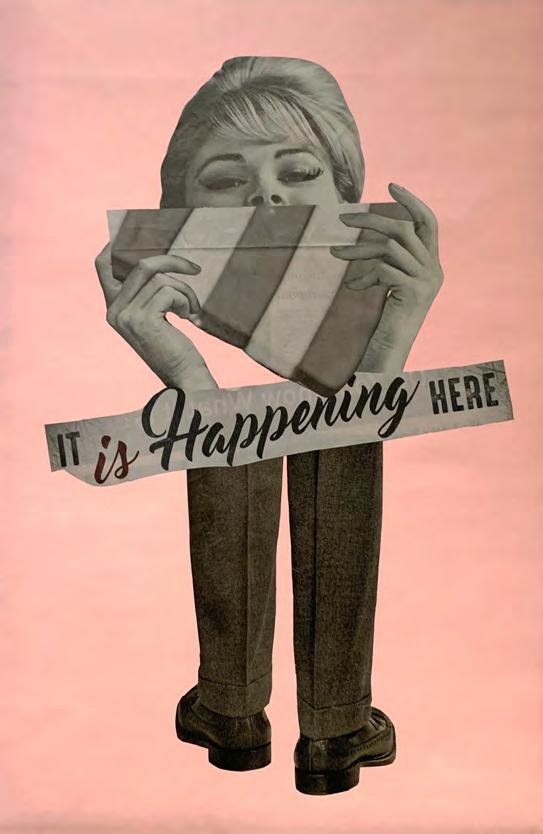
It is Happening Here
Vintage magazine, construction paper 17 x 11 inches, 2021, *online
I’m exploring the tension between misogyny and feminism and how that is manipulated in today’s politics. Abortion is used as the galvanizing issue to indoctrinate the religious right to vote “family values” to undergird white supremacy. I repurpose old magazines and combine imagery with existing text to consider the ways nostalgia is used in messaging.
pennymateer.com, Pittsburgh, Pennsylvania
74
ELIZABETH MEDRANO
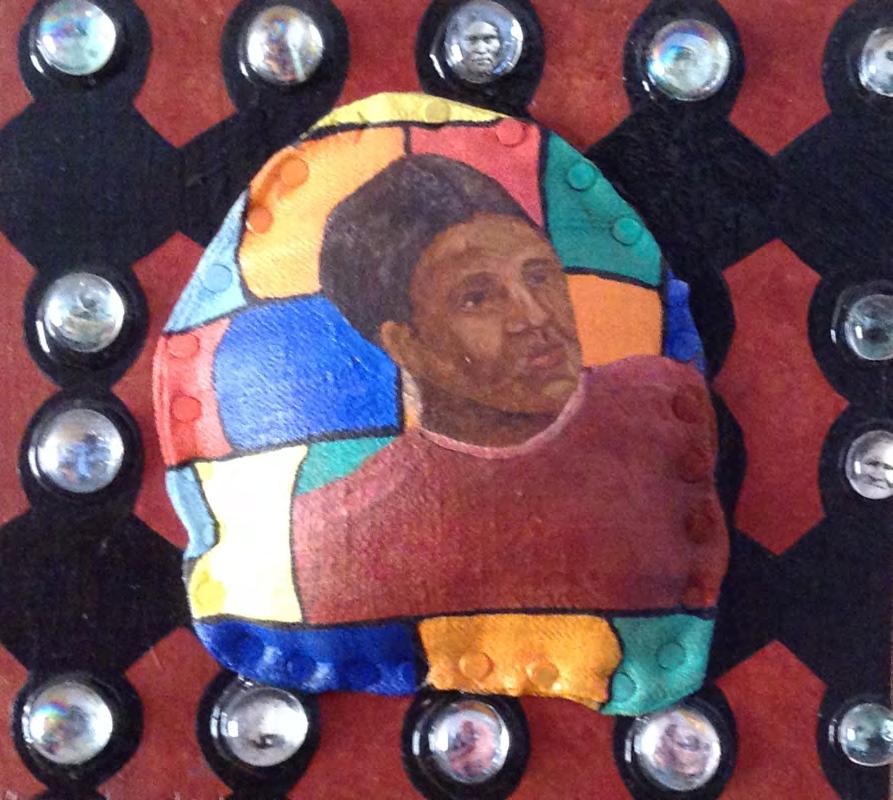
Selma
Acrylics, canvas on board, glass, photos, fiberfill 8 x 8 x 2 inches, 2014, *gallery
I feel connected to Burke because her sculpting in the mud as a child and lifelong commitment to art and education mirrors my journey. A true trailblazer, defying barriers for over 60 years, Selma Burke was one of the first women to receive lifetime achievement award from the Women’s Caucus for the Arts. Her iconic Roosevelt relief sculpture, shamefully copied for the US dime design, exemplifies her lasting impact despite the credit she never received.
elizabethmedrano.com, San Francisco, California
75
SHANNA MEROLA

Dioxin
Analogue photo collage 24 x 16 inches, 2022, *gallery
The Love Canal series examines the legacy of North America’s first Superfund site through the unsung history of mothers who organized for environmental justice in their neighborhoods during the late 1970s. The intersections of race, class, gender, and housing are inextricably linked to this historic struggle, which created sweeping environmental legislation. Broader themes in the series also explore adaptation, reproduction, mutation, and survival—with a focus on the interconnectedness of our fragile ecosystem and the human body.
shannamerola.com, Detroit, Michigan
76
JULIET MEVI

We Are Here. Hear Us Roar
Printers ink, acrylic paint, heavy watercolor paper, and paper on stretched canvas 10 x 30 inches, 2024, *online
Access can be a two way street. For women to achieve equality in a patriarchal society, women need to be united. A team spirit is necessary, solidarity in purpose must be the main focus. In a society that is split along many lines socially, financially, culturally and politically, this may be difficult to achieve. My artwork, Hear Us Roar, is a visual representation of unity across all lines in spite of the divisions occurring in society.
mevishiflett.com, Emeryville, California
77
ROSEMARY MEZA-DESPLAS


Kayayei #1, Kayayei #3
Hand-stitched human hair and thread with watercolor accents 13 x 13 x 1.25 inches each, 2017, *gallery
Equitability in the global economy does not exist. Women, in some countries, cling to the lowest rung of society’s ladder. My artworks depict head porters: Kayayei. The Kayayei, teenage girls, work in Ghana’s urban cities carrying goods. Migrating from rural communities for poorly paid work, Kayayei are a vulnerable group in society. They work in pairs due to violence and abuse. Carrying the absurdly large vessels on their heads is a feat of balance.
rosemarymeza.com, Farmington, New Mexico
78
CRISTIN MILLETT
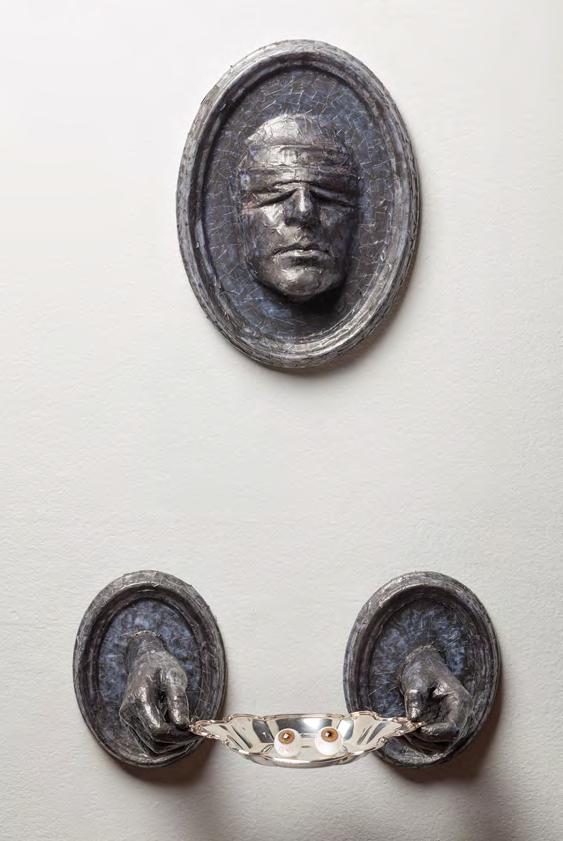
A Miscarriage of Justice: Lucy’s Offering
Polyurethane plastic, MDF, tape, graphite, silver-plate platter, glass eyes 30 x 18 x 10 inches, 2019, *online
St. Lucy, patron saint of the blind, holds her eyes on a plate to symbolize triumph over evil. My sculpture, inspired by Incorruptible saints and Blind Justice, responds to today’s political unrest. Growing disparities, fueled by divisive rhetoric and hateful acts, threaten gender and racial equality, reproductive rights, and voting rights. Through my work, I advocate for social justice, raise awareness, and sound the alarm.
cristin-millett.com, State College, Pennsylvania
79
LAURA MORRISON & GAIL SMUDA


100 Years and Waiting
Two deconstructed dresses, embroidery floss, printed ribbon
Horizontal artwork by Laura Morrison, 29 x 52 inches, 2022, *gallery
Vertical artwork by Gail Smuda, 52 x 29 inches, 2022, *gallery
Deconstructed clothing from two eras—a Victorian bodice and a 1920s flapper dress—comprise the imagery in this work. The Equal Rights Amendment is printed on a ribbon at the base of each piece. The dress fragments are surrounded by embroidered quotes by feminist leaders from the past and the present, addressing the fight for equality. The quotes essentially have the same meaning, which highlights just how long women have been fighting for equal rights under the law.
lauramorrisonart.com, Concord, New Hampshire gailsmuda.com, Concord, New Hampshire
80
KAILIN NIELSEN
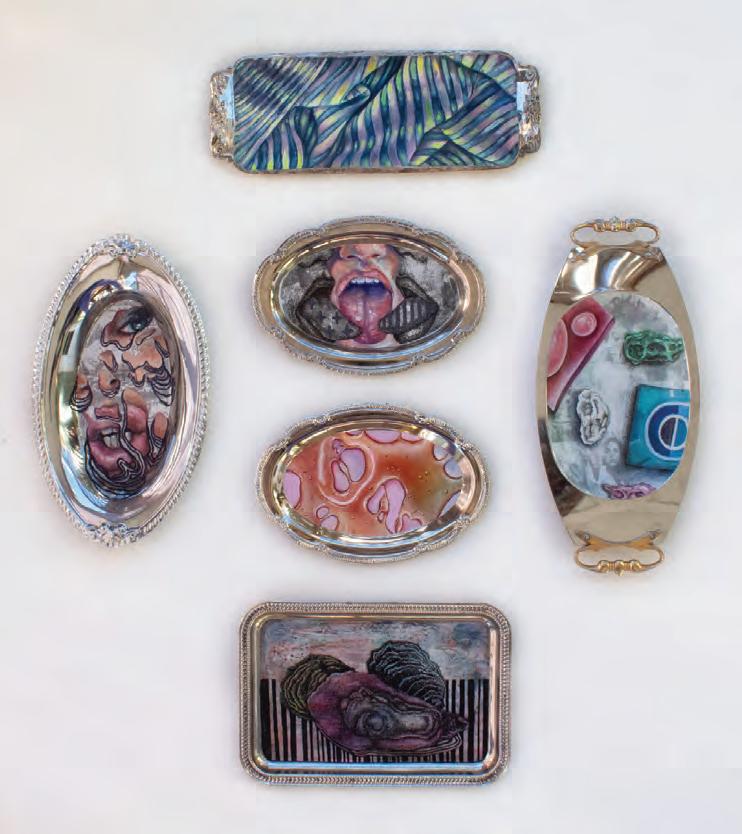
Servings of Femininity
Xerox transfers, ink, acrylic paint, oil paint, and glitter on silver trays 48 x 48 inches, 2023, *gallery
After the overturning of Roe v. Wade, I was conflicted about the legislative rights pertaining to the female body and our collective future. It was interesting to watch our society react, positively and negatively, to such a personal decision. I have been enthralled with exploring how the world views intimate moments of the female narrative. In Servings of Femininity, I focus on cinematic-style images and still lifes connecting to female sexuality, sensuality, and body image.
kailinnielsen.myportfolio.com, Lincoln, Nebraska
81

Suffragette
Cotton fabric, thread, feathers, buttons, lace 35.5 x 30 inches, 2018, *online
With Suffragette, I am paying homage to the brave women who took great risks to ensure that all U.S. women can vote for the candidates of their choice. The 19th amendment was signed into law in 1920, guaranteeing women the right to vote. This was 146 years after the birth of American independence in 1776. Progress is slow but worth the work.
ellennovember.com, San Luis Obispo, California
NOVEMBER 82
ELLEN
PRISCILLA OTANI
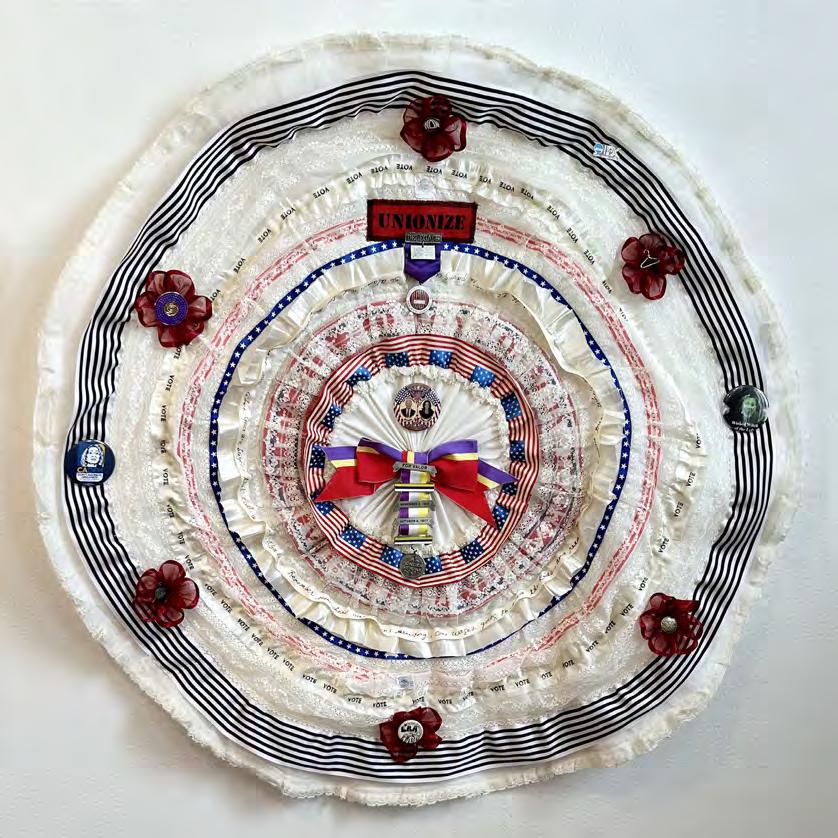
My Rights
Petticoat, ribbons, pins, crinoline 36 inches diameter, 2024, *gallery
My rights commemorates milestones that have advanced women’s rights, and in turn my rights, in the United States. The base is a petticoat, a feminine garment that is pretty but scratchy and uncomfortable to wear, something cast off. I used red, white and blue, the colors of the American flag, to represent patriotism; and purple, white and gold, the colors of the suffragette movement. The circular shape of this work represents the struggles women face in their ongoing fight for equal rights. Pinned throughout the petticoat are emblems of protest and progress.
mrpotani.com, San Francisco, California
83
VIDA PAVSICH
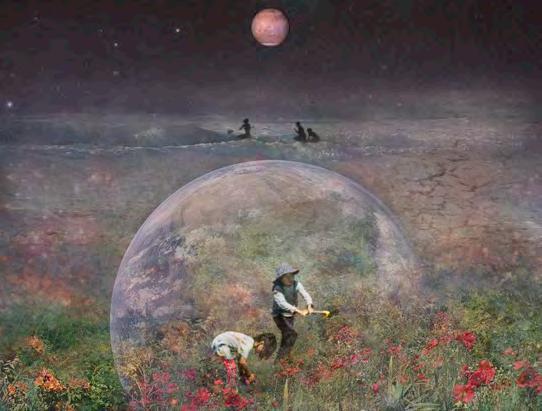

Earthbound 1, Earthbound 5
Digital photo collage, archival inkjet print, limited edition of 3 12 x 16 inches each, 2024, *gallery
20th-century feminist philosophers developed “care ethics,” which I extend to the Earth. I use my photographs and a NASA Earth image to highlight biodiversity loss and climate change. Women and children represent alternative directions and hope for the future through regenerative practices rather than dreams of escape to other planets. “Earthbound” is Bruno Latour’s concept: the earth sets limits and calls for “care” practices and making “kin” with all of life.
artanthropocene.com, Oakland, California
84
ELAINE PAWLOWICZ

Spacious Skies
Acrylic on canvas 30 x 40 inches, 2024, *gallery
Spacious Skies portrays an American flag waving proudly, symbolizing liberty and justice for all. Housing is a fundamental human need providing shelter, security, and physical well-being. My narrative addresses the importance of affordable housing and how our homes furnish us with an invaluable sense of belonging.
faultywire.com, Dallas, Texas
85
ELAINE PAWLOWICZ
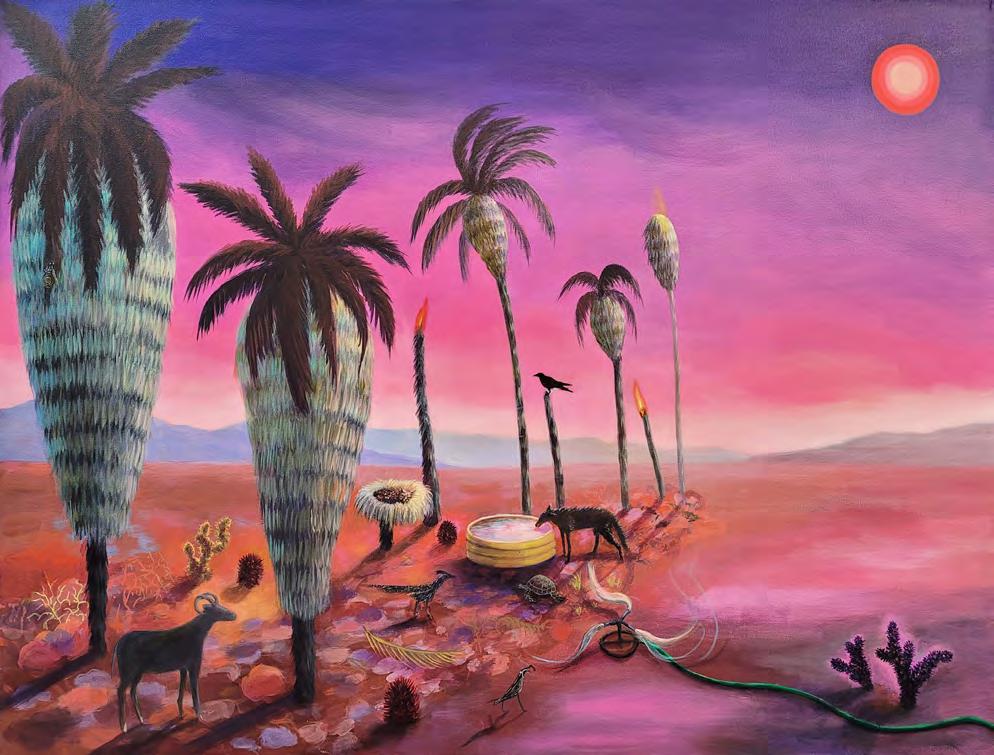
Oasis
Acrylic on canvas
30 x 40 inches, 2024, *online
My painting Oasis shares the story of a coyote drinking water from an inflatable baby pool while a lone garden sprinkler waters the desert oasis. A flame is burning from the top of a decapitated California Palm within the psychedelic twilight. Water is becoming even scarcer to our fragile ecosystems due to climate change and increased population. This oasis is slowly dehydrating, and the current human solution is unsustainable.
faultywire.com, Dallas, Texas
86
LAURA PHELPS ROGERS

Education Association
Digital C print on fine art paper 12 x 16 inches / 20 x 15 inches framed, 2021, *online
The Education Association building is captured, boarded up, a moniker for upward mobility w/ an image of might and unrest superimposed on its façade from the heat of strife and unrest of BLM in 2020. One block east of the Capitol and homeless encampments. Images of this day forced reflection, as a woman, on white male power and Howard Smith’s effort to subvert the 1964 Civil Rights Bill adding the word “sex” February 8th, 1964.
lauraphelpsrogers.com, Englewood, Colorado
87
PAMELA PITT

In Honor of Ruth Bader Ginsberg
Photography
20 x 16 inches, 2024, *online
“I would like in my lifetime to see women get fired up about the Equal Rights Amendment.” —Justice Ruth Bader Ginsburg. In her lifetime, Justice Ginsburg got women fired up about her and became known as the “Notorious RBG.” If all the fans of the Notorious RBG extended their enthusiasm about her to enthusiasm about the ERA, it would honor her in the most profound way. She deserves that. She is one of the founding “mothers.”
pamelapitt.com, San Francisco, California
88
BARBARA POLLAK-LEWIS
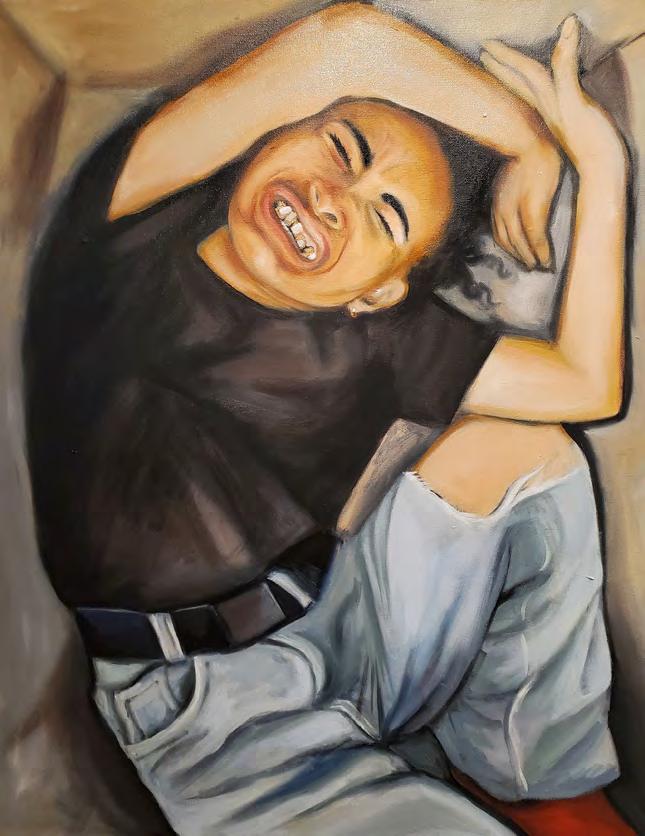
30 x 20 x 2 inches, 2023, *gallery
I started this series in response to the 2022 Supreme court decision overturning Roe v. Wade and the attempt to contain and control women by literally depicting them in boxes. With each painting, I aim to explore my own feelings about identity and restrictions as a woman while attempting to understand and empathize with my subjects and their own feelings of confinement and entrapment.
barbarapollakart.com, San Francisco, California
Aleja Boxed Oil on canvas
89
REMEDIOS RAPOPORT

Now is the Time to Make Justice a Reality / Now is the Time to Make Democracy Real Oil alkyd on aluminum panels of kinetic sculpture, fishing gear, beaded crystals 37 x 22 inches, 2010-2024, *gallery
Joyfully advocating social/political changes with actions to vote or sign petitions, to get informed and involved with lifestyle changes that may seem insignificant. Yet these small actions collect into powerful movements to protect systems of Social Justice and Democracy from destructive Global Corporate interests. My love of letterforms and dimensional effects of Filete Porteño attract viewers’ eyes and minds with ideas from my Gentle Revolution Manifesto. Having access to public venues for dialog are essential.
remediosrapoport.com, Portland, Oregon
90
CLARA JEANNE REED
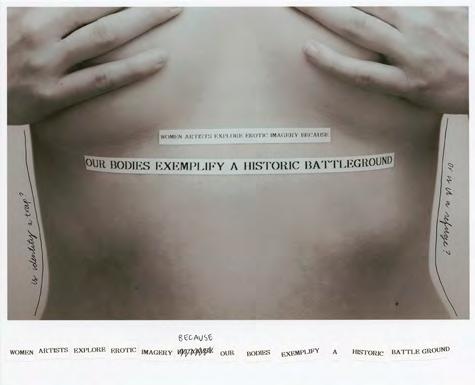

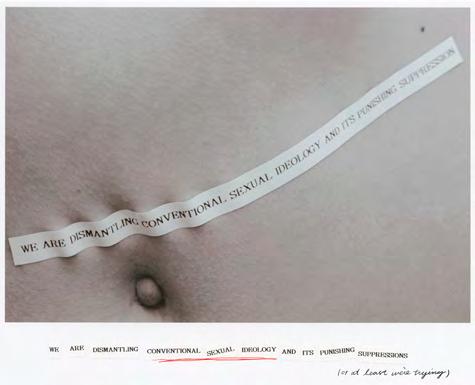
Prothesis I, Prothesis II, Prothesis III
(In Mourning and in Rage)
Photograph, mixed media 11 x 14 inches each, 2022, *gallery
The title for this series comes from the ancient Greek term for a body lying in repose on public view, typically in a funerary ritualistic context. I made this in the wake of the overturn of Roe v. Wade, to make sense of the rage I felt manifesting in a body I no longer felt I had control over. I made these self-portraits as a reminder that agency should be a birthright, not a privilege.
clarajeannereed.com, Brooklyn, New York
91
MINOO SAFAI-AMINI

Defiant
Mixed media
40 x 16 x 2 inches, 2022, *online
Iranian women are defiant of the current dress code as a sign of social and political repression. I’m utilizing imagery and ideology from the protest that followed the death of Mahsa Amini on September 16, 2022, three days after her arrest by the morality police in Tehran. In this symbolic painting, my character protests the rope and chain restricting her movement. She also gestures at flying crows (veiled morality police) to keep them out.
minoosaminiart.com, Sacramento, California
92
SONDRA SCHWETMAN
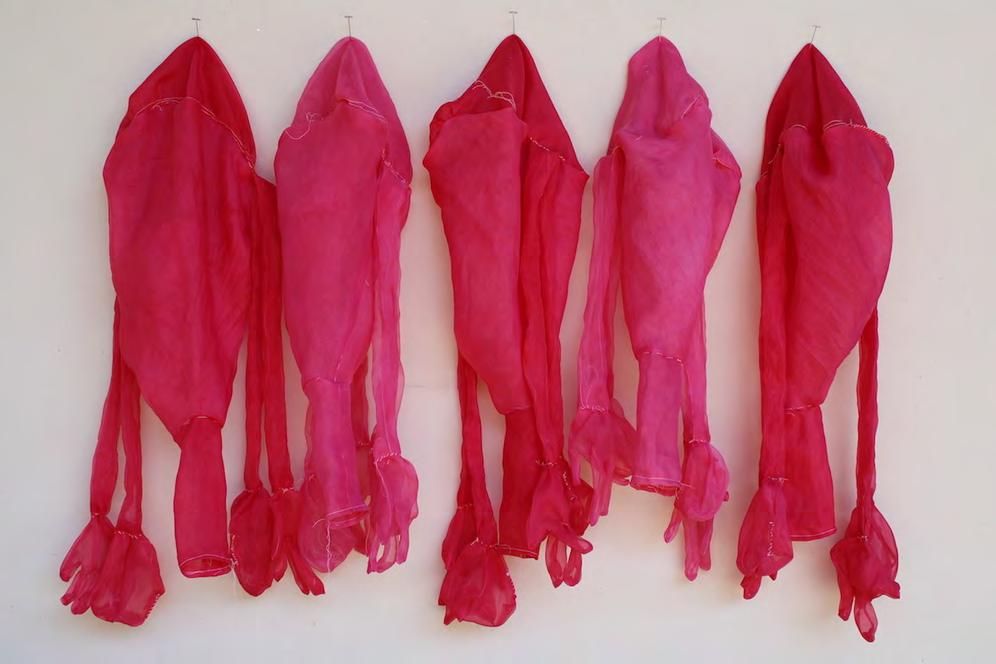
Political Meat
Silk organza, installation 26 x 54 x 5 inches, 2023, *gallery
I am concerned with women’s reproductive healthcare. Political Meat is an open question: How can something as important as women’s access to basic healthcare to be in question? Women comprise at least 50% of the global population. You might expect restrictions in religious autocracies, but not in a democracy. Roe your vote!
sondraschwetmanart.com, Arcata, California
93
LARRAINE SEIDEN

Seamless #14
Acrylic mixed media on canvas 36 x 36 inches, 2023, *online
For the Seamless series, I use clothing seams as a metaphor for the unseen work that holds things together and is largely done by women. Drawing with seams cut from spent clothing, the gestural lines dance and hover above a paper collage of everyday fragments from my life like lists and calendars. By taking the seams out of their quotidian context, they are transformed to become fluid and poetic, like bodies set free.
larraineseiden.com, Piedmont, California
94
DURBA SEN

Our Time Is Now
Acrylic painting on canvas 30 x 24 inches, 2019, *online
Our Time is Now shows a darker portrayal of women’s rights based on the television series, The Handmaid’s Tale. The painting aims to create awareness among women to bring us together in the continuous struggle for equality and rights. The surety of Roe v. Wade being overturned and women’s right to choose being restricted in more than half of the country, has brought the issue of women’s health, and her own decision making power to the center.
durbasen.com, Fremont, California
95
VICTORIA SENN
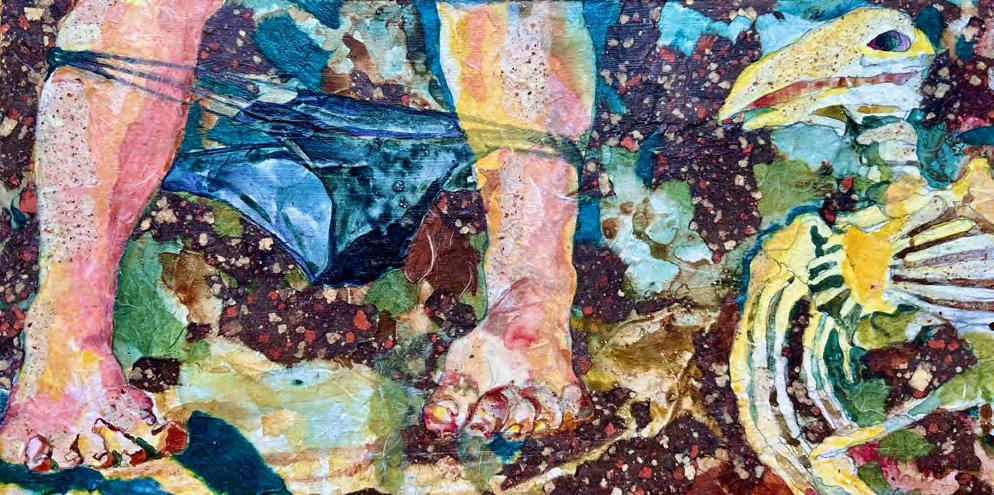
Skin And Bones
Paper, acrylic on board 12 x 24 inches, 2023, *gallery
Skin And Bones is part of my series, Nurture, which examines Ecofeminism: the connection between the degradation of the planet and the devaluing of women which has led to devastating conditions for both. In this piece, I aim to depict the vulnerability of women and nature—how obvious and absurdly, we cannot survive without them.
e-artgroup.com, Woodstock, Illinois
96
MICHELE SERCHUK

Pussy Grabs Back: Brave Girl #7053
Aluminum
16 x 24 inches, 2017/2024, *online
Pussy Grabs Back emerged in 2016 as a photographic vehicle to channel outrage and push back against fear engendered by an emotionally challenging political reality. My feline superhero Pussy lurks in the Gothams of America by night, defiantly challenging societal norms and political injustice, using slyly subversive humor to help her cope. These manifestations of Pussy are portraits of my subjects depicting their own unique inner champions of social justice and equality.
serchukphoto.com, New York, New York
97
MARY SHISLER
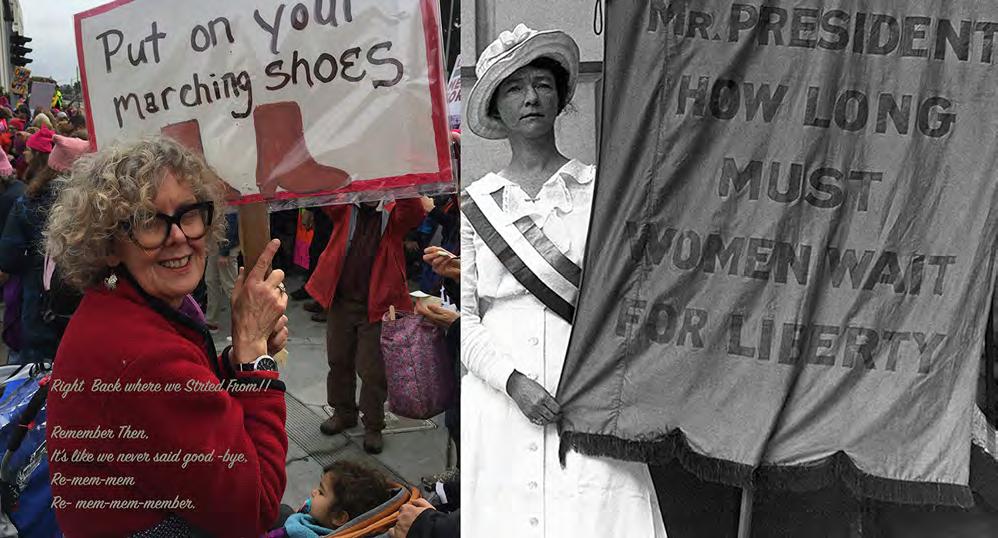
Right Back Where We Started From
Archival inkjet print on paper 21 x 27 inches, 2024, *online
We should never take our liberties for granted. Recollecting events of the late 60’s, tunes flowed through my head. This stood out—“Right Back Where We Started From.” Granted, the song is about love gone wrong, but the beat and sound grabbed me. I found an image from early women’s rights marches and placed it aside a photo of Kelly Hammargren taken at a women’s march in 2021.
marykshisler.com, Oakland, California
98
NINA SIDNEVA
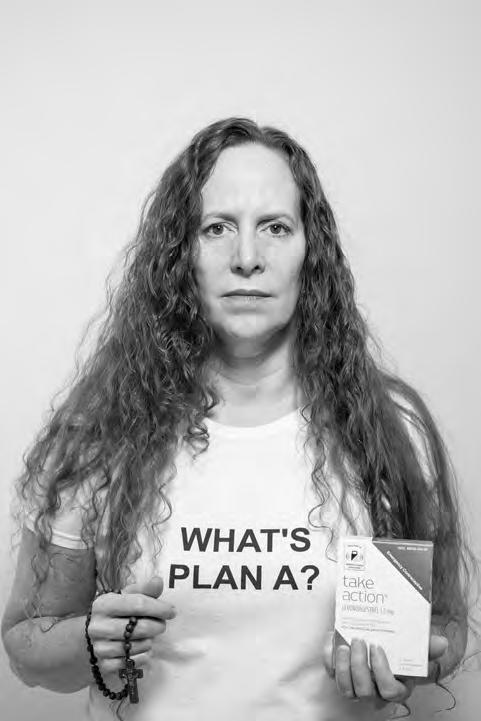
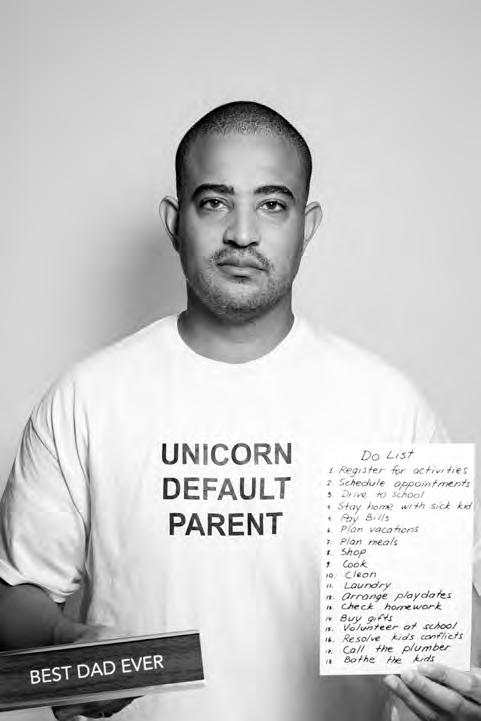
What’s Plan A?
Unicorn Default Parent
Photography on laminated gator mount 18 x 12 inches each, 2023, *gallery
What’s Plan A? addresses women’s reproductive rights in the U.S. When I hear about getting rid of Plan B contraception I wonder, “What’s plan A then?” Plan A can be Abstinence, Adoption, Calendar Method, Prayer. In Unicorn Default Parent I explore the notion that in a heterosexual relationship a mother is a default parent but there are exceptions. The term “unicorn” implies that it is rare or actually does not exist at all.
sashapluslydiaphotography.com, Seattle, Washington
99
BARBARA SIZELOVE
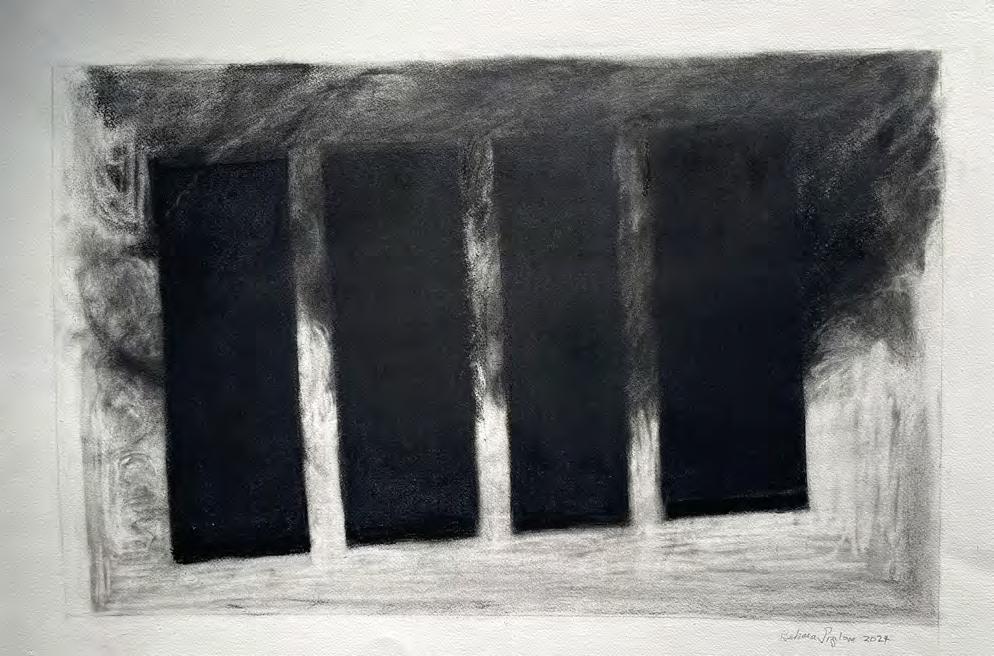
Can You Hear Me?
Charcoal on watercolor paper 24 x 30 inches, 2024, *gallery
“Silence is the ocean of the unsaid, the unspeakable, the repressed, the erased, the un-heard...” —Rebecca Solnit.
This charcoal drawing is from a series that speaks to the oppression of imposed silence and access to a listening ear. Visually the viewer is situated outside listening in, or inside listening out. No one is safe from censorship especially not women. Breaking the silence through speaking our truth and being heard can change the history of the future.
barbarasizelove.com, San Francisco, California
100
ANNE SKAUG
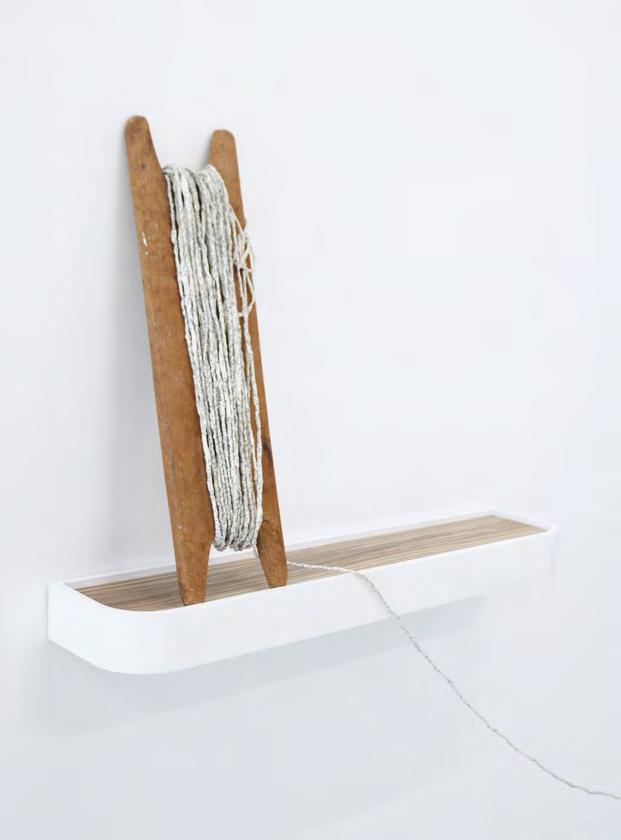
Mental Load
Found rope winder, book pages, glue, nail 17 x 4.5 inches, variable installation size, 2022, *gallery
A meditation on labor, domesticity, and transformation, Mental Load makes “invisible” labor “visible.” Employing the trance of repetition, I twisted dozens of book pages while mentally coordinating household demands: compiling lists, planning tasks, anticipating others’ emotions. The resulting artwork is a physical record of time spent actively laboring under the intangible “mental load;” labor typically assigned to female identifying persons in heterosexual relationships. The artwork is proof of the mental load’s accumulation, span, and pervasiveness.
annesart.online, Chicago, Illinois
101
ADRIENNE SLOANE
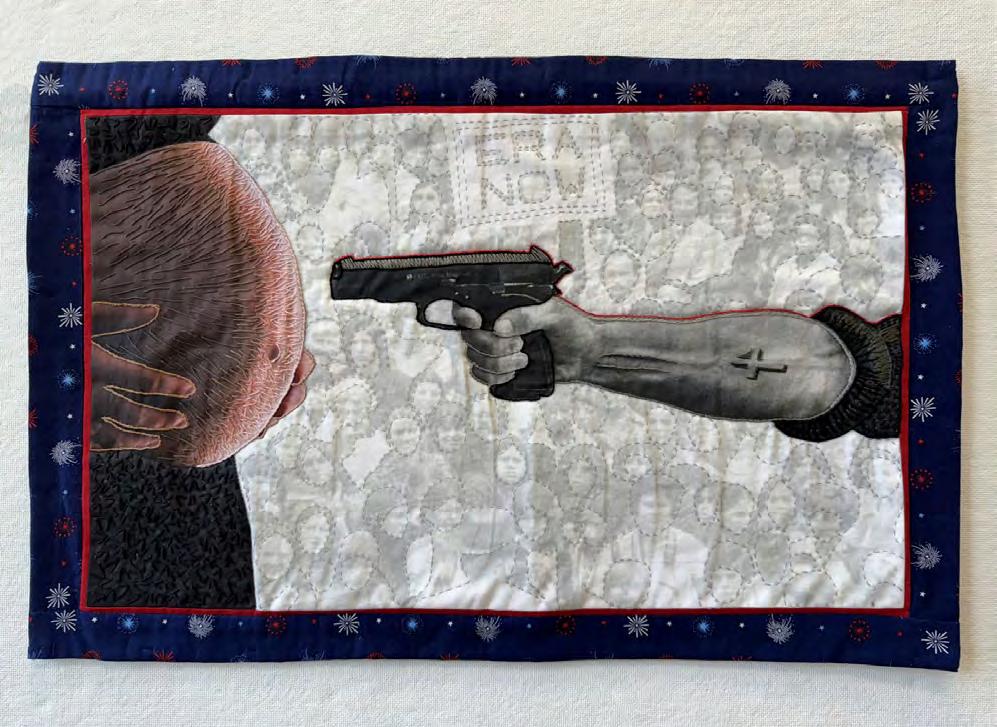
No Forced Labor
Quilted, embroidered 20.5 x 30.5 inches, 2024, *gallery
My work is a visceral response to the moral and political landscape of the day. By visually addressing the frayed and unraveled places around me, I am looking to promote thoughtful dialogue about critical questions. The imagery of No Forced Labor is as stark is as the current direct assault on the rights of women for their own bodily autonomy.
adriennesloane.com, Lexington, Massachusetts
102
DEENA SMITH
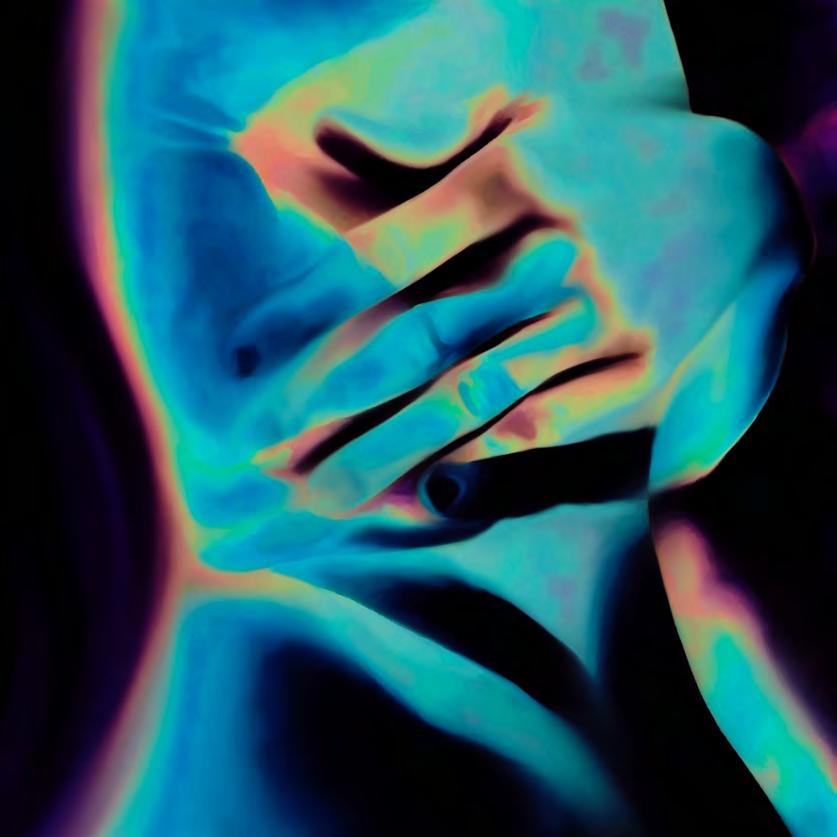
Holding Space
Dye infused aluminum with inset frame 12 x 12 x 1.5 inches, 2024, *gallery
Holding Space… I’ve always thought of this notion as sacred and very personal. As this piece came together, I was heavily inspired by an artist who was fearless in putting herself out there. The image reflects a deep knowing that one can offer to ‘hold space’ for another without all the pomp and circumstances or even blatant permission. Holding Space is an invisible gift from one person to the next. deenasanteart.com, Santa Rosa, California
103
DOBEE SNOWBER
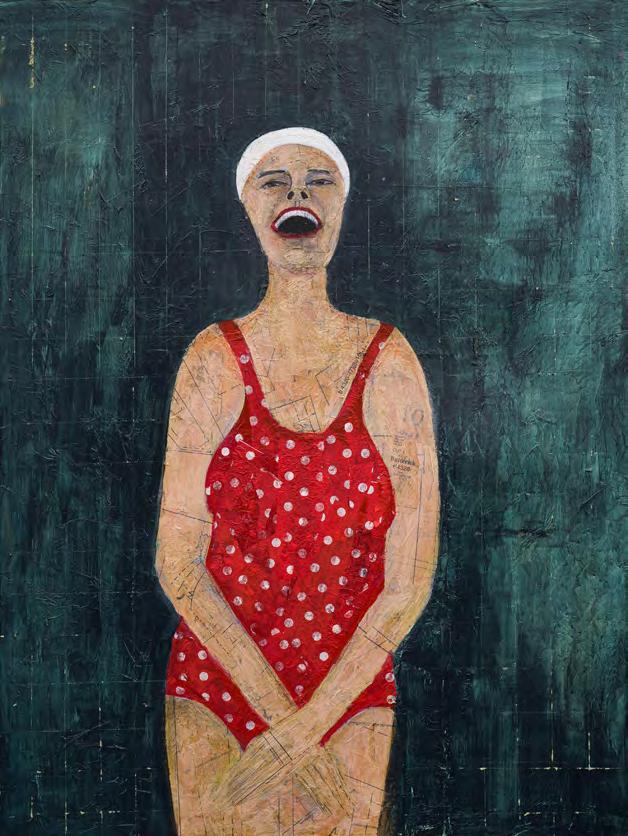
Last Laugh
Acrylic, tissue paper, pen, ink 48 x 36 inches, 2022, *online
In this world change is both incremental and ever constant. We, as women, have fought hard for and won access to many basic rights, and yet we simultaneously witness these rights we have fought for erode daily. My piece reflects these dichotomies, the big and small successes and failures. A glimpse of the balance between harsh reality and enduring stamina. Faced with these dichotomies what else can we do but keep on fighting—and laughing!
dobeesnowber.com, Berkeley, California
104
FLEUR SPOLIDOR

Social History of American Swimming Pools
Acrylic on upcycled materials glued on canvas mounted with thumbtacks on wood 72 x 36 inches, 2023, *online
This painting is part of a series called The Swimsuits series: A pictorial reflection on women’s rights. I was inspired by Dulcé Sloan’s segment on the Daily Show, “Dulsayin: What Happened to America’s Public Pools?” She was referring to Jeff Wiltse’s book, Contested Waters: a social history of swimming pools in America. This painting shows that since the civil rights movement, equal access to places of leisure has still not been achieved today.
artefleur.com, Rye, New York
105
IRENE SUH
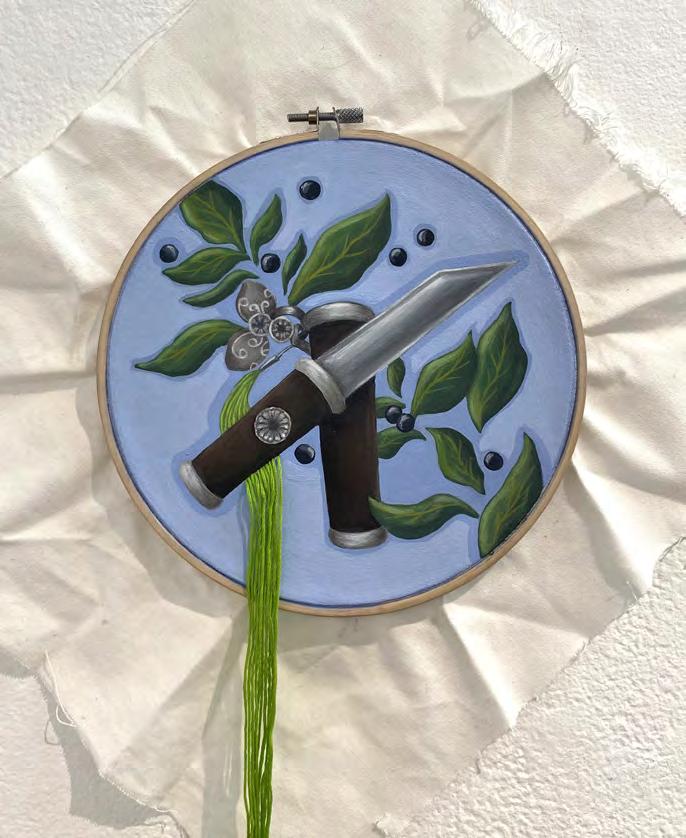
Eunjangdo
Acrylic and thread on gessoed embroidery hoop 10.5 x10.5 inches, 2022, *gallery
Defined as “Silver Knife”, the Eunjangdo serves a decorative and protective purpose for its owner. My painting highlights its feminine power in overturning the notion that historically views Asian women as docile and passive. Women’s craftsmanship, especially in embroidery, has been downplayed as “housework hobbies.” However, I see it as an artistic expression in itself. There is strength in an Eunjangdo not as a weapon, but because it is owned by a woman.
iirbee.com, San Jose, California
106
ELIZA THOMAS
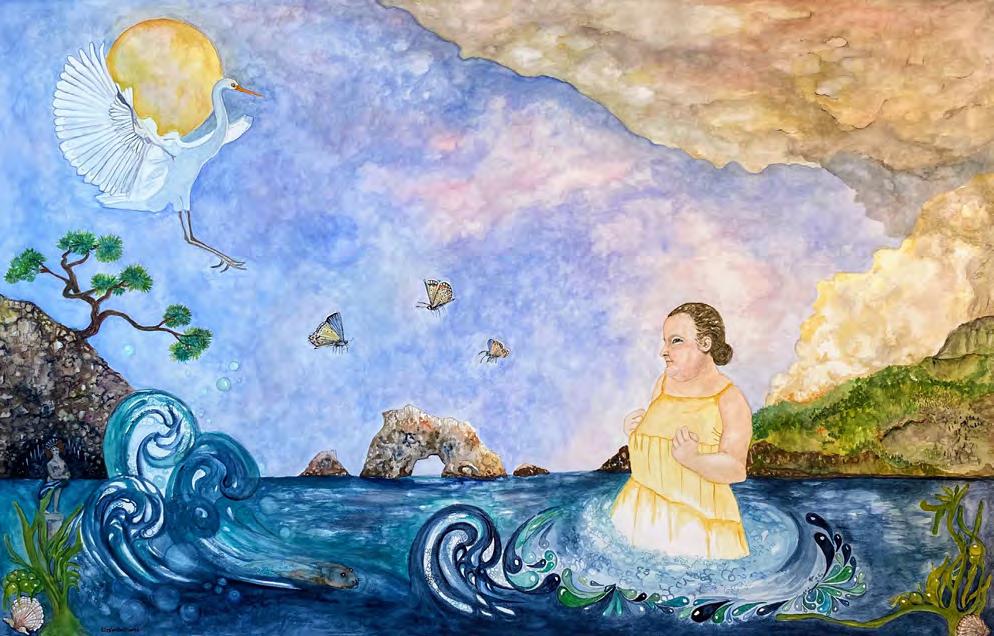
Seeking Sanctuary
Watercolor on paper, framed with repurposed wood 32 x 47 x 1.5 inches, 2023, *online
This painting is about dodging the effects of climate change while caring for a severely disabled person. I painted this as fires swept Maui. People escaped into the sea. Some swam to safety, others, elderly, or disabled, perished. That week I was traveling with my disabled daughter, on the coast of Oregon. We were in a remote region, sea on one side, trees on the other side, forest fire blocking the highway. We made it out.
elizasarts.com, Menlo Park, California
107
RACHEL TIROSH

Golden Years
Mixed media, acrylic paint, gold leaf, 12 x 9 inches, *gallery
My perception of ACCESS focuses on aging and advocacy for women nearing retirement. The painting’s rough texture and pinkto-gray transition symbolize the passage of time, capturing the struggle to balance societal norms with amplifying women’s voices as they navigate the complexities of the “Golden Years.”’ It draws attention to the average retirement age for women in the US (62.3) and questions whether women artists can fully retire, reflecting on age and autonomy.
racheltirosh.com, Sunnyvale, California
108
HWEI-LI TSAO

Double Happiness
Oil on board
16 x 24 inches, 2023, *online
In China since ancient times, red signifies happiness for the bride and groom on their wedding day. Three Obediences ruled her life: first to her father, then to her husband, finally her eldest son. This traditional bride covers her face from when she leaves her family until the groom lifts it off. She waits alone in the bridal chamber while he entertains the guests. At last his stick opens the veil; her second obedience begins.
hweili.com, San Anselmo, California
109
LI TURNER
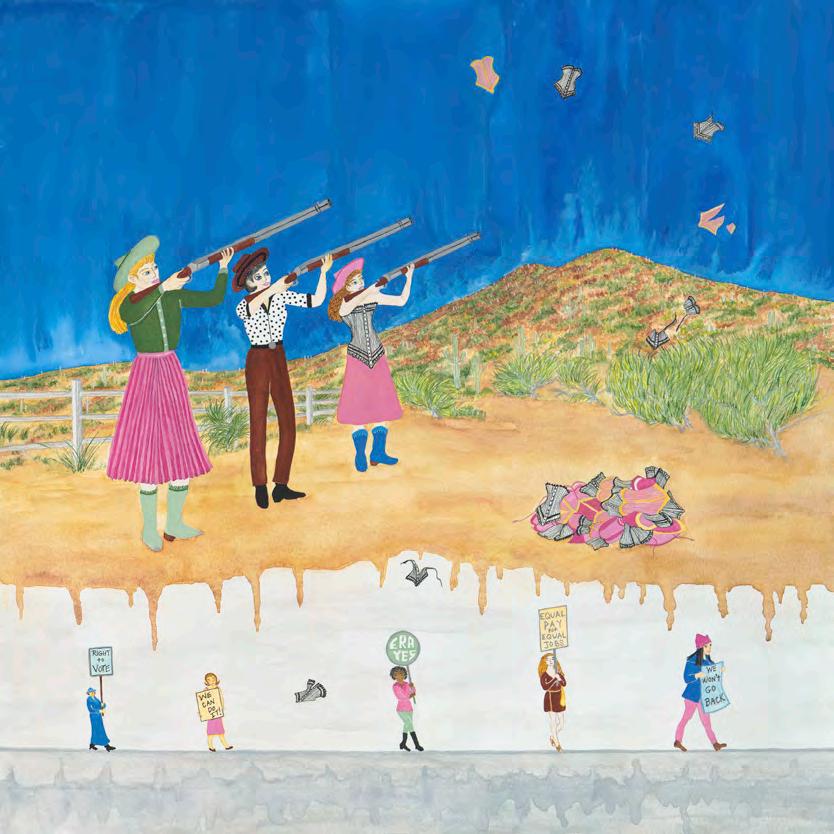
Annie Oakley and Friends Shoot Down Oppression
Watercolor and gouache 18 x 18 inches, 2022, *gallery
My frustration is often masked with a little humor. I started this painting with the idea of using corsets as a symbol of oppression. The work grew to include my anger, expressed by painting women friends shooting the corsets out of the sky, while suffragettes to pussy hat demonstrators march across the artwork depicting over 100 years of resistance. I believe we must keep defeating oppression with like-minded people until the ERA is passed.
LiTurner.com, Seattle, Washington
110
WINNIE VAN DER RIJN

As My Rights Are Washed Away / My Body Is A Sovereign Nation
Repurposed menswear, hand forged uterus, water soluble substrate 28 x 29 inches, 2023, *gallery
I am constantly trying to reconcile my leftist Berkeley education and deeply feminist outlook with my military upbringing. Equality and Freedom are core to my system of beliefs. Neither is possible without Bodily Autonomy. The (unfathomable) Dobb’s decision motivated me to start making uterine armor. We must be battle ready. We cannot allow our rights to be washed away. In this piece, the falling dissolved stars represent the states that are limiting access to reproductive choice
winnievanderrijn.com, Cambridge, Massachusetts
111
DIANE WARNER-WANG

Woman X
Charcoal, acrylic, oil 16 x 16 x 1.5 inches, 2023, *gallery
Equality under the law is not a privilege, granted selectively, but a fundamental right that should be extended to all, regardless of gender, race, or socioeconomic status. Yet, for the almost invisible woman, the barriers to justice loom large, casting shadows obscuring her very presence. This principle often remains elusive, a distant promise that flickers but never fully illuminates her path.
dianewarner-wang.com, Palo Alto, California
112
LIN WEI
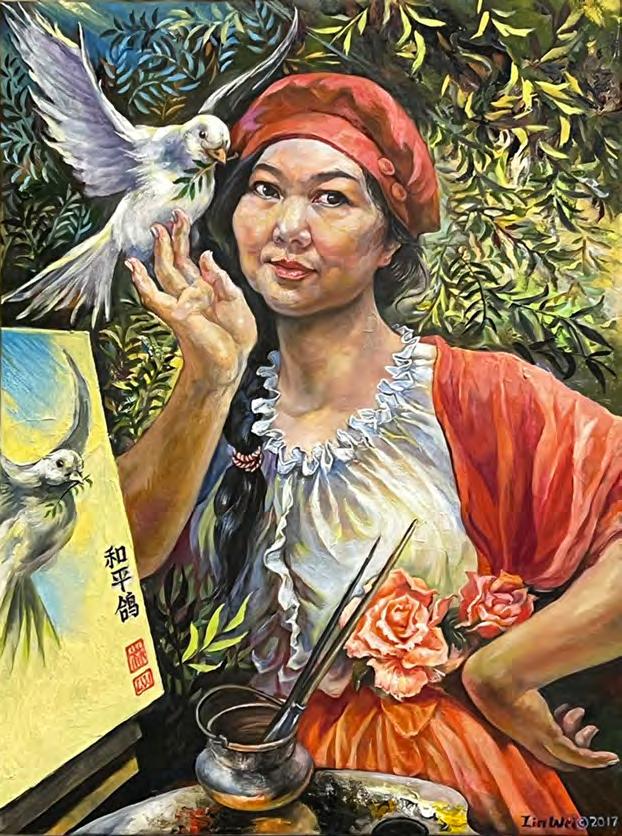
The Dove Oil on canvas
24 x 18 inches, 2017, *online
I hear about wars between countries, and I see conflict between people; it hurts so much. The world is big and people are all different: different cultures, skin colors, genders and sexes, different religions and lifestyles. Is it possible that they could all get along? In this complicated world, I am only a painter, and my ordinary notion is simply peace, like the magic of a happy ending.
art4sfgallery.com/landscape, San Francisco, California
113
MIRA M. WHITE

It’s an Uncomfortable Time
Watercolor on paper 14 x 11 inches, 2022, *gallery
My watercolor, It’s An Uncomfortable Time, is one of three pieces that materialized in quiet moments during Covid in 2022. I was trying to record, in a combination of narrative abstraction and representation, my global concerns for humanity. This piece used a combination of handmade stencils, watercolor sprays, and delicate line work. Burning the edges of the paper was a final move that seemed appropriate.
miraMwhite.com, Walnut Creek, California
114
TANYA WILKINSON

Necessary Tattoos
Satin, velvet, kid leather 36 x 42 inches, 2022, *gallery
In Necessary Tattoos each glove is printed with a quote from a Feminist activist. This piece continues my interest in using the accoutrements of conventional femininity to subvert those conventions. In this instance, the white gloves “respectable” women had to wear at one time in Western culture are tattooed with radical sentiments that every woman might find useful to keep in mind as she strives for access to what she needs. My personal favorite: “Call me whatever you want. It won’t stop me.” —Emma Watson
tanyawilkinson.com, San Francisco, California
115
JANE ZICH
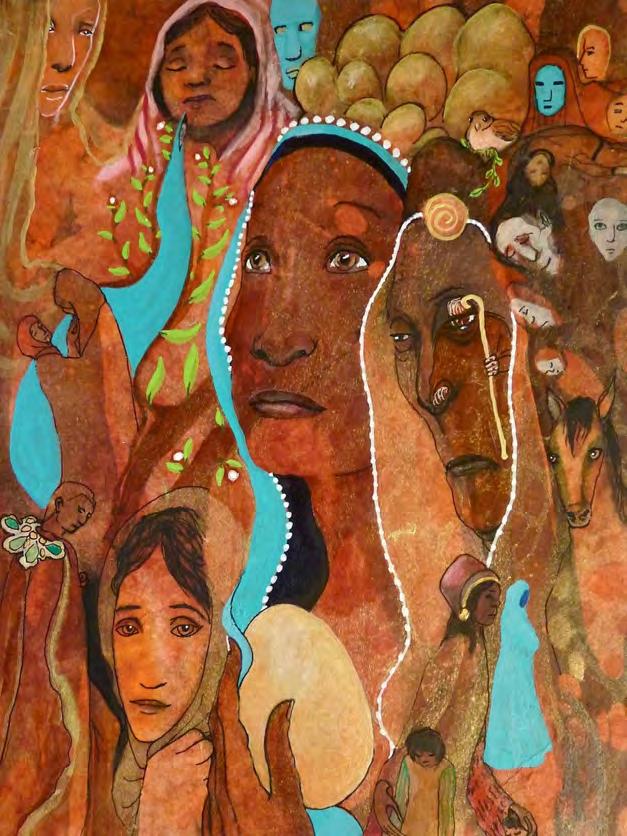
Choices
Acrylic on marbled mulberry paper 16 x 12 inches, 2023, *online
Choices explores the yearning and grief associated with society’s interference with access to choices, particularly for women. Choices in education, employment, health care, political elections, and sexual relations support the ordinary human needs for self-expression, autonomy, and empowerment. I am especially intrigued by ways images of the human face can evoke and foster compassion. For this reason, emotionally expressive faces often hold a central place in the dynamics of my paintings, as in Choices. zichpaintings.com, Fairfax, California
116
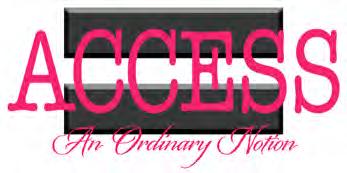
ACCESS’ Curatorial Team and NCWCA
Present two important interviews
Molly Gonzales
Advocacy Manager
Alice Paul Institute &
Deborah L Hughes
President & CEO
Susan B. Anthony Museum & House
Interviewed by Sherri Cornett
Artist, Activist, Writer, Curator
117
A Conversation with Molly Gonzales Advocacy Manager, Alice Paul Institute
By Sherri Cornett

The parallels between Alice Paul (18851997) and Molly Gonzales are palpable, as if I were getting a real time connection to Alice’s world. Both pursued several educational paths and were curious and motivated to acquire knowledge and skills to support their passions for human rights… Alice had 3 law degrees. Molly studied gender, sexuality, and women’s studies and political science and non-profit management and women’s history and became an archivist! Both started their advocacy work as young women.
Beyond the museum in Alice’s family home in southern New Jersey, her history and archives, the Alice Paul Institute offers leadership development and civic engagement opportunities for all ages. It is an ever-evolving institution that holds itself as a model of adaptive use of a historic site.
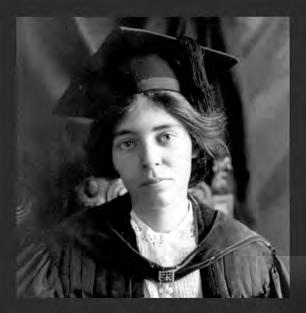
Molly’s path provides inspirational guideposts for other feminists and this conversation was both exuberant and hope-inducing! Check out the many links for further information.
Sherri Cornett: I see on the API web page about Alice that she was raised as a Quaker, as was Susan B. Anthony, and was instilled with the tenet that genders were equal.
Molly Gonzales: Yes! After starting at Swarthmore College, which was founded by Quakers and was co-ed, in 1901, she moved to London, where she became friends with and fought along Emmeline Pankhurst, England’s most militant suffragette, and her daughter Christabel. I love looking at the early photos of her in her midtwenties—they are so inspiring. She was already breaking windows, getting arrested and going on hunger strikes.
SC: I won’t ask if you have done anything similar… but, tell me about the path that led you to API?
118
Molly Gonzales
Alice Paul at graduation
MG: I studied gender, sexuality, and women’s studies alongside political science in college and went on to work for my master’s degree in human rights. I would say that is the path I was on, to take seriously women’s stories through dedicated scholarship. Women’s history is what radicalized me. In my other history classes, women were completely erased. We don’t hear their stories.
SC: It is frustrating to hear that this is still happening.
MG: Right. Maybe we know about Susan B. Anthony and some of the first ladies, but not the actual female architects of this country. Or how they were also in those rooms or at least influencing those rooms. So, a lot of people think women were just not there.
SC: Would you connect the dots between your human rights focus and your archivist experience?
MG: Yes, when I was working on my master of arts in human rights at American University, I also worked as a graduate student archivist. I see preserving of marginalized voices, their history—cataloging them and digitizing them—as a practice of humanitarian work, particularly with women’s history. Kate Eichhorn’s The Archival Turn in Feminism: Outrage in Order changed everything for me. She talks about the cutting room floor of history, particularly the feminist scrapheap, and how women have been tossed aside, but… they’re still there. You just have to look for them.
So, I spent two years digitizing, processing myriad collections related to women’s history. There were hundreds of boxes of unprocessed materials. I wondered what other countries were doing? And through that, I was like, my goodness, the U.S. is miles behind all of these other democracies. We don’t have an ERA when many countries codified gender equality in some meaningful way after WWII and the US is one of only eight countries to not sign CEDAW (Convention to End Discrimination Against Women).
SC: It is indeed alarming to have this broader perspective, and necessary. I was a UN Rep for the Women’s Caucus for Art and came away from conferences reminded that we can be so myopic in this country.
MG: My goodness, yes, even though we say we are a liberal democracy, a progressive country… The only way that women have been able to get protections—suffrage, Title Nine—was that women like Alice Paul and Patsy Mink and Shirley Chisholm demanded them.
119
As an archivist, I was like, we have to preserve women’s voices. But there are thousands of collections sitting in boxes, in people’s attics, the dust of history. So, when I focused on marginalized voices, women’s voice, the work became a human rights practice.
And, all of this came together for API. It’s a dream position. I get to advance women’s history!
SC: Your enthusiasm and passion are contagious, Molly. Would you talk about goals or new projects for you and your position as Advocacy Manager? The Institute seems to be always evolving.
MG: Yes, we are definitely in a transitory stage as we address the effect of Zoom school during COVID and the analysis paralysis students have because of so many social issues going on. Will they have the bandwidth to care about the ERA?
And, they do! I lead field trips and presentations with them. We talk about the many ways the ERA would solve many of our society’s problems. One of my favorite archival resources is Harvard’s Schlesinger Library (considered the leading center for scholarship on the history of women in the US), which lets them look at and compare images of archival material. One of Alice’s advocacy strategies was to make giant charts of all of the different civil rights and liberties. I like to show them how women were doing advocacy and research, pre-internet, cell phones… how research and education can be tools for feminist liberation. It is exciting to see them get jazzed up.
SC: And, gives us hope for our future!
MG: Yes! The Girls Leadership Council is one of our biggest programs. We focus on how to get the next generation of girls, teen feminists, to believe in themselves, to have the skills to get to the next level of their careers and their lives, and also how to advocate safely and be politically minded adults.
It’s a safe space to talk about issues impacting them, to work through political ideas, take on service projects, learn more about women’s history and social justice. And, the girls lead the projects. In January, they had a Period Product Drive and put donation boxes in libraries and schools and other public spaces. It was incredibly successful. Girls wanting other girls and women to menstruate with dignity… And, it was inspired by the things Alice did as a young woman.
SC: Any anecdotes from the Institute, particularly about reaching kids?
120
MG: Yes! This spring break, a mother came in with her two daughters. All the way from Indiana. They were talking about book bans back home, where the mom had to sign a form for her kid to read a book about Alice! The mother was like, you’re kidding me, right?
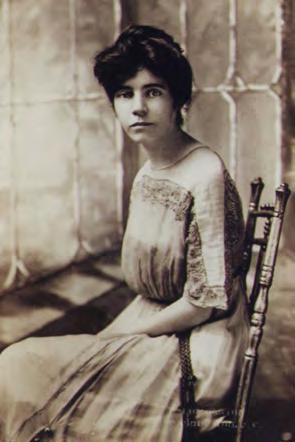
We talked about how many parents wouldn’t get around to signing a form or kids might be too embarrassed to ask them—more roadblocks to learning about women’s history. But, that interaction with the mom and her daughters was magical. Those daughters said they love Alice, her story and want to learn more about women’s history. They don’t have a museum there, so this work feels really pressing right now.
SC: Could you talk about how the Alice Paul Institute is responding to some folks writing off Alice because she said and did things then that would be called out in our current awareness. What’s the language around how you adapt that?
MG: Yeah, that’s a really good question and something that we get asked a lot.
In recent years, the organization has updated our permanent exhibit to reflect the more diverse voices that were a part of the suffrage movement, specifically highlighting the black suffragists who were there, despite the all too frequent narratives that whitewash the suffrage movement. Women like Ida B. Wells and Mary Church Terrell.
Alice did make some wrong choices… she excluded Black women while organizing the 1913 Suffrage parade in Washington DC. Sometimes folks like to say, “Well, the times were different,” but we like to remind them that she still made that choice. A choice that had incredibly harmful consequences. But human beings are more complicated than their worst mistakes, and while she wasn’t inclusive during this action, it doesn’t mean she didn’t lobby the U.N. to get gender discrimination included. And The Universal Declaration of Human Rights. It means she was a complex person. And, by telling her story in its entirety, the messy details, it really helps us have
Alice Paul
121
these hard conversations about feminism, racial inequality and class. Conversations that can produce new, exciting modes of feminism and conversations that help us learn from the mistakes of past feminists to ensure we do not make them again.
In the vein of looking at Alice as a whole person… she was staunch, super-educated and she didn’t have a lot of patience. She wanted things done fast. One of my favorite Alice moments is after the 19th Amendment was passed, when the National Women’s Party released a statement with Alice saying that of course, celebrate now, but don’t you dare rest! You thought you are all going to bed? This is just the beginning.
And, two years later she wrote the Equal Rights Amendment. She was in her mid-30s.

So, I think our position is let’s not shy away from her mistakes. Let’s talk about them. That provides a more interesting, intersectional discourse that otherwise wouldn’t exist.
SC: Would you tell me how the Institute was started?
MG: Of course! The founding of our organization can be traced by to 1984 when women in the South Jersey NOW group wanted to celebrate Alice’s 100th birthday—she was born in 1885 and died in 1977 at the age of 92! That is insane given how many times she was force fed, went on hunger strikes, was beaten by the police, and put into solitary confinement. At the same time, Alice’s possessions went up for auction. So, they bought her things, the entire lot, all of her papers and then her house! They weren’t trained in historical preservation or archives, but their passion and dedication to women’s history and the feminist movement meant they learned along the way. When API opened, it was already offering more expansive programming than just field trips and museum tours.
SC: The API is part of a larger coalition, right?
MG: Yes! The ERA Coalition has over 200 feminist and gender organizations, government and non-government agencies,
122
employing different strategies, pooling resources. We were one of the first to join. Our angle is providing the history of advocacy. The Coalition has monthly partner calls to update and support each other. What is really special is to hear about women in red states, who are fighting for women’s lives. Particularly with states that have abortion or ERA on their ballots this year.
SC: Would you like to talk about the status of the ERA?
MG: In 2020, Virginia became the 38th state to ratify the ERA, officially completing the proceedings of Article V of the Constitution, which is basically the instruction manual for the Constitutional amendment ratification process. However, Trump’s DOJ sent a memo to the National Archivist instructing him not to publish the ERA and that the time limit set on the amendment back in the 1970s, meant the ERA had “expired.”
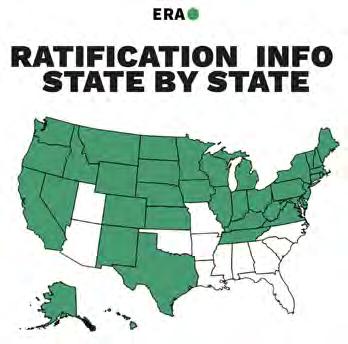
Right now, there are a handful of bills working their way through the house and senate to further the ratification process of the ERA. S.J Res 4, sponsored by Senator Ben Cardin, is a resolution to remove the arbitrary deadline put on the ERA in 1972. H.J. Res 25, sponsored by Representative Ayanna Pressley, is the house equivalent legislation. S.J. Res 39, sponsored by Senator Kirsten Gillibrand, is a resolution expressing the 28th amendment, known as the ERA, is valid. H.J. resolution 82, sponsored by Representative Cori Bush, is the house resolution also calling for the validity of the ERA.
Now the push is to show that the ERA is incredibly popular. Current polls show that 70% of Americans support it.
SC: How can readers stay informed?
MG: Another of our advocacy projects is our bi-weekly newsletter. Folks can sign up via the form at the bottom of the Equal Rights Amendment website. We have around 6000 subscribers all over the country. Some of them have been fighting for the ERA for decades! I update them as to where the ERA was in the news this week, nationally and by state. Because, while the ERA is not federally
123
ratified, 38 states have one in their constitution. The Pennsylvania Supreme Court recently invoked the ERA to protect abortion access. It’s mind boggling and incredible and amazing! And, shows that the ERA can really protect us. It sets a precedent.
I just started a column What Does the ERA Mean to You? We get many diverse responses. Not everyone is a feminist organizer. And they see different things in the ERA … it can help with gender justice, class, race, ethnic boundaries, protecting someone who is queer…
SC: This is all such inspiring information, Molly! You definitely seem to be following in Alice’s footsteps! Thank you for spending time with me!

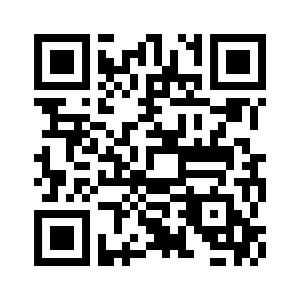
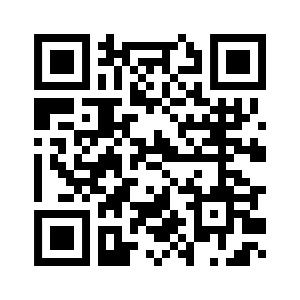
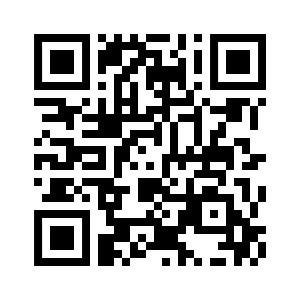

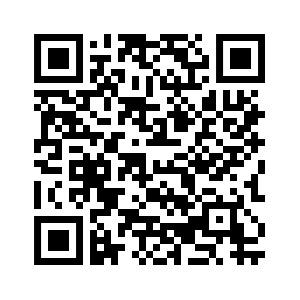
Feminism ERA
Learn more about Alice Paul
Coalition Partners
API Newsletter Signup Schlesinger Library
Pauldale in Snow
124
A Conversation with Deborah L Hughes President
& CEO
Susan B. Anthony Museum & House
By Sherri Cornett
Though there are now informative and engaging books and podcasts* about Susan B. Anthony (1820-1906), the depth and breadth of Anthony’s contributions, as with so many women who helped form this country, are not easily found in textbooks. For a more complete understanding, folks from all over the world make the pilgrimage to the National Susan B. Anthony Museum and House in Rochester, New York.
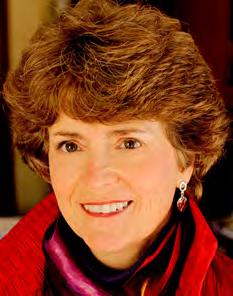
The Anthony Museum’s President and CEO Deborah L. Hughes shared that the museum’s mission is directly tied to a reflection Anthony made when talking with family about her eventual demise: “When I am gone, let there be no tears… pass by, and get on with the work.” The inspiring stories and history, which Deborah shared with me below, make evident that this directive, Anthony’s legacy, and the programs is has birthed, continue to influence and activate children and adults to envision and work for a more just and equitable world for all. The museum encourages visitors to learn more to find their own spark of motivation. As Anthony proclaimed, “Organize! Educate! Agitate! must be our battle cry.”
Sherri Cornett: Deborah, it seems that one has to barely open a book about Susan B. Anthony or walk in the door of her house, now a museum, to become inspired. Her life was so full with activism!
Deborah L. Hughes: Yes! The four values that Susan B. Anthony and her family held dear, and which inspire us at The Anthony, are embossed in granite on a pillar at the family gravesite here in Rochester.
The first two are Equality and Humanity. Anthony believed that every human being has the same essential worth, value, and inalienable rights. No exceptions.
The third is Liberty. Anthony believed that no person should be under the ownership, control, or power of another. There are no contexts in which involuntary control of another can be asserted to
* See QR code links at end of this interview.
Deborah L. Hughes
125
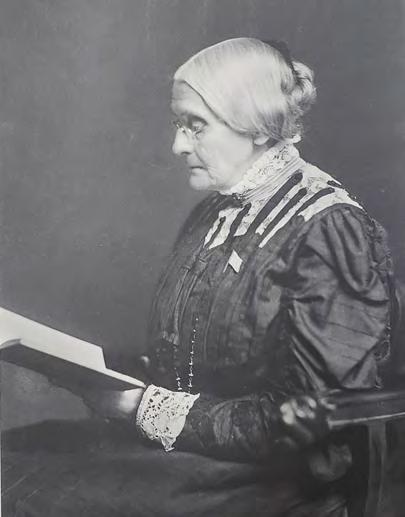
be for the benefit of the oppressed. She would apply this to freedom of thought,freedom of speech, freedom of expression, freedom of religion, freedom of relationship, and freedom of choice in all personal matters of body or conscience.
The fourth is Justice. While Susan B. Anthony had enough respect for the law and hope in the U.S. Constitution to spend decades of her life working to change the world through those channels, she had no respect for laws that violated the first three values of humanity, equality, and liberty. She regularly engaged in civil disobedience to expose an unjust law, whether it was the trafficking of human beings, the violence inflicted on women and children, unfair or disparate wages, or access to education, food, housing, jobs, health care, or the ballot box. She was denied a fair trial after voting in the 1872 election; she may be the only felon to be convicted in a federal criminal case without the benefit of jury deliberation. She held justice to the highest court of life, liberty, and the pursuit of happiness.
SC: How did Anthony and her sister activists get other people to learn about these values, to understand them and take action?
DLH: Anthony and other social reformers understood the power of image, art, and song to raise the conscience and compassion of the public. They understood what the “powers-that-be” have always understood: the inertia of apathy and indifference is a bulwark against any movement for social change.
Anthony and Elizabeth Cady Stanton published a magazine and named it the “Revolution” because they wanted to call attention to the ways in which our country’s policies and laws were in direct contradiction to “life, liberty, and the pursuit of happiness” espoused in the Declaration of Independence. Government, she firmly believed, must be of the people, by the people, for ALL the people.
126
Susan B. Anthony
SC: Would you tell me how The Anthony Museum’s programming continues this work?
DLH: We have and have had many wonderful programs, particularly for the neighborhood kids. In an afterschool program, the house became like a one-room schoolhouse, with kids from 5-16 years old, some of whom stayed with us for many years and became amazing storytellers about Anthony’s life. One of my favorite programs is called Change It. Due to Common Core Standards, second graders are introduced to the idea of social reforms.
SC: The Common Core set that up? That is impressive!
DLH: Yes, we thought it was a bit early, but these seven-year-olds truly get the idea that when Anthony saw things that she didn’t think were right, she wanted to fix them. The students get to pick something they want to fix… sometimes it is something profound, sometimes it is a simple change in the school. They learn about how Anthony advocated, from speeches or petitions or protests and they decide how they are going to advocate. It is so uplifting to see these second graders marching up and down the street chanting for something they believe in.
SC: How about for adults?
DLH: Another program we loved was called Women in Transition, which was based on Anthony’s efforts to push hearts to a place of really understanding the value of each human and the importance of the freedoms for our communities, to really connect with each other. These women were in some form of residential treatment… substance abuse, domestic violence, veterans with trauma… We encouraged them to journal and talk to each other, to share their stories.
SC: Is there a story that stands out for you?
DLH: Yes! One day I saw a woman in the lobby wearing her graduation regalia and her master’s program hood. She said she had been homeless and had a lot of issues, but then joined our Women in Transition program, which helped her decide to get somewhere else in her life. She had just graduated with a master’s in marriage and family counseling and wanted to come by and say thank you for helping her turn her life around.
SC: Ahh, that is heart-warming. We all need to hear more stories
127
like that! I read that Anthony was raised as both a liberal Baptist and Quaker. How did this inform her work?
DLH: Her father was Quaker and her mother was liberal Baptist. Most of her time in Rochester, she, her mother and her sisters were actually members of the Unitarian Church, where they thought the future was better and there was less hypocrisy. So, she was shaped by many traditions. One take from the Quaker culture was the idea of there being no authority except truth, which comes from personal responsibility—the idea that every human being has the same light from the eternal inside of them.
It’s also important to note that, during Anthony’s lifetime, many people believed that women didn’t have the capacity to think, that thinking would harm them. When she was 11 years old, Anthony was told that she couldn’t learn long division because putting too much exercise on the brain would discourage the growth of her other muscles!
SC: That is astounding! Anthony was so multifaceted in her activism— beyond suffragism. And, she wasn’t just working for the rights of white women…
DLH: That is correct. Some folks think of Anthony as one of the white, sometimes educated, women of leisure marching in white dresses in the Mary Poppins movie. People don’t realize that the real pioneers, who opened up the women’s rights movement in the 1820s and 1830s, were multiracial. That many were first abolitionists and listened to and read the abolitionist thoughts of William Lloyd Garrison, who published The Liberator, the widely read anti-slavery newspaper, and others who talked about the inherent rights of the human person and that women should have those rights also. And, that the movement was influenced by indigenous cultures, such as the Haudenosaunee, within which women and men carried the burdens of community equally.
Anthony worked with Harriet Tubman and Sojourner Truth. These were not just people working at the same time. They were in the same circles, agreeing and disagreeing on strategy, but wanting to lift up all voices.
And, there was Frederick Douglass. Douglass was a guest at many of the suffragist conventions, including the Women’s Rights Convention, where Anthony would escort him to the dais. Not many men were at the front of these events. He was a big proponent of
128
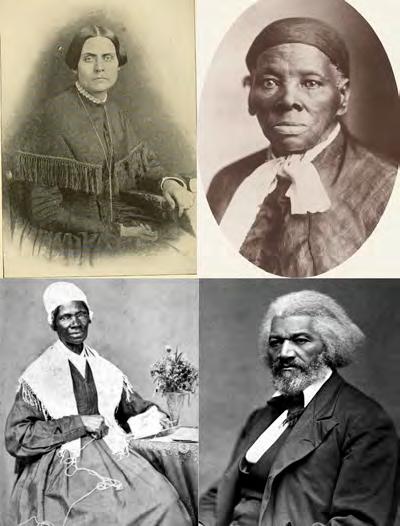
getting people educated so they weren’t complacent about issues. There is a bridge named after them in Rochester—the Frederick Douglass–Susan B. Anthony Memorial Bridge or, affectionately, as the Freddie-Sue Bridge.
I think Anthony would be the first one to tell you that every person’s work is as important as every other person’s. So, there was a lot of cross-pollination.
SC: Would you talk about Anthony’s lasting influence on women’s votes?
DLH: There is a photo of Alice Paul kneeling at Anthony’s grave. That has become a tradition on election day. Women will go up to Hope Cemetery—a gorgeous Victorian cemetery—to pay tribute to Anthony and put their I Voted sticker on her grave. We had over 10,000 people come on the day of the 2016 election! People were waiting for sometimes 2-3 hours. There was something almost sacred about it, Sherri. People were so gentle with each other. No one was in a hurry. Each person was given time to take in the significance.
SC: That gives me chills! And, hope! I want to provide our readers with as many resources as possible, to help them with becoming
Clockwise from top left: Susan B. Anthony, Harriet Tubman, Frederick Douglass, Sojourner Truth
129
activated, to have hope. Do you have some more to offer?
DLH: Yes, it’s mind boggling that you have to work to find the information. Even back then, Susan B. Anthony, Elizabeth Cady Stanton, Matilda Joslyn Gage and Ida Husted Harper realized that this history needed to be recorded. They published the six-volume History of Woman Suffrage, with all the speeches and background. You can read and feel these incredible voices that are still so timely.
SC: I see a link on your website to the She Votes podcast, by the award-winning journalists Ellen Goodman and Lynn Sherr.
DLH: Both those women have a longstanding connection with our institution. And, have had several projects to bring forward Anthony’s history and that of the suffragist movement. Lynn wrote perhaps the best contemporary book about Anthony titled Failure is Impossible: Susan B. Anthony In Her Own Words.
We are also about to take over a website Women and the Vote New York. It includes the film Women & the Vote and a clip about Election Day 2016, with footage of folks putting their I Voted stickers on Anthony’s grave!
Another must see is Iron Jawed Angels (2004), with Hillary Swank as Alice Paul, which highlights the treatment of women in prison, including the force-feeding.
And, of course, we encourage folks to come to Rochester to learn even more!
SC: Thank you, Deborah, for your time and to The Susan B. Anthony Museum for partnering with this exhibition, ACCESS: An Ordinary Notion!
DLH: The Susan B. Anthony Museum is honored to be a sponsor of this exhibit, which boldly picks up the challenge. ACCESS: An Ordinary Notion provides an organized platform through which a variety of artists can express powerful feelings about the ERA (or lack thereof), and they can do so through a variety of media. This exhibit will draw an audience together in a particular place and time for a shared experience that will provide stimulation, education, and perspective. We believe this exhibit has the power to stimulate energy and compassion that will awaken hearts, renew commitment, and fuel the work that is yet to be done. Susan B. Anthony and Frederick Douglass called this kind of opportunity an “Agitation.”
130
In addition to the exhibit itself, this catalog will bear witness to the expressions of the organizers and artists. While it celebrates and records a particular moment, this catalog also has the potential to continue the work as it is passed from hand to hand, and generation to generation.
In this democracy, it is ridiculous that we have to clarify that no person should be discriminated against on the basis of their gender. It is outrageous. Let’s Organize! Educate! Agitate!

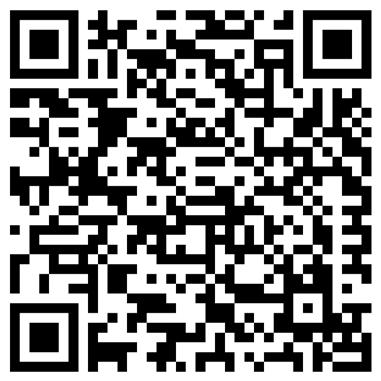


 The Women and the Vote New York State
The National Susan B. Anthony Museum and House
She Voted Podcast
History of Woman Suffrage
The National Susan B. Anthony Museum and House
The Women and the Vote New York State
The National Susan B. Anthony Museum and House
She Voted Podcast
History of Woman Suffrage
The National Susan B. Anthony Museum and House
131
ACCESS’ Curatorial & Writing Team
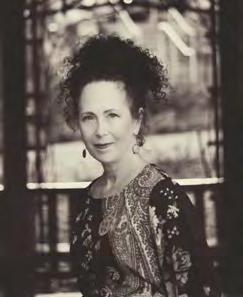
Elizabeth Addison MFA is a Berkeley, California-based, visual artist, curator, and educator whose works are included in numerous private and public collections. Addison’s practice encompasses printmaking, mixed media, digital media, and immersive installation. She records images on her daily walks and transforms them into mandalas of ‘the one… the universe.’ Her work ranges from examining California’s native flora and last wild river to social justice and environmental equity. Addison exhibits throughout the West Coast and nationally. She is an Artist-in-Residence at Kala Art Institute, Exhibitions Chair for the Northern California Women’s Caucus for Art, and Creative Director for the Bay Area Women Artists’ Legacy Project.

Karen M. Gutfreund is an independent curator with a focus on feminist and social justice art. She has worked in the Painting & Sculpture Department at MoMA/New York, as well as in numerous galleries, has served on the boards of art organizations, is a member of ArtTable, and is a representative for The Feminist Art Project. Gutfreund has created more than forty national exhibitions—most recently Agency: Feminist Art and Power at the Museum of Sonoma County. A partner in Gutfreund Cornett Art—a curatorial partnership with the motto “changing the world through art,” that creates national touring exhibitions. Gutfreund splits her time between Sonoma County and her ranch near Yosemite.
132
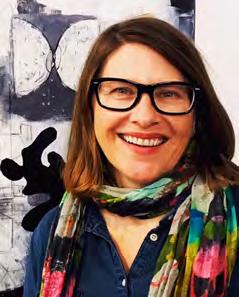
Influenced by landscape, both literal and cultural, Meghan Lewis MacLeod Ph.D., a queer, mixed media, abstract painter, delves deeply into transpersonal terrains wherein unseen inspirations take shape. Her interest in ecofeminist iconography led to studies in art and psychology at the University of Michigan. After completing her doctorate at the Institute of Transpersonal Psychology in perinatal mental health and creative expression, Meghan became the founding Director of the LGBTQ Perinatal Wellness Center. Since resuming painting full-time, she has become an award-winning, published, collected, and commissioned artist showing throughout the Bay Area and beyond. Additionally, Meghan maintains an arts-based counseling and consultation practice and leads the National Women’s Caucus for Art LGBTQ+ member pod.
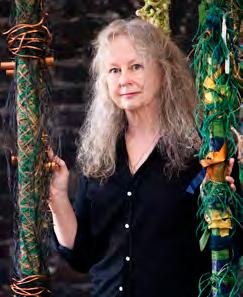
Sherri Cornett is a welded steel, video and mixed media artist, curator and writer living in Billings, Montana. Her degrees in Political Science and Art, her advocacy for human rights and environmental issues and her passion for community building and dialogue frame her art and socially engaged projects. Viewers and participants are invited into her sculptures’ woven layers of texture, material and thought and to ask questions of themselves and the world. She has exhibited and directed projects in China, South Korea, New York, California, Massachusetts, Chicago, Idaho and Montana. Her works can be found in both private and corporate collections.
133
Exhibition Committee
The success of ACCESS: An Ordinary Notion exhibition and its associated events can be attributed to the extraordinary dedication and support of NCWCA’s talented volunteer exhibition team. Thank you!
Laura Abrams - Catalog Editor and Proofreader
Elizabeth Addison - Exhibit Director, Co-curator, Juror, Catalog Design
Karen Gutfreund - Co-curator, Juror, Catalog Design, Outreach
Meghan Lewis MacLeod - Assistant Juror and Curator, Installation Assistance
Chandrika Marla - Social Media Coordinator
Sheila Metcalf-Tobin - Artwork Intake, Installation Assistance
Priscilla Otani - NCWCA Webmaster and Online Gallery
Pamela Pitt - Actionable Insights Coordinator
Mary Shisler - Events, Volunteer at Large
Tanya Wilkinson - Writer, Artwork Intake, Installation Assistance
Additional Thank You’s
NCWCA and the ACCESS: An Ordinary Notion exhibition team extend their gratitude to the following:
Sherri Cornett - Writer, Molly Gonzales and Deborah L. Hughes Interviews
Matthew McKinley, McKinley Art Solutions - Artwork Installation
Priscilla Otani and Michael Yochum - Arc Gallery, San Francisco


www.ncwca.org 134
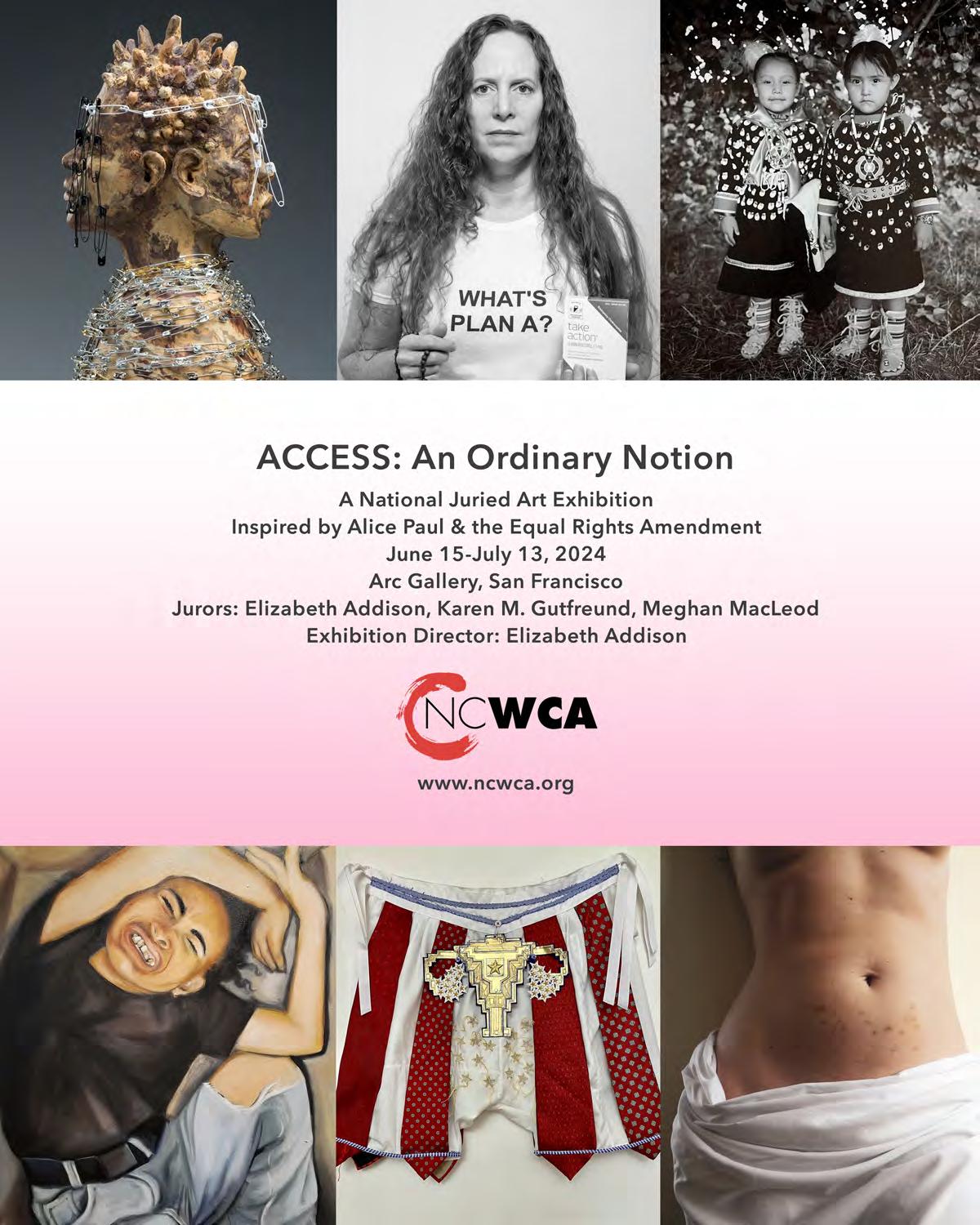












































































































































 The Women and the Vote New York State
The National Susan B. Anthony Museum and House
She Voted Podcast
History of Woman Suffrage
The National Susan B. Anthony Museum and House
The Women and the Vote New York State
The National Susan B. Anthony Museum and House
She Voted Podcast
History of Woman Suffrage
The National Susan B. Anthony Museum and House






